Samsung Electronics Co DV300F Digital Camera User Manual DV300F
Samsung Electronics Co Ltd Digital Camera DV300F
User manual

This user manual includes detailed usage
instructions for your camera. Please read
this manual thoroughly.
User Manual
DV300F
Click a topic
Basic troubleshooting
Quick reference
Contents
Basic functions
Extended functions
Shooting options
Playback/Editing
Wireless network
Settings
Appendixes
Index

1
Keep your camera away from small children and pets.
Keep your camera and all accessories out of the reach of small
children and animals. Small parts may cause choking or serious
injury if swallowed. Moving parts and accessories may present
physical dangers as well.
Do not expose the camera to direct sunlight or high
temperatures for an extended period of time.
Prolonged exposure to sunlight or extreme temperatures can
cause permanent damage to your camera’s internal components.
Avoid covering the camera or charger with blankets or clothes.
The camera may overheat, which may distort the camera or
cause a fire.
If liquid or foreign objects enter your camera, immediately
disconnect all power sources, such as the battery or charger,
and then contact a Samsung service center.
Health and safety information
Always comply with the following precautions and usage tips to avoid dangerous situations and ensure peak performance of your camera.
Warning—situations that could cause injury to yourself or
others
Do not disassemble or attempt to repair your camera.
This may result in electric shock or damage to the camera.
Do not use your camera near flammable or explosive gases and
liquids.
This may cause a fire or explosion.
Do not insert flammable materials into the camera or store these
materials near the camera.
This may cause a fire or electric shock.
Do not handle your camera with wet hands.
This may result in electric shock.
Prevent damage to subjects’ eyesight.
Do not use the flash in close proximity (closer than 1 m/3 ft) to
people or animals. If you use the flash too close to your subject’s
eyes, this can cause temporary or permanent eyesight damage.

2
Caution—situations that could cause damage to your camera
or other equipment
Remove the batteries from your camera when storing it for an
extended period of time.
Installed batteries may leak or corrode over time and cause
serious damage to your camera.
Use only authentic, manufacturer-recommended, Lithium-ion
replacement batteries. Do not damage or heat the battery.
Inauthentic, damaged, or heated batteries may cause a fire or
personal injury.
Use only Samsung-approved batteries, chargers, cables and
accessories.
• Using unauthorized batteries, chargers, cables or accessories
can cause batteries to explode, damage your camera, or cause
injury.
• Samsung is not responsible for damage or injuries caused by
unapproved batteries, chargers, cables or accessories.
Use the battery only for its intended purpose.
Misusing the battery may cause a fire or electric shock.
Do not touch the flash while it fires.
The flash is very hot when fired and may burn your skin.
When you use the AC charger, turn off the camera before you
disconnect the power to the AC charger.
Failing to do so may result in fire or electric shock.
Disconnect the charger from the wall socket when not in use.
Failing to do so may result in fire or electric shock.
Do not use a damaged power supply cord, plug, or loose outlet
when you charge batteries.
This may cause a fire or electric shock.
Do not allow the AC charger to come in contact with the +/-
terminals on the battery.
This may cause a fire or electric shock.
Do not force the camera’s parts or apply pressure to the
camera.
This may cause your camera to malfunction.
Health and safety information

3
Health and safety information
Exercise caution when you connect cables or adapters and
install batteries and memory cards.
If you force the connectors, improperly connect cables, or
improperly install batteries and memory cards, you can damage
ports, connectors, and accessories.
Keep cards with magnetic strips away from the camera case.
Information stored on the card may be damaged or erased.
Never use a damaged charger, battery, or memory card.
This may result in electric shock or camera malfunction or cause
a fire.
Check that the camera is operating properly before use.
The manufacturer takes no responsibility for any loss of files or
damage that may result from camera malfunction or improper
use.
You must plug the small end of the USB cable into your camera.
If the cable is reversed, it may damage your files. The
manufacturer is not responsible for any loss of data.

4
Copyright information
• Microsoft Windows and the Windows logo are
registered trademarks of the Microsoft Corporation.
• Mac is a registered trademark of the Apple Corporation.
• Wi-Fi®, the Wi-Fi CERTIFIED logo, and the Wi-Fi logo are
registered trademarks of the Wi-Fi Alliance.
• Trademarks and trade names used in this manual are
the property of their respective owners.
• Camera specifications or contents of this manual may
be changed without prior notice due to upgrade of
camera functions.
• We recommend using your camera within the country
where you purchase it.
• You are not allowed to reuse or distribute any part of
this manual without prior permission.
• For Open Source License information, refer to the
‘OpenSourceInfo.pdf’ in the provided CD-ROM.
Outline of the User Manual
Basic functions 13
Learn about your camera’s layout, icons, and basic
functions for shooting.
Extended functions 34
Learn how to capture a photo and record a video by
selecting a mode.
Shooting options 57
Learn how to set the options in Shooting mode.
Playback/Editing 84
Learn how to play back photos or videos, and edit
photos or videos. Also, learn how to connect your
camera to your computer, photo printer, TV, HDTV, or
3D TV.
Wireless network 111
Learn to connect to wireless local area networks
(WLANs) and use functions.
Settings 131
Refer to options to configure your camera’s settings.
Appendixes 137
Get information about error messages, specifications,
and maintenance.

5
Indicators used in this manual
Shooting mode Indicator
Smart Auto
S
Program
p
Aperture Priority,
Shutter Priority, Manual
G
DUAL IS
d
Scene
s
Panorama
R
Creative Movie Maker
K
Movie
v
Shooting mode icons
These icons appear in the text when a function is available in a
mode. See the example below.
Note: The s mode may not support functions for all scenes.
For example:
Available in Program,
Aperture Priority,
Shutter Priority,
DUAL IS, and Movie
modes
Icons used in this manual
Icon Function
Additional information
Safety warnings and precautions
[] Camera buttons. For example, [Shutter] represents the
shutter button.
() Page number of related information
The order of options or menus you must select to
perform a step; for example: Select
a
Photo Size
(represents Select
a
, and then select Photo Size).
*Annotation
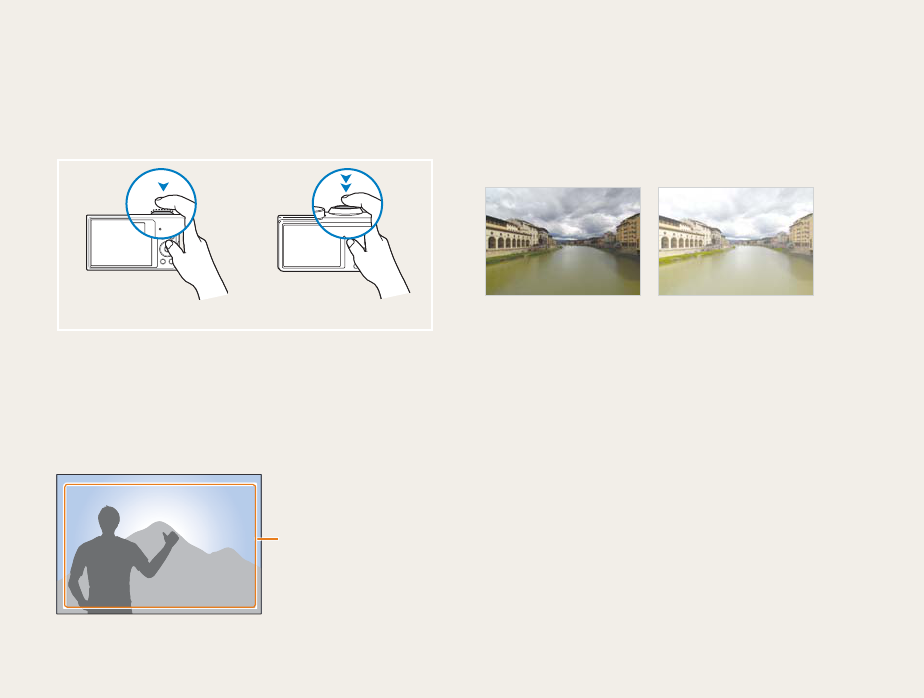
6
Pressing the shutter
• Half-press [Shutter]: press the shutter halfway down
• Press [Shutter]: press the shutter all the way down
Half-press [Shutter] Press [Shutter]
Subject, background, and composition
• Subject: the main object in a scene, such as a person, animal,
or still life
• Background: the objects around the subject
• Composition : the combination of a subject and background
Composition
Background
Subject
Exposure (Brightness)
The amount of light that enters your camera determines the
exposure. You can alter the exposure with shutter speed,
aperture value, and ISO sensitivity. By altering the exposure, your
photos will be darker or lighter.
S
Normal exposure
S
Overexposure (too bright)
Expressions used in this manual
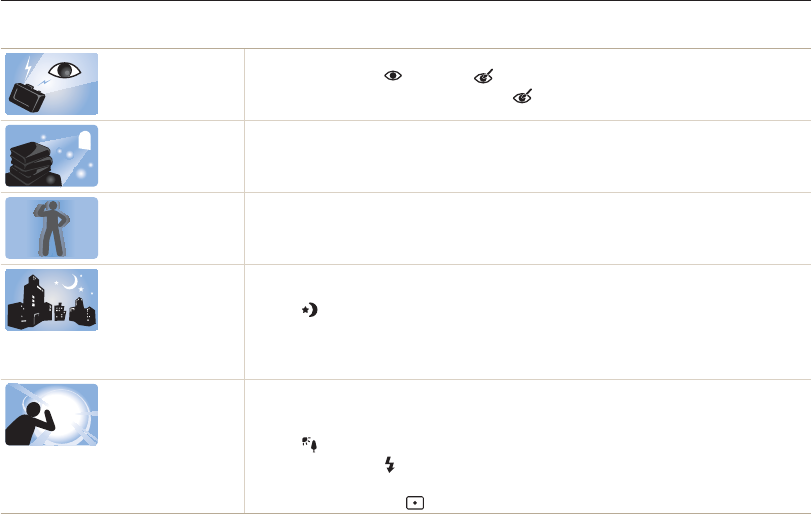
7
Basic troubleshooting
Learn to solve common problems by setting shooting options.
The subject’s eyes
appear red.
Red eye occurs when the subject's eyes reflect light from the camera flash.
•
Set the flash option to Red-eye or Red-eye Fix. (p. 61)
•
If the photo has already been captured, select Red-eye Fix in the edit menu. (p. 98)
Photos have dust
spots.
If dust particles are present in the air, you may capture them in photos when you use the flash.
•
Turn off the flash or avoid capturing photos in a dusty place.
•
Set ISO sensitivity options. (p. 63)
Photos are blurred. Blurring can occur if you capture photos in low light conditions or hold the camera incorrectly.
•
Use the OIS function or half-press [Shutter] to ensure the subject is focused. (p. 32)
•
Use the
d
mode. (p. 47)
Photos are blurred
when shooting at
night.
As the camera tries to let in more light, the shutter speed slows. This can make it difficult to hold the
camera steady long enough to take a clear picture and may result in camera shake.
•
Select Night in
s
mode. (p. 37)
•
Turn on the flash. (p. 61)
•
Set ISO sensitivity options. (p. 63)
•
Use a tripod to prevent your camera from shaking.
Subjects come out
too dark because of
backlighting.
When the light source is behind the subject or when there is a high contrast between light and dark
areas, the subject may appear too dark.
•
Avoid shooting toward the sun.
•
Select Backlight in
s
mode. (p. 37)
•
Set the flash option to Fill in. (p. 61)
•
Adjust the exposure. (p. 73)
•
Set the metering option to Spot if a subject is in the center of the frame. (p. 74)

8
Quick reference
Capturing photos of people
• s
mode > Beauty Shot
f
40
•
Red-eye/Red-eye Fix (to prevent or correct
red-eye)
f
61
•
Face Detection
f
68
•
Self-Portrait
f
69
Capturing photos at night or in
the dark
• s
mode > Night, Sunset, Dawn
f
37
•
Flash options
f
61
•
ISO sensitivity (to adjust the sensitivity to light)
f
63
Capturing action photos
• h
mode
f
45
•
High-speed burst mode
f
78
•
Precapture
f
79
Adjusting the exposure
(brightness)
• s
mode > HDR
f
38
•
ISO sensitivity(to adjust the sensitivity to light)
f
63
•
EV (to adjust exposure)
f
73
•
Metering
f
74
•
Bracket
f
79
Capturing panoramic action
photos
• R
mode > Action Panorama
f
50
Capturing photos of text,
insects, or flowers
• s
mode > Text
f
37
•
Macro
f
64
Capturing photos of scenery
• s
mode > Landscape
f
37
• R
mode
f
48
Capturing 3D photos
• s
mode > 3D Photo
f
38
• R
mode > 3D Panorama
f
48
Applying effects to photos
• s
mode > Zooming Shot
f
41
•
Smart Filter effects
f
81
•
Image Adjust (to adjust Contrast, Sharpness,
or Saturation)
f
83
Reducing camera shake
•
Optical Image Stabilization (OIS)
f
31
• d
mode
f
47
•
Viewing files by category in Smart Album
f
88
•
Viewing files as thumbnails
f
89
•
Deleting all files on the memory card
f
90
•
Viewing files as a slide show
f
93
•
Viewing files on a TV, HDTV, or 3D TV
f
101
•
Connecting your camera to a computer
f
104
•
Adjusting sound and volume
f
133
•
Adjusting the brightness of the display
f
133
•
Changing the display language
f
134
•
Setting the date and time
f
134
•
Before contacting a service center
f
148

9
Contents
Extended functions
.......................................................... 34
Using the Smart Auto mode ........................................ 35
Using the Scene mode ................................................ 37
Using the 3D Photo mode ........................................... 38
Using the HDR mode ................................................. 38
Using the Magic Frame mode ..................................... 39
Using the Beauty Shot mode ....................................... 40
Using the Zooming Shot mode .................................... 41
Using the Program mode ............................................ 42
Using the Aperture Priority, Shutter Priority,
or Manual mode .......................................................... 43
Using the Aperture Priority mode .................................. 44
Using the Shutter Priority mode .................................... 45
Using the Manual mode .............................................. 46
Using the DUAL IS mode ............................................ 47
Using the Panorama mode ......................................... 48
Using the 2D or 3D Panorama mode ........................... 48
Using the Action Panorama mode ................................ 50
Using the Movie mode ................................................ 51
Recording high-speed videos ...................................... 53
Using the Smart Scene Detection mode ...................... 54
Using the Creative Movie Maker mode ...................... 55
Making a movie with the Creative Movie Maker ............. 55
View a movie made in Creative Movie Maker mode ....... 56
Basic functions
................................................................. 13
Unpacking ................................................................... 14
Camera layout ............................................................. 15
Inserting the battery and memory card ....................... 18
Charging the battery and turning on your camera ...... 19
Charging the battery ................................................... 19
Turning on your camera .............................................. 19
Performing the initial setup ......................................... 20
Learning icons ............................................................. 22
Selecting options or menus ........................................ 23
Using [MENU] ............................................................ 23
Using [Fn] .................................................................. 25
Setting the display and sound .................................... 26
Setting the display type ............................................... 26
Setting the sound ....................................................... 27
Capturing photos ......................................................... 28
Zooming .................................................................... 29
Reducing camera shake (OIS) ..................................... 31
Tips for getting a clearer photo ................................... 32

10
Contents
Shooting options
.............................................................. 57
Selecting a resolution and quality ............................... 58
Selecting a resolution .................................................. 58
Setting the photo quality .............................................. 59
Using the timer ............................................................ 60
Shooting in the dark .................................................... 61
Preventing red-eye ..................................................... 61
Using the flash ........................................................... 61
Adjusting the ISO sensitivity ......................................... 63
Changing the camera’s focus ..................................... 64
Using macro .............................................................. 64
Using auto focus ........................................................ 64
Focusing on a selected area ....................................... 66
Using tracking auto focus ............................................ 66
Adjusting the focus area .............................................. 67
Using Face Detection .................................................. 68
Detecting faces .......................................................... 68
Capturing a self portrait shot ........................................ 69
Capturing a smile shot ................................................ 69
Detecting eye blinking ................................................. 70
Using Smart Face Recognition .................................... 70
Registering faces as your favorites (My Star) ................. 71
Adjusting brightness and color ................................... 73
Adjusting the exposure manually (EV) ........................... 73
Changing the metering option ...................................... 74
Selecting a White Balance setting ................................ 75
Using burst modes ...................................................... 78
Capturing photos in the High-speed burst mode ........... 78
Capturing photos in the Precapture mode .................... 79
Capturing bracketed photos ........................................ 79
Applying effects/Adjusting images .............................. 81
Applying Smart Filter effects ........................................ 81
Adjusting your photos ................................................. 83

11
Contents
Playback/Editing
............................................................... 84
Viewing photos or videos in Playback mode .............. 85
Starting Playback mode .............................................. 85
Viewing photos .......................................................... 91
Playing a video ........................................................... 94
Editing a photo ............................................................ 96
Resizing photos ......................................................... 96
Rotating a photo ......................................................... 96
Applying Smart Filter effects ........................................ 97
Adjusting your photos ................................................. 98
Creating a print order (DPOF) ....................................... 99
Viewing files on a TV, HDTV, or 3D TV ....................... 101
Transferring files to your Windows computer ........... 102
Transferring files with Intelli-studio ............................... 103
Transferring files by connecting the camera
as a removable disk .................................................. 105
Disconnecting the camera (for Windows XP) ............... 106
Transferring files to your Mac computer ................... 107
Printing photos with a PictBridge photo printer ....... 108
Wireless network
............................................................ 109
Connecting to a WLAN and configuring
network settings ........................................................ 110
Connecting to a WLAN ............................................. 110
Setting network options ............................................ 111
Manually setting the IP address ................................. 111
Network connection tips ........................................... 112
Sending photos via email .......................................... 113
Changing email settings ............................................ 113
Sending photos via email .......................................... 115
Entering text ............................................................. 116
Using photo or video sharing websites .................... 117
Accessing a website ................................................ 117
Uploading photos or videos ....................................... 117
Using a smart phone as a remote shutter release .... 118
Viewing photos or videos on
a AllShare-enabled TV ............................................... 120
Viewing photos or videos on a TV I ............................. 120
Viewing photos or videos on a TV II ............................ 122
Sending or receiving photos or videos with
another camera ......................................................... 123
Sending photos or videos to another camera .............. 123
Receiving photos or videos from another camera ........ 123
Using Auto Backup to send photos or videos .......... 125
Installing the program for Auto Backup on your PC ...... 125
Sending photos or videos to a PC ............................. 125
Sending photos or videos to a Blu-ray disc Player ....... 126
About the Wakeup on LAN (WOL) feature ................ 127

12
Contents
Settings
........................................................................... 129
Settings menu ........................................................... 130
Accessing the settings menu .................................... 130
Sound ..................................................................... 131
Display .................................................................... 131
Settings ................................................................... 132
Appendixes
..................................................................... 135
Error messages ......................................................... 136
Camera maintenance ................................................ 137
Cleaning your camera ............................................... 137
Using or storing the camera ...................................... 138
About memory cards ................................................ 139
About the battery ...................................................... 142
Before contacting a service center ........................... 146
Camera specifications ............................................... 149
Glossary ..................................................................... 153
FCC notice ................................................................. 158
Index .......................................................................... 159

Unpacking
………………………………… 14
Camera layout
……………………………… 15
Inserting the battery and memory card
… 18
Charging the battery and turning
on your camera
…………………………… 19
Charging the battery
……………………… 19
Turning on your camera
………………… 19
Performing the initial setup
……………… 20
Learning icons
……………………………… 22
Selecting options or menus
……………… 23
Using [MENU]
…………………………… 23
Using [Fn]
………………………………… 25
Setting the display and sound
…………… 26
Setting the display type
…………………… 26
Setting the sound
………………………… 27
Capturing photos
………………………… 28
Zooming
………………………………… 29
Reducing camera shake (OIS)
…………… 31
Tips for getting a clearer photo
…………… 32
Basic functions
Learn about your camera’s layout, icons, and basic functions for shooting.
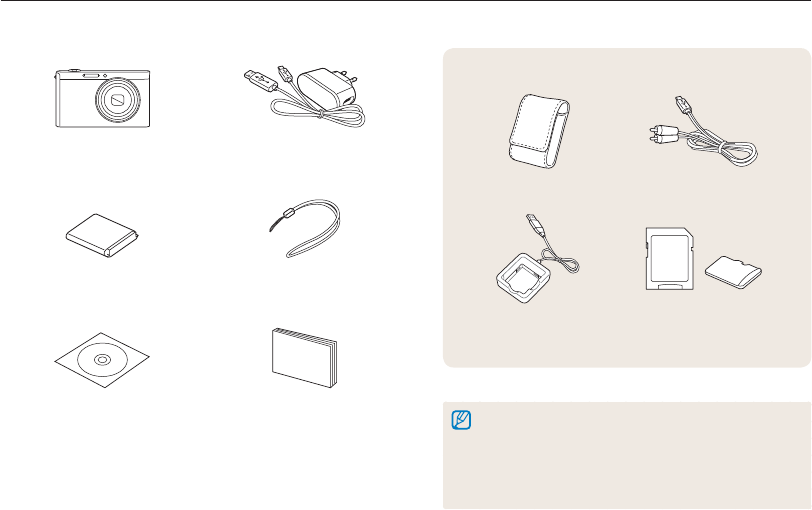
Basic functions
14
Unpacking
The following items are included in your product box.
Camera AC adapter/
USB cable
Rechargeable battery Strap
User Manual CD-ROM Quick Start Guide
Optional accessories
Camera case A/V cable
Battery charger Memory card/
Memory card adapter
•
The illustrations may differ slightly from the items shipped with your
product.
•
The items included in the box may differ depending on the model.
•
You can purchase optional accessories at a retailer or a Samsung
service center. Samsung is not responsible for any problems
caused by using unauthorized accessories.
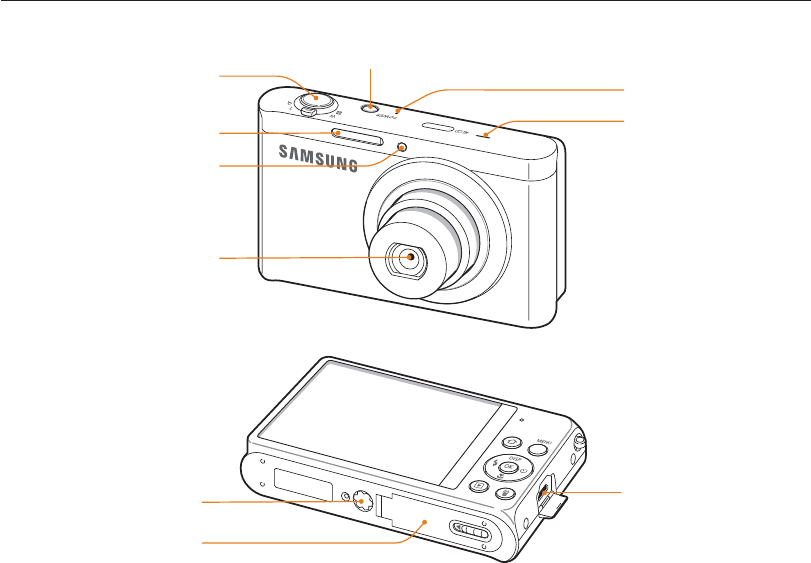
Basic functions
15
Camera layout
Before you start, familiarize yourself with your camera’s parts and their functions.
USB and A/V port
Accepts USB cable and A/V cable
Battery chamber cover
Insert a memory card and battery
Tripod mount
Speaker
Shutter button
POWER button
AF-assist light/Timer lamp
Flash
Lens
Microphone
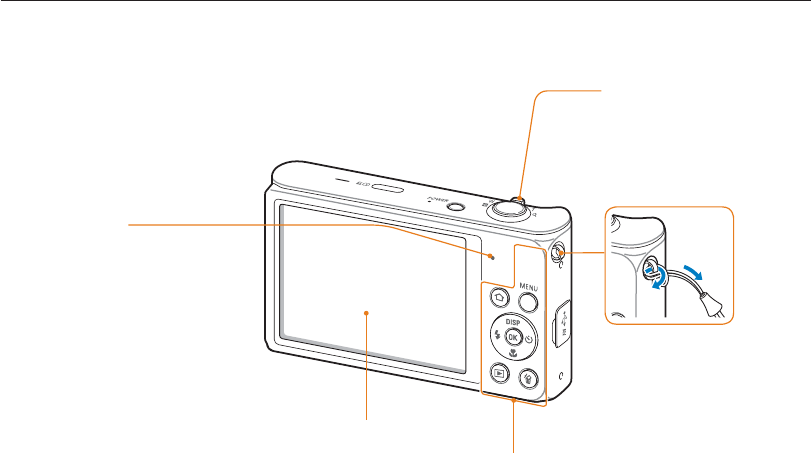
Basic functions
16
Camera layout
Status lamp
•
Blinking: When the camera is
saving a photo or video, being read
by a computer or printer, or when
the image is out of focus
•
Steady: When the camera is
connected to a computer, charging
the battery, or when the image is
in focus
Zoom button
•
In Shooting mode: Zoom in or out
•
In Playback mode: Zoom in on part
of a photo or view files as thumbnails,
or adjust the volume
Display
Attaching the strap
Buttons
(p. 17)
x
y
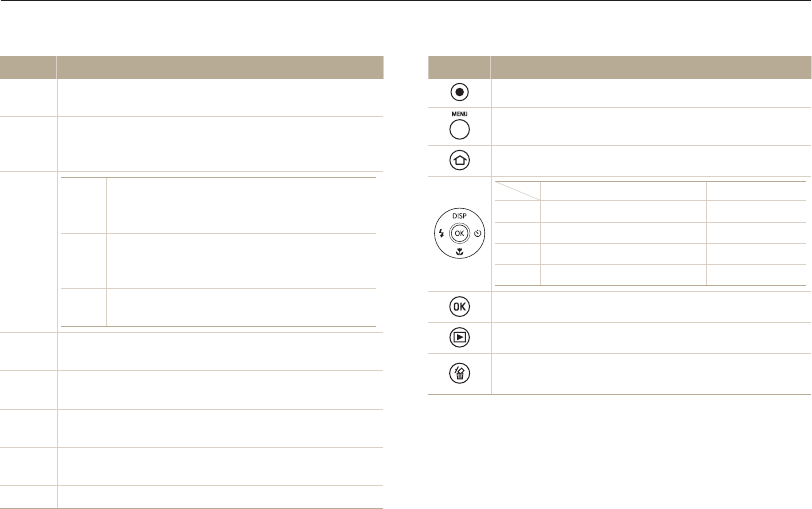
Basic functions
17
Camera layout
Mode dial
Icon Description
T
Smart Auto: Capture a photo with a scene mode selected
automatically by the camera.
p
Program: Capture a photo by setting options except the
shutter speed and aperture value which the camera sets
automatically.
G
A
Aperture Priority: The camera selects a shutter
speed based on the aperture value you have
set manually.
h
Shutter Priority: The camera selects an
aperture value based on the shutter speed you
have set manually.
M
Manual: Adjust various camera settings
including shutter speed and aperture value.
d
DUAL IS: Capture a photo with options that reduce
camera shake.
s
Scene: Capture a photo with options preset for a specific
scene.
R
Panorama: Capture and combine a series of photos to
create a panoramic image.
K
Creative Movie Maker: Create movies from photos and
videos stored on the memory card.
v
Movie: Customize settings to record a video.
Buttons
Button Description
Start recording a video.
Access options or menus.
Access the Home screen.
Basic functions Other functions
D
Change the display option. Move up
c
Change the macro option. Move down
F
Change the flash option. Move left
t
Change the timer option. Move right
Confirm the highlighted option or menu.
Enter Playback mode.
•
Access options in Shooting mode.
•
Delete files in Playback mode.
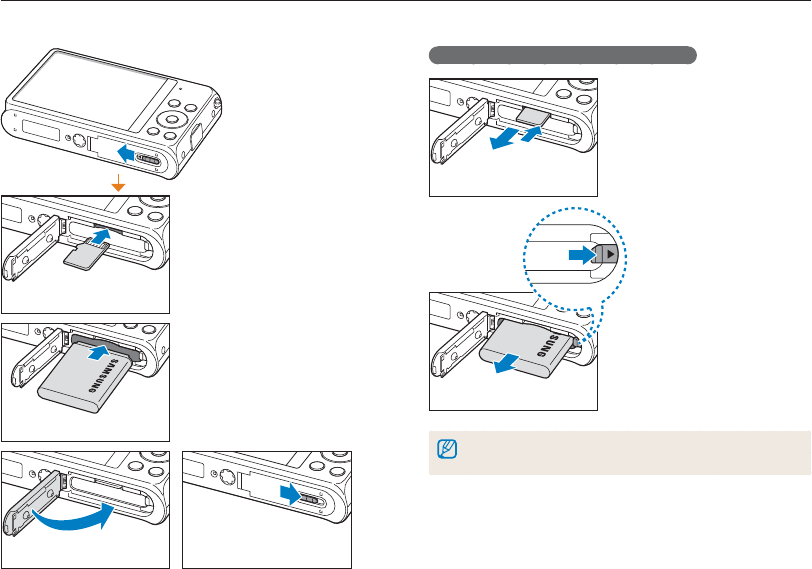
Basic functions
18
Inserting the battery and memory card
Learn how to insert the battery and an optional memory card into the camera.
Removing the battery and memory card
Memory card
Push the card gently until it
disengages from the camera,
and then pull it out of the slot.
Rechargeable battery
Battery lock
Slide the lock to the right to
release the battery.
You can use the internal memory for temporary storage if a memory card is
not inserted.
Memory card
Insert a memory card with the
gold-colored contacts facing
up.
Rechargeable battery
Insert the battery with the
Samsung logo facing up.
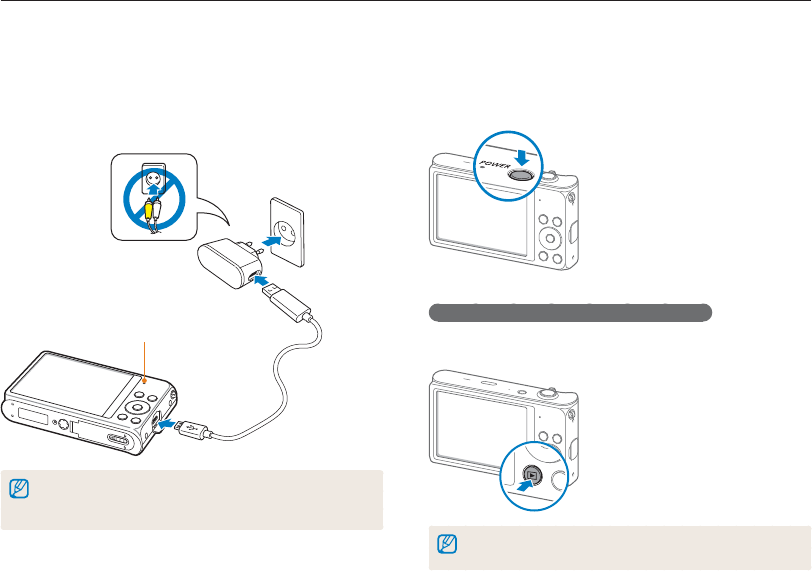
Basic functions
19
Charging the battery and turning on your camera
Turning on your camera
Press [POWER] to turn your camera on or off.
• The initial setup screen appears when you turn on the camera
for the first time. (p. 20)
Turning on your camera in Playback mode
Press [P]. The camera turns on and immediately accesses
Playback mode.
If you turn on your camera by pressing and holding [
P
] for about 5 seconds,
the camera does not emit any sounds.
Charging the battery
Before you use the camera for the first time, you must charge the
battery. Plug the small end of the USB cable into your camera,
and then plug the other end of the USB cable into the AC
adapter.
Indicator light
•
Red light on: Charging
•
Red light off: Fully charged
Use only the AC adapter and USB cable supplied with your camera. If you
use another AC adapter (such as SAC-48), the camera battery may not
charge or work properly.
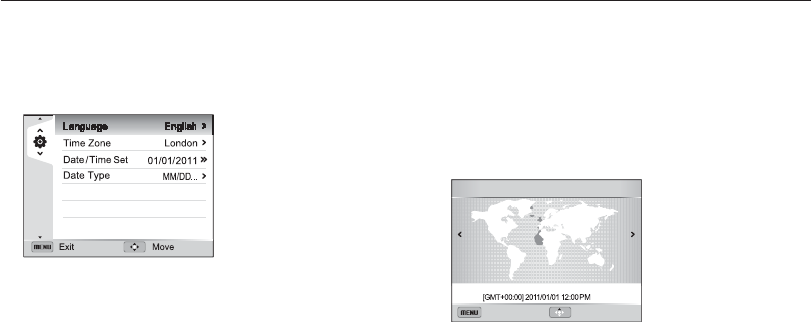
Basic functions
20
Performing the initial setup
When you turn on your camera for the first time, the initial setup screen appears. Follow the steps below to configure the camera’s basic
settings.
4
Press [
D
/
c
] to select Home, and then press [
o
].
•
When you travel to another country, select Visit, and then
select a new time zone.
5
Press [
F
/
t
] to select a time zone, and then press [
o
].
•
To set daylight-savings time, press [
D
].
Back DST
Time Zone : Home
London
1
Verify that Language is highlighted, and then press
[
t
] or [
o
].
2
Press [
D
/
c
/
F
/
t
] to select a language, and then
press [
o
].
3
Press [
c
] to select Time Zone, and then press [
t
] or
[
o
].
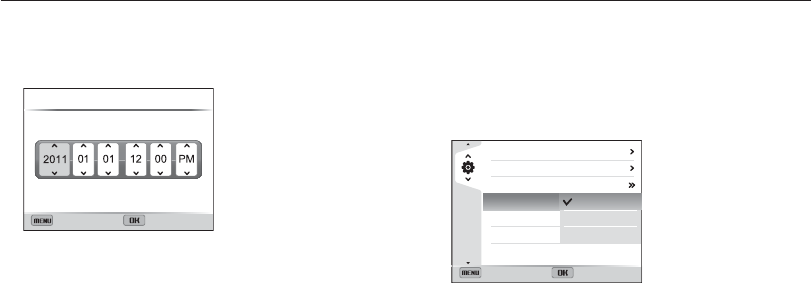
Basic functions
21
Performing the initial setup
6
Press [
c
] to select Date/Time Set, and then press
[
t
] or [
o
].
Exit Set
Date/Time Set
Year Month Day Hour Min
•
The screen may differ depending on the language selected.
7
Press [
F
/
t
] to select an item.
8
Press [
D
/
c
] to set the date and time, and then
press [
o
].
9
Press [
c
] to select Date Type, and then press [
t
] or
[
o
].
10
Press [
D
/
c
] to select a date type, and then press
[
o
].
Language
Time Zone
Date/Time Set
Date Type
English
London
2011/01/01
Back Set
YYYY/MM/DD
MM/DD/YYYY
DD/MM/YYYY
•
The default date type may differ depending on the language
selected.
11
Press [
m
] to switch to Shooting mode.
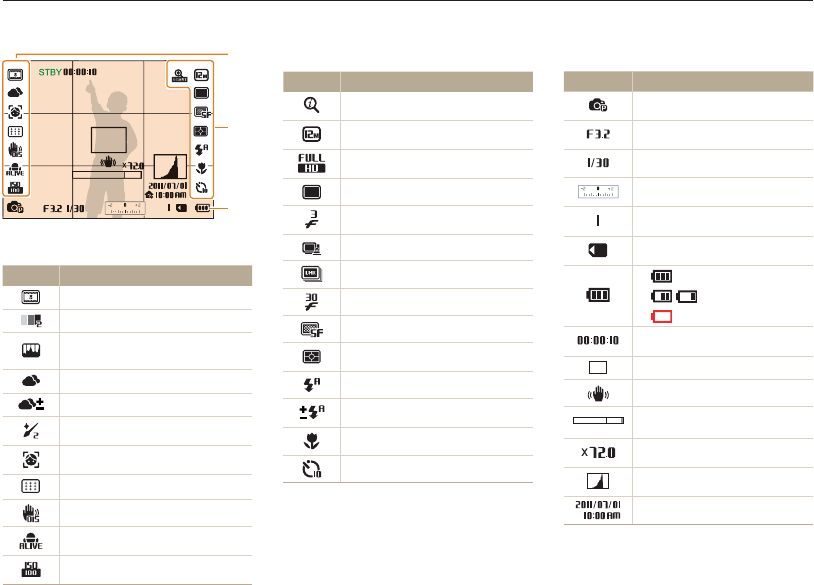
Basic functions
22
3
Shooting information
Icon Description
Shooting mode
Aperture value
Shutter speed
Exposure value
Available number of photos
Memory card inserted
•
: Fully charged
•
: Partially charged
•
: Empty (Recharge)
Available recording time
Auto focus frame
Camera shake
Zoom indicator
Zoom ratio
Histogram (p. 26)
Current time and date
Learning icons
The icons the camera displays on the screen change according to the mode you select or the options you set.
2
Shooting options (right)
Icon Description
Smart zoom on
Photo resolution
Video resolution
Single shot mode
High-speed burst mode
Precapture mode
Bracket mode
Frame rate
Photo quality
Metering
Flash
Flash intensity adjusted
Auto focus option
Timer
1
Shooting options (left)
Icon Description
Smart filter
Face tone
Image adjustment (contrast,
sharpness, and saturation)
White balance
White balance adjusted
Face retouch
Face detection
Focus area
Optical Image Stabilization (OIS)
Sound Alive on
ISO sensitivity
1
2
3

Basic functions
23
Selecting options or menus
To select an option or a menu, press [m] or [f].
Going back to the previous menu
Press [
m
] again to go back to the previous menu.
Half-press [Shutter] to return to Shooting mode.
Using [MENU]
To select options, press [m], and then rotate the navigation
button or press [D/c/F/t] or [o].
1
In Shooting mode, press [
m
].
2
Rotate the navigation button or press [
D
/
c
/
F
/
t
]
to scroll to a menu or an option.
or
3
Press [
o
] to confirm the highlighted option or menu.
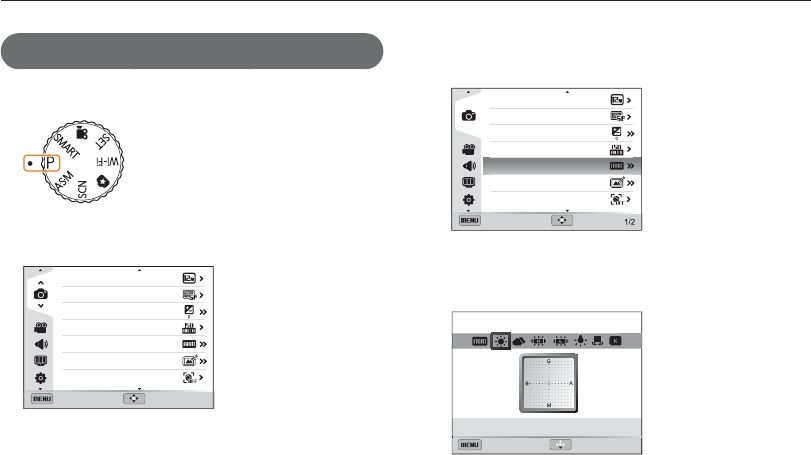
Basic functions
24
Selecting options or menus
4
Rotate the navigation button or press [
D
/
c
] to select
White Balance, and then press [
t
] or [
o
].
Photo Size
Quality
EV
ISO
White Balance
Smart Filter
Face Detection
Exit Move
5
Rotate the navigation button or press [
F
/
t
] to select a
White Balance option.
Back Adjust
White Balance : Daylight
6
Press [
o
] to save your settings.
7
Press [
m
] to return to Shooting mode.
For example, to select a White Balance option
in Program mode:
1
Rotate the mode dial to
p
.
2
Press [
m
].
Exit Move
Photo Size
Quality
EV
ISO
White Balance
Smart Filter
Face Detection
3
Rotate the navigation button or press [
D
/
c
] to select
a
, and then press [
t
] or [
o
].
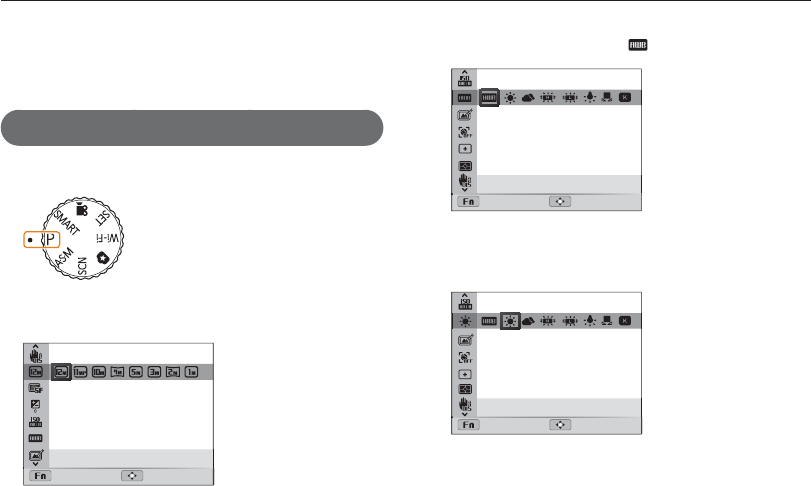
Basic functions
25
Selecting options or menus
Using [Fn]
You can access shooting options by pressing [f], but some
options are not available.
For example, to select a White Balance option
in Program mode:
1
Rotate the mode dial to
p
.
2
Press [
f
].
Photo Size : 4096X3072
Exit Move
3
Press [
D
/
c
] to scroll to .
White Balance : Auto WB
Exit Move
4
Rotate the navigation button or press [
F
/
t
] to select a
White Balance option.
White Balance : Daylight
Exit Move
5
Press [
o
] to save your settings.
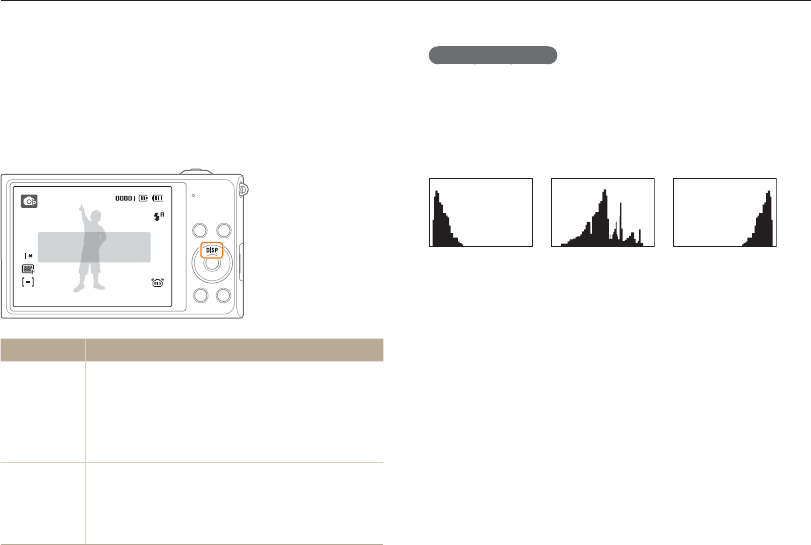
Basic functions
26
Setting the display and sound
Learn how to change the basic display information and sound settings.
About histograms
A histogram is a graph that illustrates how light is distributed
in your photo. If the histogram has a high peak on the left, the
photo is underexposed and will appear dark. A peak on the
right of the graph means that the photo is overexposed and will
appear washed out. The height of the peaks is related to color
information. The more of a particular color, the taller the peak.
S
Under-exposed
S
Well-exposed
S
Over-exposed
Setting the display type
You can select a display type for the Shooting or Playback mode.
Each type displays different shooting or playback information.
See the table below.
Press [
D
] repeatedly to change the display type.
Show all photographic
information.
Mode Description
Shooting
•
Hide all information about shooting.
•
Hide information about shooting, except the
information on the bottom line.
•
Display all information about shooting.
•
Display histogram.
Playback
•
Hide all information about the current file.
•
Display information about the current file, except
the shooting settings and histogram.
•
Display all information about the current file.

Basic functions
27
Setting the display and sound
Setting the sound
Turn on or off the sound your camera emits when you perform
functions.
1
In Shooting or Playback mode, press [
m
].
2
Select
U
Beep Sound.
3
Select an option.
Option Description
Off The camera does not emit any sounds.
On The camera emits sounds.
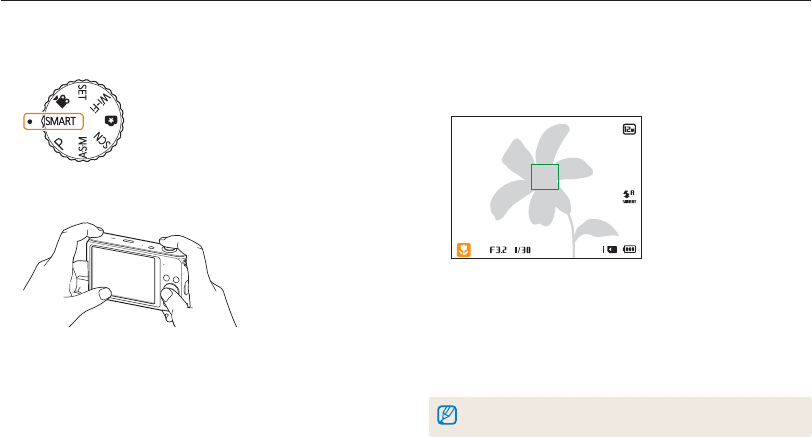
Basic functions
28
Capturing photos
Learn how to capture photos easily and quickly in Smart Auto mode.
3
Half-press [Shutter] to focus.
•
A green frame means the subject is in focus.
•
A red frame means the subject is out of focus.
4
Press [Shutter] to capture a photo.
5
Press [
P
] to view the captured photo.
•
To delete the photo, press [
f
], and then select Yes.
6
Press [
P
] to return to Shooting mode.
See page 32 for tips to get clearer photos.
1
Rotate the mode dial to
T
.
2
Align your subject in the frame.
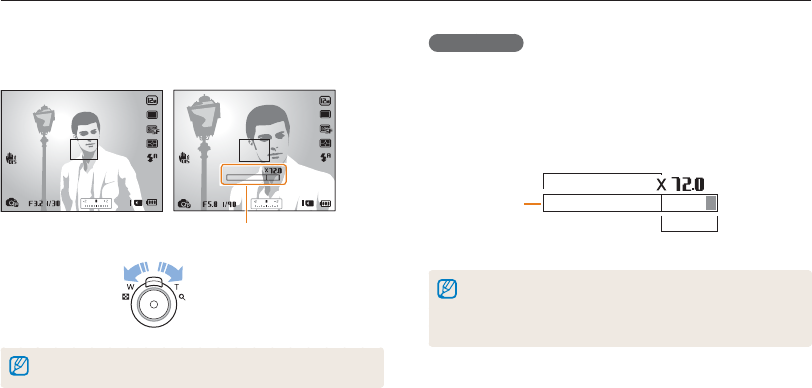
Basic functions
29
Capturing photos
Digital zoom
The Digital zoom is supported by default in Shooting mode. If you
zoom in on a subject in Shooting mode and the zoom indicator
is in the digital range, your camera is using the Digital zoom. By
using both the 18X Optical zoom and 4X Digital zoom, you can
zoom in up to 72 times.
Digital range
Zoom indicator
Optical range
•
The Digital zoom is not available with the Face detection option, Smart
Filter effect, Tracking AF option, Burst option, or Manual Focus.
•
If you capture a photo with the Digital zoom, the photo quality may be
lower than normal.
pAhMs
Zooming
You can capture close-up photos by adjusting the zoom.
Zoom out Zoom in
Zoom ratio
The wider you rotate the zoom button, the faster the camera zooms in or out.
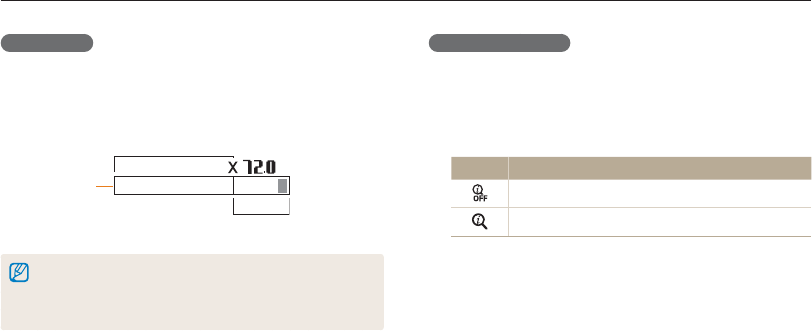
Basic functions
30
Capturing photos
Smart zoom
You can use 24X Smart zoom which lets you zoom in with less
degradation of picture quality than the Optical zoom and Digital
zoom. By using both the Smart zoom and Digital zoom, you can
zoom in up to 72 times.
Smart range
Digital range
Zoom indicator
•
Smart zoom is not available with the Face detection option, Smart
Filter effect, Tracking AF option, Burst option, or Manual Focus.
•
If you capture a photo with the Smart zoom, the photo quality may be
lower than normal.
pAhM
Setting Smart zoom
1
In Shooting mode, press [
m
].
2
Select
a
Smart Zoom.
3
Select an option.
Icon Description
Off: The Smart zoom is deactivated.
On: The Smart zoom is activated.

Basic functions
31
Capturing photos
Reducing camera shake (OIS)
Reduce camera shake optically in Shooting mode.
S
Before correction
S
After correction
1
In Shooting mode, press [
m
].
2
Select
a
or
V
OIS.
3
Select an option.
Icon Description
Off: OIS is deactivated.
On: OIS is activated.
pAhMsv •
OIS may not function properly when:
- you move your camera to follow a moving subject
- you use the Digital zoom
- there is too much camera shake
- the shutter speed is slow (for example, when you capture night
scenes)
- the battery is low
- you capture a close-up shot
•
If you use the OIS function with a tripod, your images may be blurred
by the vibration of the OIS sensor. Deactivate the OIS function when
you use a tripod.
•
If the camera is hit or dropped, the display will be blurry. If this occurs,
turn off the camera, and then turn it on again.
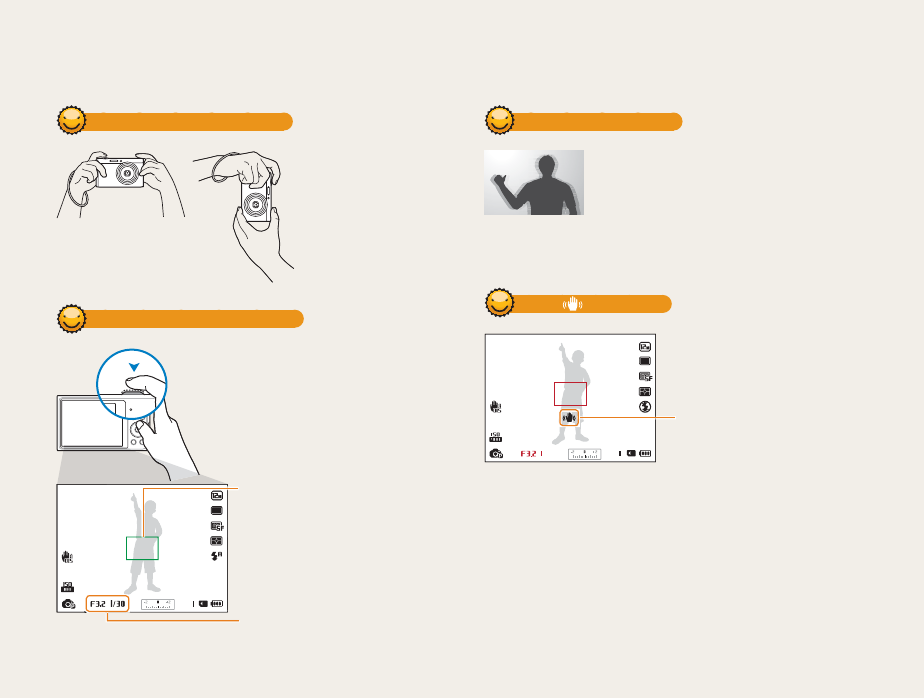
Basic functions
32
Holding your camera correctly
Ensure nothing is
blocking the lens,
flash, or microphone.
Half-pressing the shutter button
Half-press [Shutter] and adjust the
focus. The camera adjusts the focus and
exposure automatically.
The camera sets the aperture value
and shutter speed automatically.
Focus frame
•
Press [Shutter] to capture the photo
if the focus frame appears in green.
•
Change the composition and
half-press [Shutter] again if the
focus frame appears in red.
Reducing camera shake
•
Set the Optical Image Stabilization option to
reduce camera shake optically. (p. 31)
•
Select the
d
mode to reduce camera shake
both optically and digitally. (p. 47)
When is displayed
Camera shake
When you shoot in the dark, avoid setting the flash option to Slow
Sync or Off. The aperture remains open longer and it may be harder to
hold the camera steady long enough to capture a clear photo.
•
Use a tripod or set the flash option to Fill in. (p. 61)
•
Set ISO sensitivity options. (p. 63)
Tips for getting a clearer photo
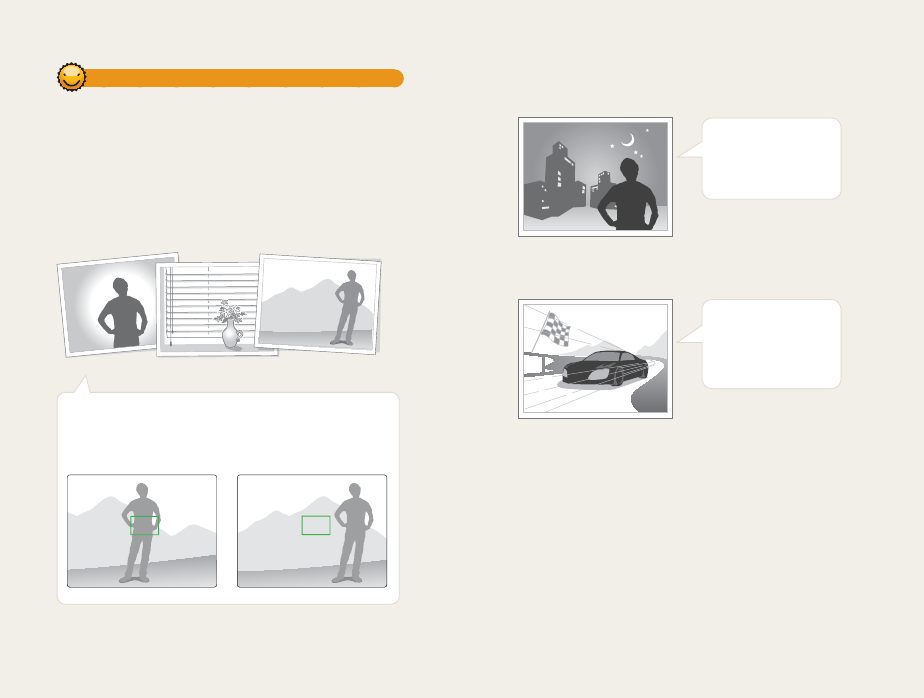
Basic functions
33
Preventing your subject from being out of focus
It may be difficult to get your subject in focus when:
-
there is little contrast between the subject and background (for
example, when your subject is wearing clothing that is similar in color
to the background)
-
the light source behind the subject is too bright
-
the subject is shiny or reflective
-
the subject includes horizontal patterns, such as blinds
-
the subject is not positioned in the center of the frame
•
When you capture photos in low light
Turn on the flash.
(p. 61)
•
When subjects are moving rapidly
Use the High-speed
burst mode or
Precapture function.
(p. 78)
Using the focus lock
Half-press [Shutter] to focus. When the subject is in focus,
you can reposition the frame to change the composition.
When you are ready, press [Shutter] to capture your photo.

Extended functions
Learn how to capture a photo and record a video by selecting a mode.
Using the Smart Auto mode
……………… 35
Using the Scene mode
…………………… 37
Using the 3D Photo mode
……………… 38
Using the HDR mode
…………………… 38
Using the Magic Frame mode
…………… 39
Using the Beauty Shot mode
…………… 40
Using the Zooming Shot mode
…………… 41
Using the Program mode
………………… 42
Using the Aperture Priority,
Shutter Priority, or Manual mode
………… 43
Using the Aperture Priority mode
………… 44
Using the Shutter Priority mode
………… 45
Using the Manual mode
………………… 46
Using the DUAL IS mode
………………… 47
Using the Panorama mode
……………… 48
Using the 2D or 3D Panorama mode
…… 48
Using the Action Panorama mode
……… 50
Using the Movie mode
…………………… 51
Recording high-speed videos
…………… 53
Using the Smart Scene Detection mode
… 54
Using the Creative Movie Maker mode
… 55
Making a movie with the Creative
Movie Maker
……………………………… 55
View a movie made in
Creative Movie Maker mode
……………… 56
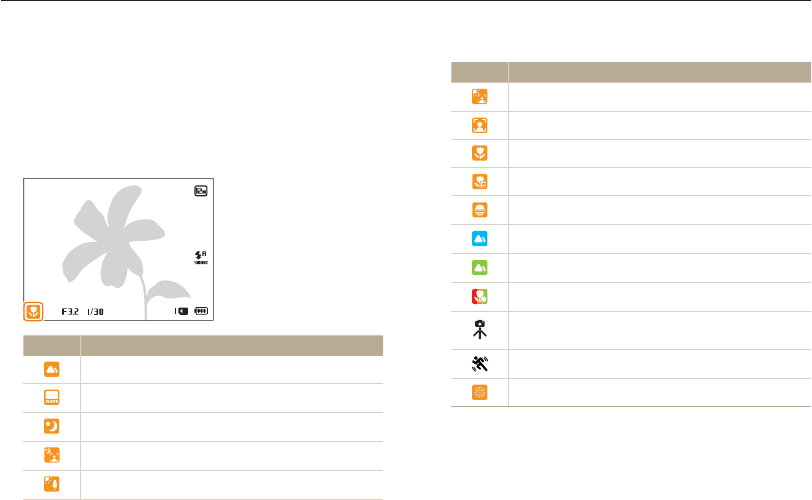
Extended functions
35
Using the Smart Auto mode
In Smart Auto mode, your camera automatically chooses the appropriate camera settings based on the type of scene it detects.
The Smart Auto mode is helpful if you are not familiar with the camera settings for various scenes.
Icon Description
Portraits with backlighting
Portraits
Close-up photos of objects
Close-up photos of text
Sunsets
Blue skies
Forested areas
Close-up photos of colorful subjects
Camera is stabilized or on a tripod (when shooting in
the dark)
Actively moving subjects
Fireworks (when using a tripod)
3
Half-press [Shutter] to focus.
4
Press [Shutter] to capture the photo.
1
Rotate the mode dial to
T
.
2
Align your subject in the frame.
•
The camera automatically selects a scene. An appropriate
scene icon appears at the bottom left of the screen.
The icons are listed below.
Icon Description
Landscapes
Scenes with bright white backgrounds
Landscapes at night (when the flash is off)
Portraits at night
Landscapes with backlighting

Extended functions
36
Using the Smart Auto mode
•
If the camera does not recognize an appropriate scene mode, it uses
the default settings for the
T
mode.
•
Even if it detects a face, the camera may not select a portrait mode
depending on the subject's position or lighting.
•
The camera may not select the correct scene depending on the
shooting conditions, such as camera shake, lighting, or distance to
the subject.
•
Even if you use a tripod, the camera may not detect the mode if
the subject is moving.
•
In
T
mode, the camera consumes more battery power, because
it changes settings often to select appropriate scenes.
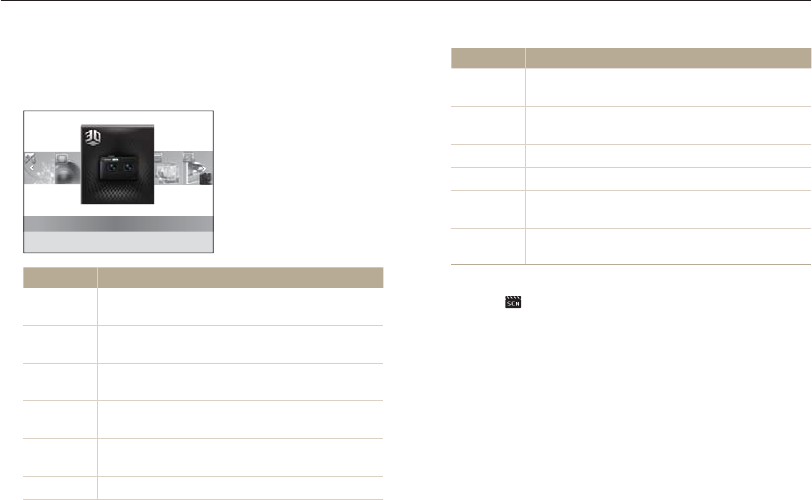
Extended functions
37
Using the Scene mode
In Scene mode, you can capture a photo with options that are preset for a specific scene.
Option Description
Text Clearly capture text from printed or electronic
documents.
Sunset Capture scenes at sunset, with natural-looking reds
and yellows.
Dawn Capture scenes at sunrise.
Backlight Capture backlit subjects.
Beach &
Snow
Reduce underexposure of subjects caused by
sunlight reflected from sand or snow.
Zooming
Shot Capture scenes with blurred edges.
•
To change a scene mode, press [
m
], and then
select . You can select any of the scenes listed.
3
Align your subject in the frame, and then half-press
[Shutter] to focus.
4
Press [Shutter] to capture the photo.
1
Rotate the mode dial to
s
.
2
Select a scene.
3D Photo
Option Description
3D Photo Capture scenes with a 3D effect (the 3D effect
works only on a 3D TV or 3D monitor).
HDR Capture scenes with emphasis on mid-tones, by
minimizing the dark and bright areas.
Magic
Frame Capture scenes with various frame effects.
Beauty
Shot
Capture a portrait with options to hide facial
imperfections.
Night Capture scenes at night or in low lighting (using a
tripod is recommended).
Landscape Capture still-life scenes and landscapes.

Extended functions
38
Using the Scene mode
Using the HDR mode
In HDR(High Dynamic Range) mode, your camera captures two
photos with different exposures, and then overlays the bright area
of the underexposed photo and the dark area of the overexposed
photo. You can capture photos with soft, rich colors.
S
Without HDR
effect
S
With HDR
effect
1
Rotate the mode dial to
s
.
2
Select HDR.
3
Align your subject in the frame, and then half-press
[Shutter] to focus.
4
Press [Shutter] to capture the photo.
•
The camera captures 2 photos, and then automatically
merges them into a single photo.
Using the 3D Photo mode
In 3D Photo mode, you can capture scenes with a 3D effect.
1
Rotate the mode dial to
s
.
2
Select 3D Photo.
3
Align your subject in the frame, and then half-press
[Shutter] to focus.
4
Press [Shutter] to capture the photo.
•
The camera captures 2 photos in both JPEG and MPO file
formats.
•
In 3D Photo mode, the resolution is automatically set to .
•
In 3D Photo mode, some shooting options are not available.
•
You can view an MPO file that supports the 3D effect only on an
MPO-compatible display, such as a 3D TV or 3D monitor. On your
camera's display, you can view only JPEG files.
•
Use proper 3D glasses when you view an MPO file on a 3D TV or
3D monitor.
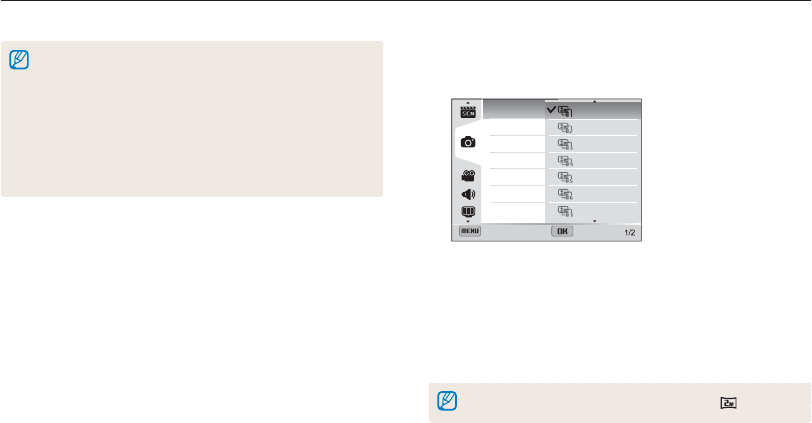
Extended functions
39
Using the Scene mode
•
The HDR effect may be affected by camera shake, lighting, movement
of the subject, and the shooting environment.
•
You cannot use the flash when you use the HDR mode.
•
It may take longer to save a photo using the HDR mode.
•
When you use the HDR mode, the preview image on the screen and
the captured photo may appear slightly larger than a photo captured
without this effect.
•
When you capture a moving subject using the HDR mode, an
afterimage may appear.
Using the Magic Frame mode
In Magic Frame mode, you can apply various frame effects to
your photos. The shape and the feel of the photos will change
according to the frame you select.
1
Rotate the mode dial to
s
.
2
Select Magic Frame.
3
Press [
m
].
4
Select
a
Frame.
5
Select an option.
Frame
Quality
OIS
Wall Art
Old Film
Ripple
Full Moon
Old Record
Magazine
Sunny Day
Back Set
6
Press [
m
] to return to Shooting mode.
7
Align your subject in the frame, and then half-press
[Shutter] to focus.
8
Press [Shutter] to capture the photo.
In Magic Frame mode, the resolution is automatically set to .
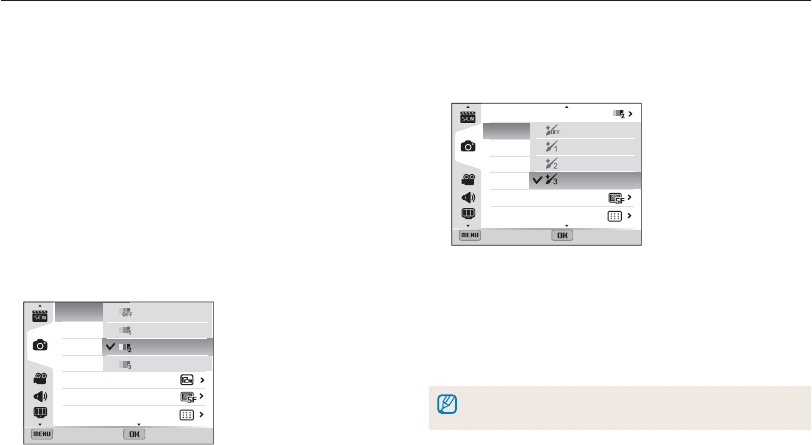
Extended functions
40
Using the Scene mode
Using the Beauty Shot mode
In Beauty Shot mode, you can capture a portrait with options to
hide facial imperfections.
1
Rotate the mode dial to
s
.
2
Select Beauty Shot.
3
Press [
m
].
4
Select
a
Face Tone.
5
Select an option.
•
For example, increase the face tone setting to make skin
appear lighter.
Back Set
Face Tone
Face Retouch
Face Detection
Smart FR Edit
Photo Size
Quality
Focus Area
Off
Level 1
Level 2
Level 3
6
Select Face Retouch.
7
Select an option.
•
For example, increase the face retouch setting to hide more
imperfections.
Back Set
Face Tone
Face Retouch
Face Detection
Smart FR Edit
Photo Size
Quality
Focus Area
Off
Level 1
Level 2
Level 3
8
Press [
m
] to return to Shooting mode.
9
Align your subject in the frame, and then half-press
[Shutter] to focus.
10
Press [Shutter] to capture the photo.
When you use the Beauty Shot mode, the focus distance will be set to Auto
Macro.

Extended functions
41
Using the Scene mode
Using the Zooming Shot mode
In Zooming Shot mode, you can emphasize the center of a photo
by blurring the edges.
S
Without Zooming Shot effect
S
With Zooming Shot effect
1
Rotate the mode dial to
s
.
2
Select Zooming Shot.
3
Align your subject in the frame, and then half-press
[Shutter] to focus.
4
Press [Shutter] to capture the photo.
In Zooming Shot mode, the resolution is automatically set to or below.
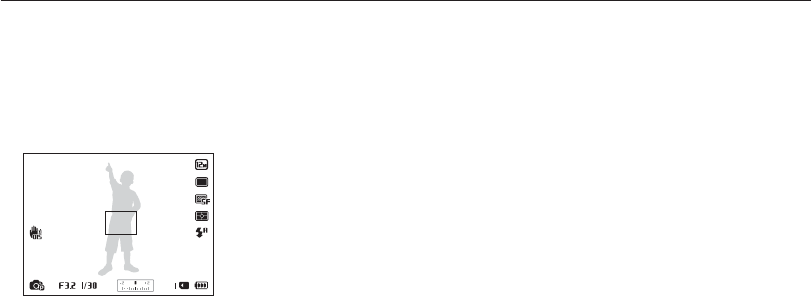
Extended functions
42
Using the Program mode
In Program mode, you can set most options, except the shutter speed and aperture value, which the camera sets automatically.
1
Rotate the mode dial to
p
.
2
Set the desired options.
(For a list of options, refer to "Shooting options" starting
on page 57.)
3
Align your subject in the frame, and then half-press
[Shutter] to focus.
4
Press [Shutter] to capture the photo.
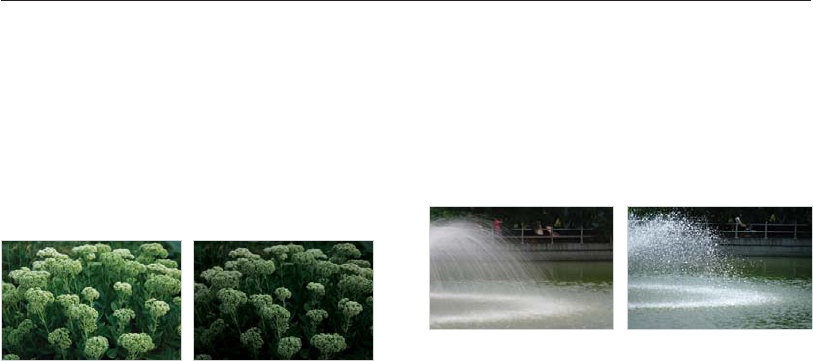
Extended functions
43
Using the Aperture Priority, Shutter Priority, or Manual mode
Adjust the aperture value or shutter speed to control the exposure of your photos. You can use these options in the Aperture Priority,
Shutter Priority, and Manual modes.
Shutter speed
Shutter speed, which is an important factor in the brightness of a
photo, refers to the amount of time it takes to open and close the
shutter. A slow shutter speed allows more time to let light in.
All things being equal, photos are brighter, but fast moving
objects tend to blur. On the other hand, a fast shutter speed
allows less time to let light in. Photos are darker, but objects in
motion are captured more clearly.
S
Slow shutter speed
S
Fast shutter speed
Aperture value
The aperture is a hole that lets light into the camera. The aperture
housing contains thin, metal plates that open and close, widening
or narrowing the aperture, and controlling the amount of light that
enters the camera. The size of the aperture is closely related to
the brightness of a photo: the larger the aperture, the brighter the
photo; the smaller the aperture, the darker the photo.
Note that the larger the aperture value, the smaller the aperture
size. For example, an aperture set to 5.6 is larger than an
aperture set to 11.
S
Small aperture value (The size
of the aperture is large.)
S
Large aperture value (The size
of the aperture is small.)

Extended functions
44
Using the Aperture Priority, Shutter Priority, or Manual mode
4
Set options.
(For a list of options, refer to “Shooting options” starting
on page 57.)
5
Align your subject in the frame, and then half-press
[Shutter] to focus.
6
Press [Shutter] to capture the photo.
Using the Aperture Priority mode
The Aperture Priority mode allows you to set the aperture value
manually while the camera automatically selects an appropriate
shutter speed.
1
Rotate the mode dial to
G
.
2
Select Aperture Priority.
•
To select another mode when the mode dial is set to
G
,
press [
m
], and then select a mode.
3
Press [
o
], and then rotate the navigation button or
press [
D
/
c
] to adjust the aperture value.
•
See page 43 for more information about the aperture value.
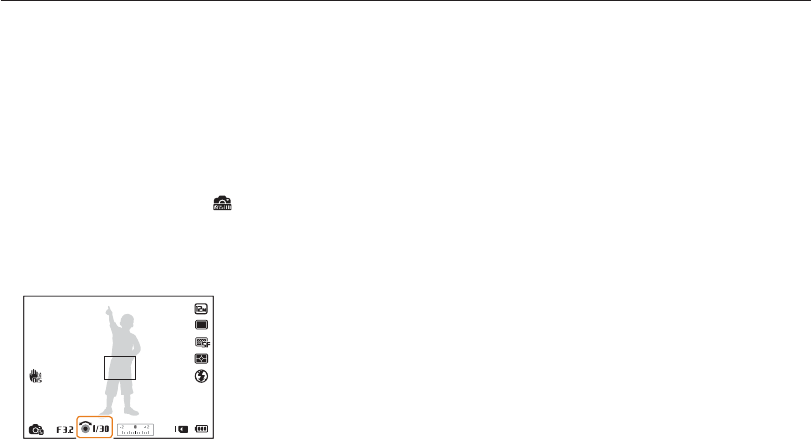
Extended functions
45
Using the Aperture Priority, Shutter Priority, or Manual mode
4
Set options.
(For a list of options, refer to “Shooting options” starting
on page 57.)
5
Align your subject in the frame, and then half-press
[Shutter] to focus.
6
Press [Shutter] to capture the photo.
Using the Shutter Priority mode
The Shutter Priority mode allows you to set the shutter speed
manually while the camera automatically selects an appropriate
aperture value.
1
Rotate the mode dial to
G
.
2
Select Shutter Priority.
•
To select another mode when the mode dial is set to
G
,
press [
m
], and then select a mode.
3
Press [
o
], and then rotate the navigation button or
press [
D
/
c
] to adjust the shutter speed.
•
See page 43 for more information about the shutter speed.

Extended functions
46
Using the Aperture Priority, Shutter Priority, or Manual mode
Using the Manual mode
The Manual mode allows you to adjust both the aperture value
and the shutter speed manually.
1
Rotate the mode dial to
G
.
2
Select Manual.
•
To select another mode when the mode dial is set to
G
,
press [
m
], and then select a mode.
3
Press [
o
] to select the aperture value or shutter speed.
4
Rotate the navigation button or press [
D
/
c
] to
adjust the aperture value or shutter speed.
5
Set options.
(For a list of options, refer to “Shooting options” starting
on page 57.)
6
Align your subject in the frame, and then half-press
[Shutter] to focus.
7
Press [Shutter] to capture the photo.

Extended functions
47
Using the DUAL IS mode
Reduce camera shake and prevent blurred photos with Optical and Digital Image Stabilization functions.
S
Before correction
S
After correction
1
Rotate the mode dial to
d
.
2
Align your subject in the frame, and then half-press
[Shutter] to focus.
3
Press [Shutter] to capture the photo.
•
The Digital zoom and Smart zoom are not available in
d
mode.
•
The camera will correct photos optically only when the light source is
brighter than fluorescent light.
•
If your subject is moving rapidly, the photo may be blurry.
•
Set the Optical Image Stabilization option to reduce camera shake in
different shooting modes. (p. 31)
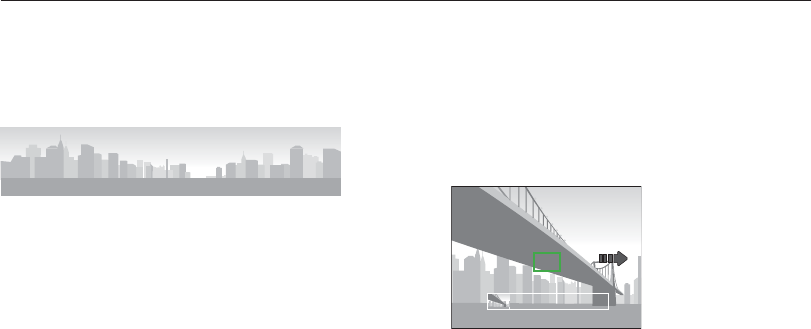
Extended functions
48
Using the Panorama mode
In Panorama mode, you can capture a wide panoramic scene in a single photo. Capture and combine a series of photos to create a
panoramic image.
7
With [Shutter] pressed, slowly move the camera in the
direction that will let it capture the rest of the panorama.
•
In 3D Panorama mode, you can capture a scene only in
horizontal directions.
•
When the viewfinder is aligned with the next scene, the
camera captures the next photo automatically.
8
When you are finished, release [Shutter].
•
When you have captured all the necessary shots, the camera
combines them into one panoramic photo.
Using the 2D or 3D Panorama mode
In Panorama mode, you can capture a normal or 3D panoramic
photo.
S
Shooting example
1
Rotate the mode dial to
R
.
2
Press [
m
].
3
Select
a
Panorama Live Panorama or
3D Panorama.
4
Press [
m
] to return to Shooting mode.
5
Align your subject in the frame, and then half-press
[Shutter] to focus.
•
Align the camera with the far left or the far right, or very top or
bottom, of the scene you want to capture.
6
Press and hold [Shutter] to start shooting.

Extended functions
49
Using the Panorama mode
•
For best results when capturing panoramic photos, avoid the
following:
- moving the camera too quickly or too slowly
- moving the camera too little to capture the next image
- moving the camera at irregular speeds
- shaking the camera
- changing the camera direction while capturing a photo
- shooting in dark places
- capturing moving subjects nearby
- shooting conditions where the brightness or color of light is
changing
•
Selecting Panorama mode will disable the digital and optical zoom
functions. If you select Panorama mode while the lens is zoomed in,
the camera automatically zooms out to the default position.
•
In Panorama mode, some shooting options are not available.
•
The camera may stop shooting due to the shooting composition or
movement within the scene.
•
In Panorama mode, your camera may not capture the last scene in
its entirety if you stop moving the camera exactly where you want the
scene to end. To capture the entire scene, move your camera slightly
beyond the point where you want the scene to end.
•
In 3D Panorama mode, your camera may not capture the very
beginning or end of a scene due to the nature of the 3D effect. To
capture the entire scene, move slightly beyond the beginning and end
points you want to capture.
•
In 3D Panorama mode, photos are captured in both JPEG and MPO
file formats.
•
You can view an MPO file that supports the 3D effect only on an
MPO-compatible display, such as 3D TV or 3D monitor. On your
camera's display, you can view only JPEG files.
•
Use proper 3D glasses when you view an MPO file on a 3D TV or
3D monitor.

Extended functions
50
Using the Panorama mode
Using the Action Panorama mode
In Action Panorama mode, you can capture and combine a series
of photos of a moving subject.
S
Shooting example
1
Rotate the mode dial to
R
.
2
Press [
m
].
3
Select
a
Panorama Action Panorama.
4
Press [
m
] to return to Shooting mode.
5
Align your subject in the frame, and then half-press
[Shutter] to focus.
•
Align the camera with the far left or the far right side of the
scene you want to capture.
6
Press and hold [Shutter] to start shooting.
7
With [Shutter] pressed, slowly move the camera in the
direction that will let it capture the rest of the panorama.
•
If there is more than one moving subject, the camera may not
recognize the correct subject.
•
If subjects are outside of the guide frame while capturing, the
camera does not capture the movement of the subjects.
8
When you are finished, release [Shutter].
•
The camera automatically combines the shots into one photo.
•
For best results when capturing panoramic photos, avoid the
following:
- moving the camera too quickly or too slowly
- moving the camera too little to capture the next image
- moving the camera at irregular speeds
- shaking the camera
- changing the camera direction while capturing a photo
- shooting in dark places
- capturing moving subjects nearby
- shooting conditions where the brightness or color of light is
changing
•
The camera may take time to save panoramic photos.
•
In Action Panorama mode, some shooting options are not available.
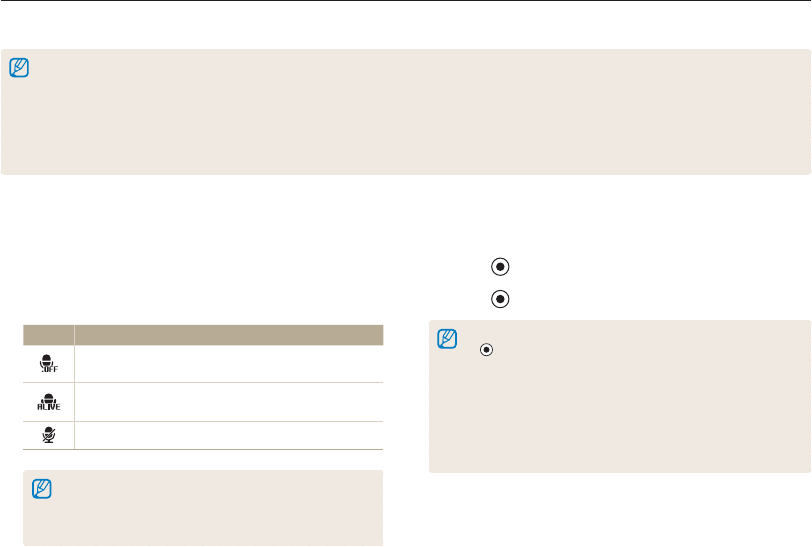
Extended functions
51
Using the Movie mode
In Movie mode, you can customize settings to record full HD videos of up to 20 minutes in length. The camera saves recorded videos as
MP4 (H.264) files.
•
H.264 (MPEG-4 part10/AVC) is a high-compression video format established by the international standards organizations ISO-IEC and ITU-T.
•
Some memory cards may not support high definition recording. If your card does not, set a lower resolution.
•
Memory cards with slow writing speeds will not support high-resolution videos and high-speed videos. To record high-resolution or high-speed videos, use memory
cards with faster write speeds.
•
If you activate the OIS function while recording a video, the camera may record the operating sound of the OIS function.
•
If you use the zoom function when recording a video, the camera may record the noise of the zoom operating. To decrease zoom noise, use the Sound Alive
function. See Steps 3 and 4 below.
5
Set desired options. (For a list of options, refer to
"Shooting options" starting on page 57.)
6
Press (Video recording) to start recording.
7
Press (Video recording) again to stop recording.
•
You can start recording a video in some modes by pressing
(Video recording) without having to rotate the mode dial to
v
.
•
The video frame size may appear smaller while you are recording a
video depending on the video resolution and frame rate.
•
If you perform no operations for approximately 3 minutes while
recording a video, the screen will become dim. To activate the screen,
perform any camera operation. If you operate POWER, Zoom, Shutter,
or Video recording button, the camera will carry out the assigned
function, even when the screen is dim.
1
Rotate the mode dial to
v
.
2
Press [
m
].
3
Select
V
Voice.
4
Select a Sound Alive option.
Icon Description
Sound Alive Off: Turn off the Sound Alive function to
record the zoom noise.
Sound Alive On: Turn on the Sound Alive function to
reduce the zoom noise.
Mute: Do not record sounds.
•
Do not block the microphone when you use the Sound Alive
function.
•
Recordings made with Sound Alive may differ from actual
sounds.
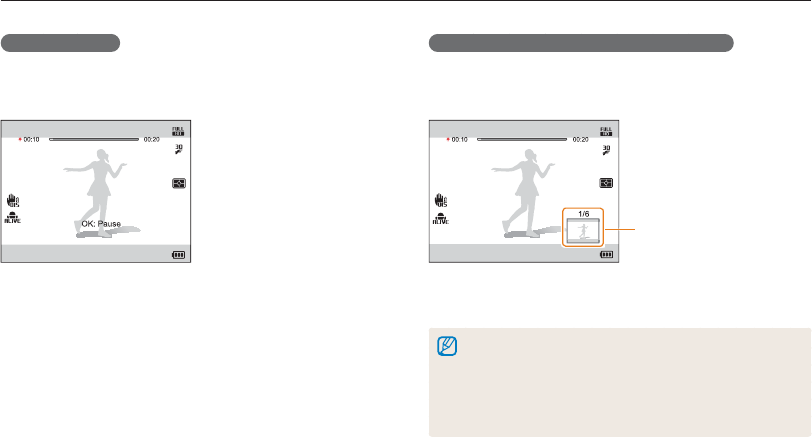
Extended functions
52
Using the Movie mode
Pause recording
The camera allows you to temporarily pause a video while
recording. With this function, you can record separate scenes as
a single video.
• Press [o] to pause while recording.
• Press [o] to resume.
Capturing still images while recording a video
You can capture still images while recording a video without
switching to the photo shooting modes (up to 6 photos). This
feature is available only when you use a memory card.
Images captured while
recording a video
• Press [Shutter] to capture images while recording a video.
• Captured images will be saved automatically.
•
Captured images will be automatically resized, depending on the size
of the recorded video.
•
You cannot capture still images while recording high-speed videos.
•
You cannot capture still images when you pause the video recording.
•
The quality of images captured while recording a video may be lower
than those captured normally.

Extended functions
53
Using the Movie mode
Recording high-speed videos
You can record high-speed videos by setting frame rates.
High-speed videos will be played in slow motion at 30 FPS,
regardless of the frame rate of the video.
•
Memory cards with slow write speeds do not support high-speed
videos.
•
You cannot set Smart Filter effects or Smart Scene Detection mode
when recording high-speed videos.
•
The camera does not record audio when recording high-speed
videos.
•
The image quality of high-speed video may be lower than normal
speed video.
1
Rotate the mode dial to
v
.
• v
mode only allows you to record a high-speed video.
2
Press [
Q
], and then select a frame rate.
Icon Descripion
440fps: Record 440 frames per second
(for up to 10 seconds).
250fps: Record 250 frames per second
(for up to 10 seconds).
30fps: Record 30 frames per second
(for up to 20 minutes). 30fps is not a high-speed
recording option.
3
Press (Video recording) to start recording.
4
Press (Video recording) again to stop recording.
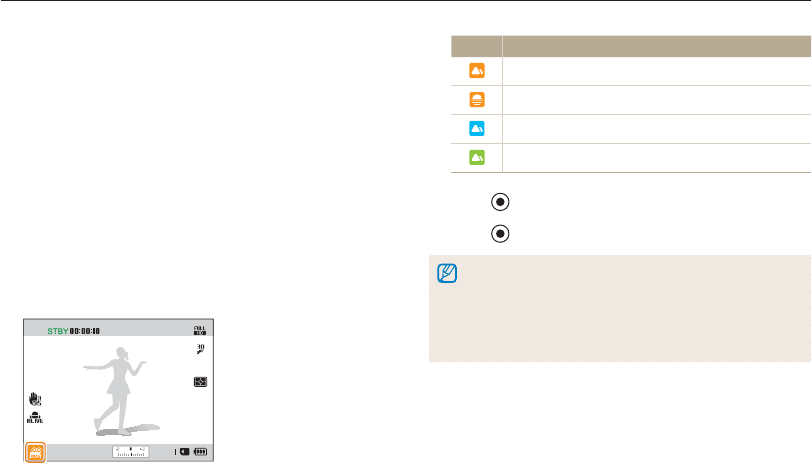
Extended functions
54
Using the Movie mode
Using the Smart Scene Detection mode
In Smart Scene Detection mode, your camera automatically
chooses the appropriate camera settings based on the scene it
has detected.
1
Rotate the mode dial to
v
.
2
Press [
m
].
3
Select
V
Smart Scene Detection On.
4
Press [
m
] to return to Shooting mode.
5
Align your subject in the frame.
•
The camera automatically selects a scene. An appropriate
scene icon will appear at the bottom left of the screen.
Icon Description
Landscapes
Sunsets
Blue skies
Forested areas
6
Press (Video recording) to start recording.
7
Press (Video recording) again to stop recording.
•
If the camera does not recognize an appropriate scene mode, it uses
the default settings for the Smart Scene Detection mode.
•
The camera may not select the correct scene depending on the
shooting conditions, such as camera shake, lighting, and distance to
the subject.
•
Smart Filter effects are not available in Smart Scene Detection mode.
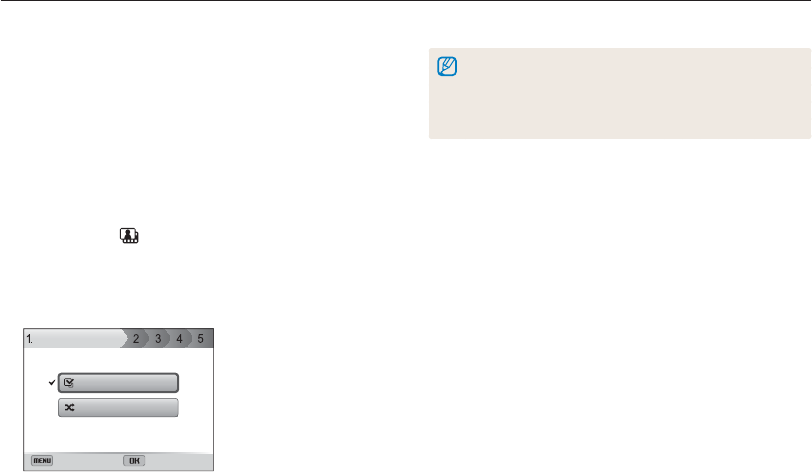
Extended functions
55
Making a movie with the Creative Movie
Maker
1
Rotate the mode dial to
K
.
2
Select + Movie Creation.
3
Select Select, and then select files.
•
You must select at least 2 files.
•
If you select a folder, every photo in the folder will be selected.
•
If you select a video, every photo captured while recording
the video will be selected.
•
Select Shuffle to let the camera select photos and videos
randomly. The movie cannot exceed 2 minutes 30 seconds
in length.
Select
Shuffle
Back Set
Select image
•
You cannot select photos captured in Panorama mode, videos made
in Creative Movie Maker mode, videos recorded with some Smart
Filter effects (Miniature, Vignetting, Half Tone Dot, Sketch, or
Fish-eye), or some high-speed videos (440fps).
•
You can select up to 60 photos and 10 videos.
4
Press [
f
] to confirm the selection.
5
Press [
t
] to select Theme, and then select a theme.
6
Press [
t
] to select Music, and then select music.
7
Press [
t
] to select Movie Size, and then select a movie
size.
8
Press [
t
] to select Creation, and then select Creation
Start.
•
If your camera does not have enough available memory to
store the movie, you cannot select Creation Start. Delete
files from the memory card to make more memory available.
(p. 90)
•
If the pop-up message appears when you select Creation
Start, select a smaller movie size in the Movie Size option.
•
The video rendering may take longer depending on the
number and size of the selected files.
•
Press [
m
] to cancel the video rendering.
Using the Creative Movie Maker mode
In the Creative Movie Maker mode, you can easily make movies from the photos and videos stored on your memory card.

Extended functions
56
Using the Creative Movie Maker mode
View a movie made in Creative Movie Maker
mode
1
Rotate the mode dial to
K
.
2
Press [
D
/
c
] to select a movie.
3
Press [
o
] to play the movie.
To view the movie in Playback mode, press [
P
]. (p. 85)

Selecting a resolution and quality
………… 58
Selecting a resolution
…………………… 58
Setting the photo quality
………………… 59
Using the timer
……………………………… 60
Shooting in the dark
……………………… 61
Preventing red-eye
……………………… 61
Using the flash
…………………………… 61
Adjusting the ISO sensitivity
……………… 63
Changing the camera’s focus
…………… 64
Using macro
……………………………… 64
Using auto focus
………………………… 64
Focusing on a selected area
……………… 66
Using tracking auto focus
………………… 66
Adjusting the focus area
………………… 67
Using Face Detection
……………………… 68
Detecting faces
…………………………… 68
Capturing a self portrait shot
……………… 69
Capturing a smile shot
…………………… 69
Detecting eye blinking
…………………… 70
Using Smart Face Recognition
…………… 70
Registering faces as your favorites
(My Star)
………………………………… 71
Adjusting brightness and color
…………… 73
Adjusting the exposure manually (EV)
…… 73
Changing the metering option
…………… 74
Selecting a White Balance setting
………… 75
Using burst modes
………………………… 78
Capturing photos in the High-speed
burst mode
……………………………… 78
Capturing photos in the
Precapture mode
………………………… 79
Capturing bracketed photos
……………… 79
Applying effects/Adjusting images
……… 81
Applying Smart Filter effects
……………… 81
Adjusting your photos
…………………… 83
Shooting options
Learn how to set the options in Shooting mode.
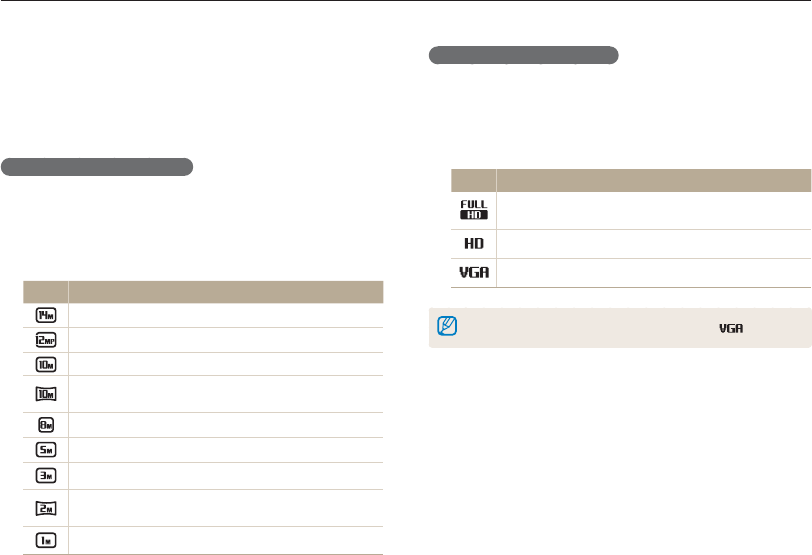
Shooting options
58
Selecting a resolution and quality
Learn how to change the image resolution and quality settings.
Setting the video resolution
1
In Shooting mode, press [
m
].
2
Select
V
Movie Size.
3
Select an option.
Icon Description
1280X720: High-quality HD files to play back on an
HDTV.
640X480: HD files to play back on an HDTV.
320X240: SD files to play back on an analog TV.
If a memory card is not inserted, the camera supports only .
Selecting a resolution
As you increase the resolution, your photo or video will include
more pixels, so it can be printed on larger paper or displayed on
a larger screen. When you use a high resolution, the file size will
also increase.
Setting the photo resolution
1
In Shooting mode, press [
m
].
2
Select
a
Photo Size.
3
Select an option.
Icon Description
4320X3240: Print on an A1 paper.
4320X2880: Print on an A2 paper in wide ratio (3:2).
3648X2736: Print on an A2 paper.
4320X2432: Print on an A2 paper in panorama ratio
(16:9) or play back on an HDTV.
2832X2832: Print on an A4 paper.
2592X1944: Print on an A4 paper.
1984X1488: Print on an A5 paper.
1920X1080: Print on an A5 paper in panorama ratio
(16:9) or play back on an HDTV.
1024X768: Attach to an email.
SpAhMds
SpAhMdsv

Shooting options
59
Selecting a resolution and quality
Setting the photo quality
Set the photo quality setting. Higher image quality settings will
result in larger file sizes. The camera compresses and saves the
photos you capture in the JPEG format.
1
In Shooting mode, press [
m
].
2
Select
a
Quality.
3
Select an option.
Icon Description
Super Fine: Capture photos in super high quality.
Fine: Capture photos in high quality.
Normal: Capture photos in normal quality.
pAhMds
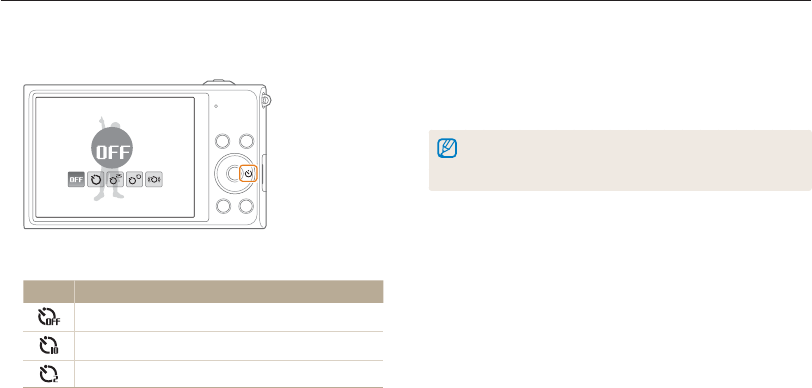
Shooting options
60
Using the timer
Learn how to set the timer to delay shooting.
SpAhMdsv
3
Press [Shutter] to start the timer.
•
The AF-assist light/timer lamp blinks. The camera will
automatically capture a photo after the specified time has
elapsed.
•
Press [Shutter] or [
t
] to cancel the timer.
•
Depending on the Face Detection options you selected, the timer
function may not be available.
1
In Shooting mode, press [
t
].
Timer : Off
2
Select an option.
Icon Description
Off: The timer is not active.
10 Sec: Capture a photo after a 10-second delay.
2 Sec: Capture a photo after a 2-second delay.
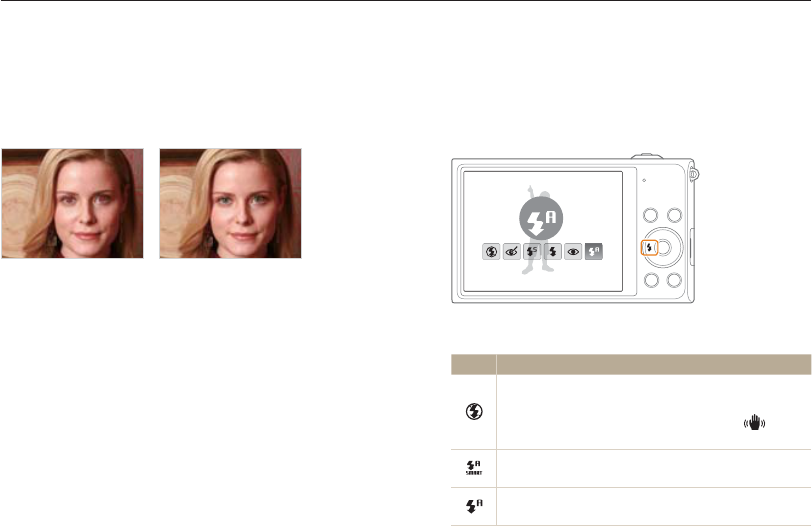
Shooting options
61
Shooting in the dark
Learn how to capture photos at night or in low light conditions.
Using the flash
Use the flash when you capture photos in the dark or when you
need more light in your photos.
1
In Shooting mode, press [
F
].
Flash : Auto
2
Select an option.
Icon Description
Off:
•
The flash will not fire.
•
The camera will display the shake warning when
you are shooting in low light.
Auto: In Smart Auto mode, the camera will select a
proper flash setting for the scene it detects.
Auto: The flash will fire automatically when the subject or
background is dark.
SpAhMs
Preventing red-eye
If the flash fires when you capture a photo of a person in the dark,
a red glow may appear in the person’s eyes. To prevent this,
select Red-eye or Red-eye Fix. Refer to flash options in
“Using the flash.”
S
Before correction
S
After correction
ps

Shooting options
62
Shooting in the dark
•
Flash options are not available if you set Burst options or select
Self-Portrait or Blink Detection.
•
Make sure that your subjects are within the recommended distance
from the flash. (p. 131)
•
If light from the flash is reflected or there is a substantial amount of
dust in the air, tiny spots may appear in your photo.
Adjusting the flash intensity
Adjust the flash intensity to avoid over-exposed or under-exposed
photos.
1
In Shooting mode, press [
F
].
2
Scroll to an option.
3
Press [
c
].
Icon Description
Red-eye:
•
The flash will fire twice when the subject or
background is dark to reduce the red-eye effect.
•
There is an interval between the 2 bursts of the flash.
Do not move until the flash fires a second time.
Fill in:
•
The flash always fires.
•
The camera automatically adjusts light intensity.
Slow Sync:
•
The flash fires and the shutter stays open longer.
•
This option is recommended when you want to
capture more ambient light to reveal more details in
the background.
•
Use a tripod to prevent your photos from blurring.
•
The camera will display the shake warning when
you are shooting in low light.
Red-eye Fix:
•
The flash fires twice when the subject or background
is dark. The camera corrects red-eyes through its
advanced software analysis.
•
There is an interval between the 2 bursts of the flash.
Do not move until the flash fires a second time.
Available options may differ depending on the shooting conditions.

Shooting options
63
Shooting in the dark
4
Rotate the navigation button or press [
F
/
t
] to adjust
the intensity.
Back Set
Flash : Auto
Flash Strength
5
Press [
o
] to save your settings.
•
Adjusting the flash intensity may not be effective if:
- the subject is too close to the camera
- you set a high ISO sensitivity
- the exposure value is too big or too small
•
In some shooting modes, you cannot use this function.
Adjusting the ISO sensitivity
The ISO sensitivity is the measure of a film’s sensitivity to light as
defined by the International Organization for Standardization (ISO).
The higher ISO sensitivity you select, the more sensitive to light
your camera becomes. Use a higher ISO sensitivity to capture
better photos and reduce camera shake when not using the
flash.
1
In Shooting mode, press [
m
].
2
Select
a
ISO.
3
Select an option.
•
Select to use an appropriate ISO sensitivity based on the
brightness of the subject and lighting.
Higher ISO sensitivities may result in more image noise.
pAhM
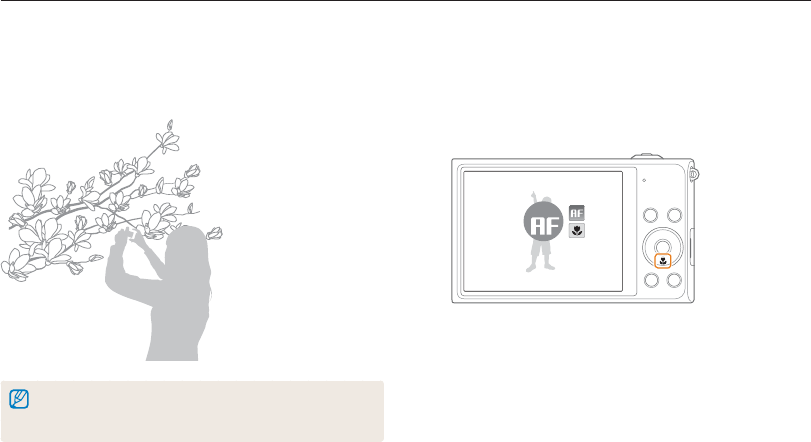
Shooting options
64
Changing the camera’s focus
Learn how to adjust the camera’s focus to suit the subject and the shooting conditions.
Using auto focus
To capture sharp photos, select the appropriate focus option
according to your distance from the subject.
1
In Shooting mode, press [
c
].
Focus : Auto Focus (Normal)
pAhMdsv
Using macro
Use macro to capture close-up photos of subjects, such as
flowers or insects.
•
Try to hold the camera firmly to prevent blurry photos.
•
Turn off the flash if the distance to the subject is less than 16 in.
(40 cm)
pAhMdsv
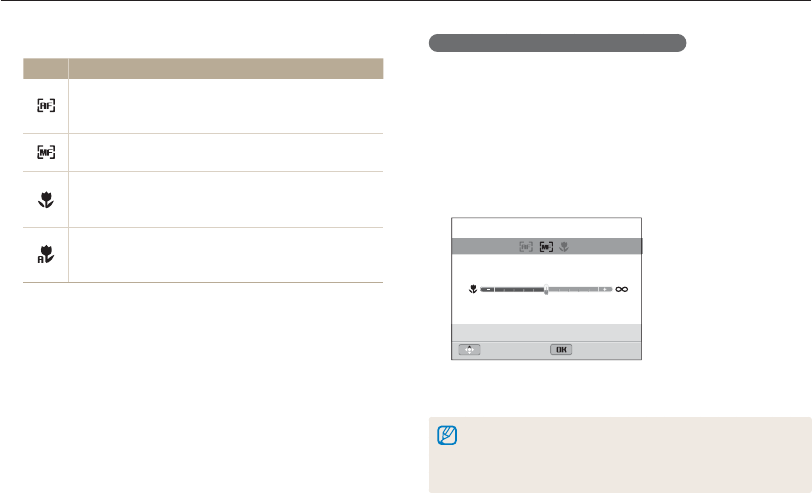
Shooting options
65
Changing the camera’s focus
Adjusting the focus distance manually
1
In Shooting mode, press [
c
].
2
Scroll to Manual Focus.
3
Press [
c
].
4
Rotate the navigation button or press [
F
/
t
] to adjust
the focus distance.
Back Set
Focus : Manual Focus
5
Press [
o
] to save your settings.
•
When you adjust the focus distance manually and the subject is out of
focus, the photo may become blurry.
•
If you use this function, you cannot set focus area options and Face
Detection options.
pAhMds
2
Select an option.
Icon Description
Auto Focus (Normal): Focus on a subject farther than
31 in. (80 cm) away. Farther than 138 in. (350 cm) away
when you use the zoom.
Manual Focus: Focus on a subject by adjusting the
focus distance manually. (p. 64)
Macro: Manually focus on a subject that is 2-31 in.
(5-80 cm) from the camera. 71-138 in. (180-350 cm)
when you use the zoom.
Auto Macro: Focus on a subject farther than 2 in.
(5 cm) away. Farther than 71 in. (180 cm) away when
you use the zoom.
Available options may differ depending on the shooting conditions.
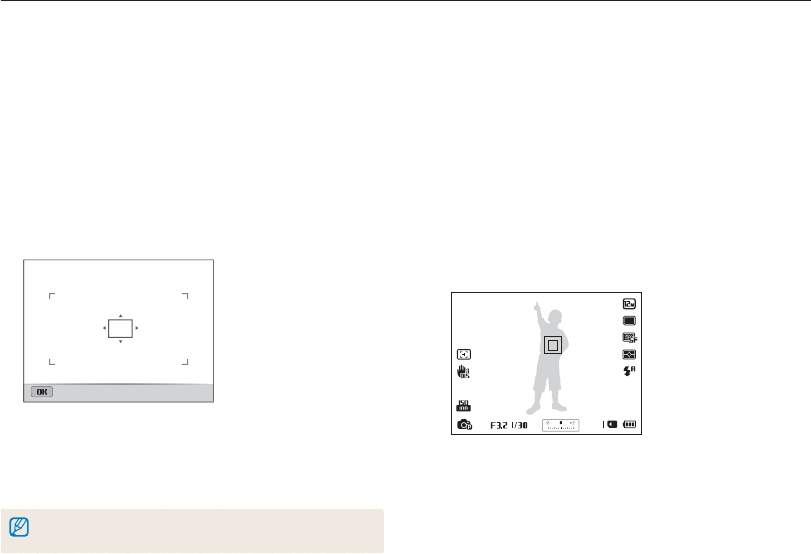
Shooting options
66
Changing the camera’s focus
Using tracking auto focus
Tracking AF allows you to track and auto focus on your subject,
even when you are moving.
1
In Shooting mode, press [
m
].
2
Select
a
Focus Area Tracking AF.
3
Press [
m
] to return to Shooting mode.
4
Focus on the subject you want to track, and then press
[
o
].
•
A focus frame appears on the subject and follows the subject
as you move the camera.
•
The white frame means that your camera is tracking the
subject.
•
When you half-press [Shutter], the green frame means that
your subject is in focus.
5
Press [Shutter] to capture the photo.
pAhMds
Focusing on a selected area
You can focus on an area that you have selected.
1
In Shooting mode, press [
m
].
2
Select
a
Focus Area Selection AF.
3
Press [
m
] to return to Shooting mode.
4
Press [
o
], and then rotate the navigation button or
press [
D
/
c
/
F
/
t
] to move the frame to a desired
area.
Set
5
Press [
o
].
6
Press [Shutter] to capture the photo.
•
Press [
o
] to change the focus area.
If you use this function, you cannot set Face Detection options, Burst options,
Smart zoom options, and Smart Filter effects.
pAhMds

Shooting options
67
Changing the camera’s focus
•
If you do not select a focus area, the focus frame will appear in the
center of the screen.
•
Tracking a subject may fail when:
- the subject is too small
- the subject moves excessively
- the subject is backlit or you are shooting in a dark place
- colors or patterns on the subject and the background are the same
- the subject includes horizontal patterns, such as blinds
- the camera shakes excessively
•
When tracking a subject fails, the focus frame will appear as a white
single-line frame ( ).
•
If the camera fails to track the subject, you must reselect the subject
to track.
•
If the camera fails to focus, the focus frame will change to a red
single-line frame ( ).
•
If you use this function, you cannot set Face Detection options, Burst
options, Smart zoom, and Smart Filter effects.
Adjusting the focus area
You can get clearer photos by selecting an appropriate focus
area according to your subject's location in the scene.
1
In Shooting mode, press [
m
].
2
Select
a
Focus Area.
3
Select an option.
Icon Description
Center AF: Focus on the center of the frame (suitable
when subjects are located at or near the center).
Multi AF: Focus on one or more of 9 possible areas.
Selection AF: Focus on the area that you select. (p. 65)
Tracking AF: Focus on and track the subject. (p. 65)
Available shooting options may differ depending on the shooting mode.
pAhMds
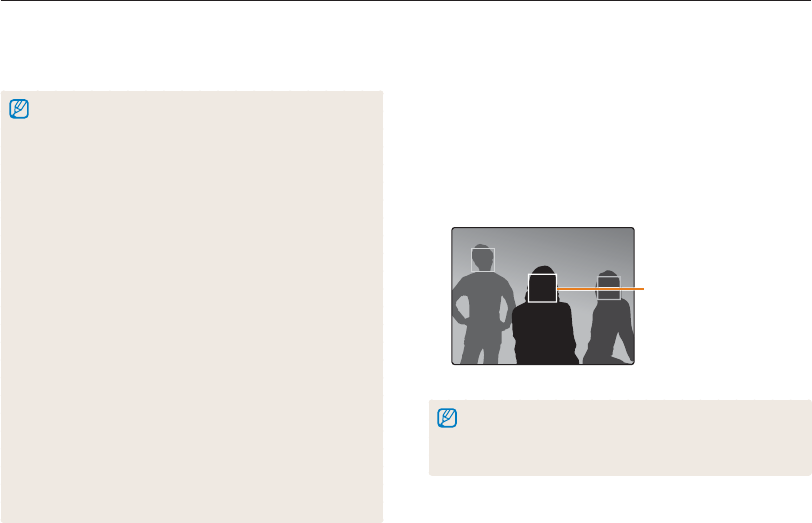
Shooting options
68
Using Face Detection
If you use Face Detection options, your camera can automatically detect a human face. When you focus on a human face, the camera
adjusts the exposure automatically. Use Blink Detection to detect closed eyes or Smile Shot to capture a smiling face. You can also use
Smart Face Recognition to register faces and prioritize the focus on them.
pAhMds
Detecting faces
Your camera automatically detects up to 10 human faces in one
scene.
1
In Shooting mode, press [
m
].
2
Select
a
Face Detection Normal.
The face nearest the camera
or nearest the center of the
scene appears in a white
focus frame and the rest
of the faces appear in gray
focus frames.
•
The closer you are to the subjects, the quicker your camera will detect
faces.
•
If you have set Burst options, the camera may not register detected
faces.
•
When your camera detects a face, it tracks the detected face
automatically.
•
Face Detection may not be effective when:
- the subject is far from the camera (The focus frame will appear
orange for Smile Shot and Blink Detection.)
- it is too bright or too dark
- the subject is not facing the camera
- the subject is wearing sunglasses or a mask
- the subject’s facial expression changes drastically
- the subject is backlit or the lighting conditions are unstable
•
Face Detection is not available when you set Smart Filter effects,
Image adjustment, Selection AF, Tracking AF, or Manual Focus.
•
Depending on the shooting options you selected, available Face
Detection options may differ.
•
Depending on the Face Detection options you selected, the timer
function may not be available.
•
When you set Face Detection options, the AF area is automatically
set to Multi AF.
•
Depending on the Face Detection options you selected, Burst options
may not be available.
•
When you capture photos of detected faces, they will be registered
in the face list.
•
You can view registered faces in order of priority in Playback mode.
(p. 85) Even though faces are registered successfully, they may not be
classified in Playback mode.
•
A face detected in Shooting mode may not appear in the face list or
Smart Album.

Shooting options
69
Using Face Detection
Capturing a self portrait shot
Capture photos of yourself. The camera sets the focus distance
to close-up, and then emits a beep when ready.
1
In Shooting mode, press [
m
].
2
Select
a
Face Detection Self-Portrait.
3
Press [
m
] to return to Shooting mode.
4
Compose your shot with the lens facing you.
5
When you hear a quick beep, press [Shutter].
When faces are located in the center,
the camera beeps rapidly.
If you turn Volume off in the sound settings, the camera will not emit a beep.
(p. 112)
Capturing a smile shot
The camera automatically releases the shutter when it detects a
smiling face.
1
In Shooting mode, press [
m
].
2
Select
a
Face Detection Smile Shot.
3
Press [
m
] to return to Shooting mode.
4
Compose your shot.
•
The camera automatically releases the shutter when it detects
a smiling face.
When your subject smiles
broadly, your camera can detect
the smile more easily.
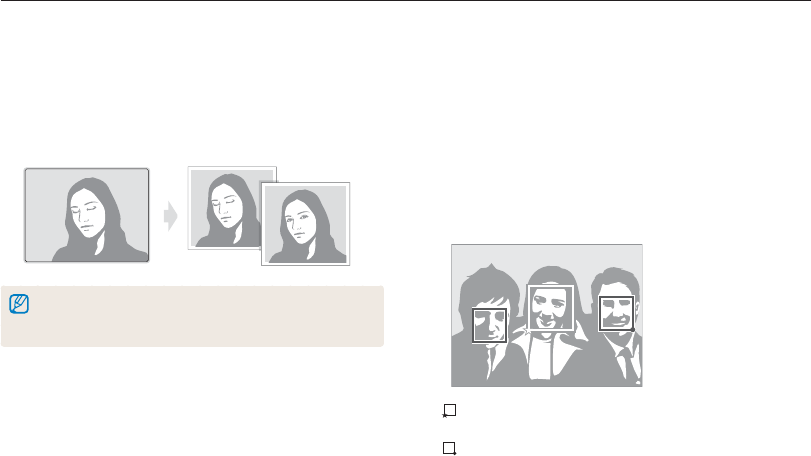
Shooting options
70
Using Face Detection
Using Smart Face Recognition
The camera automatically registers faces that you frequently
photograph. The Smart Face Recognition feature will
automatically prioritize the focus on those faces and on favorite
faces. The Smart Face Recognition feature is available only when
you use a memory card.
1
In Shooting mode, press [
m
].
2
Select
a
Face Detection Smart Face
Recognition.
• : Faces that you have registered as favorites.
(To register faces as favorites, refer to page 70.)
• : Faces that the camera has automatically registered.
Detecting eye blinking
If your camera detects closed eyes, it will automatically capture
2 photos in succession.
1
In Shooting mode, press [
m
].
2
Select
a
Face Detection Blink Detection.
•
Hold your camera still while “Capturing” is displayed on the screen.
•
If Blink Detection fails, the “Picture taken with eyes closed.”
message appears. Capture another photo.
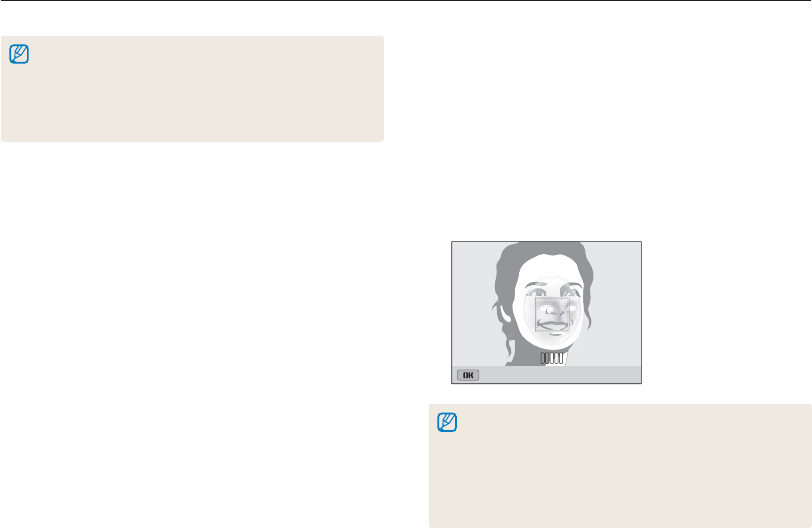
Shooting options
71
Using Face Detection
Registering faces as your favorites (My Star)
You can register your favorite faces to prioritize the focus and
exposure on those faces. This feature is available only when you
use a memory card.
1
In Shooting mode, press [
m
].
2
Select
a
Smart FR Edit My Star.
3
Align your subject’s face with the oval guideline, and then
press [Shutter] to register the face.
Set
•
Capture photos of one person at a time when registering faces.
•
Capture 5 photos of the subject’s face for best results: one each from
the front, left, right, above, and below.
•
When capturing photos from the left, right, above, and below, instruct
the subject not to turn his or her face more than 30 degrees.
•
You can register a face even if you capture only one photo of the
subject's face.
•
The camera may recognize and register faces incorrectly depending
on lighting conditions, drastic changes in the subject's pose or face,
and whether or not the subject is wearing glasses.
•
The camera can automatically register up to 12 faces. If the camera
recognizes a new face when 12 faces have already been registered, it
will replace the lowest priority face with the new one.

Shooting options
72
Using Face Detection
4
When you are finished capturing the photos, the face list
appears.
•
Your favorite faces are indicated with a on the face list.
•
You can register up to 8 favorite faces.
•
The flash will not fire when you register a favorite face.
•
If you register the same face twice, you can delete one of the faces
in the face list.
Viewing your favorite faces
1
In Shooting mode, press [
m
].
2
Select
a
Smart FR Edit Face List.
•
To change the ranking of your favorite faces, press [
f
], and then
select Edit Ranking. (p. 85)
•
To delete a favorite face, press [
f
], and then select Delete. (p. 86)
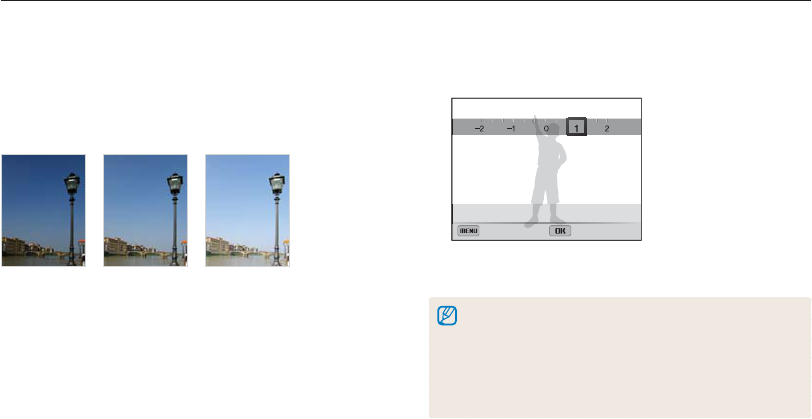
Shooting options
73
Adjusting brightness and color
Learn how to adjust the brightness and color for better image quality.
3
Select a value to adjust the exposure.
•
The photo will be brighter as the exposure value increases.
Back Set
EV : 1
4
Press [
o
] to save your settings.
•
Once you adjust the exposure, the setting will be stored automatically.
You may need to change the exposure value later to avoid
overexposure or underexposure.
•
If you cannot decide on an appropriate exposure, select the AE BKT
(Auto Exposure Bracket) option (p. 79), and then capture bracketed
photos. The camera will capture 3 consecutive photos, each with a
different exposure: normal, underexposed, and overexposed. (p. 78)
Adjusting the exposure manually (EV)
Depending on the intensity of the ambient light, your photos
may be too bright or dark. In these cases, you can adjust the
exposure to get a better photo.
S
Darker (-)
S
Neutral (0)
S
Brighter (+)
1
In Shooting mode, press [
m
].
2
Select
a
or
V
EV.
pAhdv

Shooting options
74
Adjusting brightness and color
Icon Description
Spot:
•
Your camera measures only the light intensity at the
very center of the frame.
•
If a subject is not in the center of the frame, your
photo may be improperly exposed.
•
Suitable for a subject with backlighting.
Center-weighted:
•
Your camera averages the meter reading of the entire
frame with emphasis placed on the center.
•
Suitable for photos with subjects in the center of the
frame.
Changing the metering option
The metering mode refers to the way in which a camera
measures the quantity of light. The brightness and lighting of your
photos will vary depending on the metering mode you select.
1
In Shooting mode, press [
m
].
2
Select
a
or
V
Metering.
3
Select an option.
Icon Description
Multi:
•
Your camera divides the frame into several areas,
and then measures the light intensity of each area.
•
Suitable for general photos.
pAhMdsv
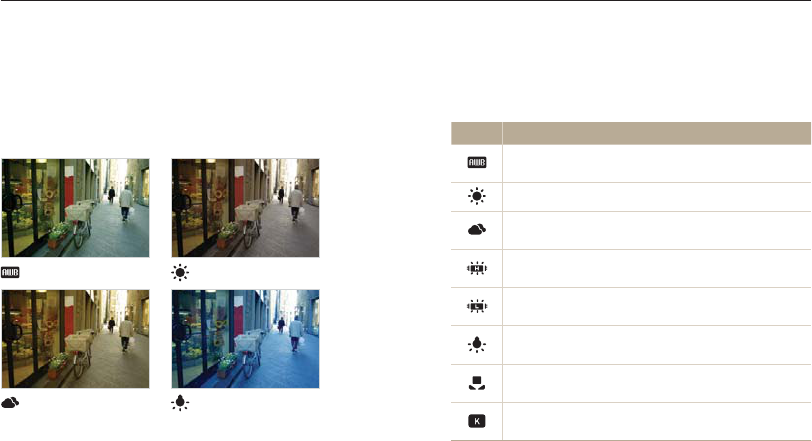
Shooting options
75
Adjusting brightness and color
Selecting a White Balance setting
The color of your photo depends on the type and quality of the
light source. If you want the color of your photo to be realistic,
select a White Balance setting that is appropriate for the lighting
conditions, such as Auto WB, Daylight, Cloudy, or Tungsten.
Auto WB Daylight
Cloudy Tungsten
pAhMdv
1
In Shooting mode, press [
m
].
2
Select
a
or
V
White Balance.
3
Select an option.
Icon Description
Auto WB: Automatically set the White Balance based
on the lighting conditions.
Daylight: For outdoor photos on a sunny day.
Cloudy: For outdoor photos on a cloudy day or in
shadows.
Fluorescent_H: For shooting under a daylight
fluorescent or 3-way fluorescent light.
Fluorescent_L: For shooting under white fluorescent
light.
Tungsten: For shooting indoor photos under
incandescent bulbs or halogen lamps.
Custom Set: To use White Balance settings that you
define. (p. 75)
Color Temp.: To adjust the color temperature of the
light source. (p. 76)
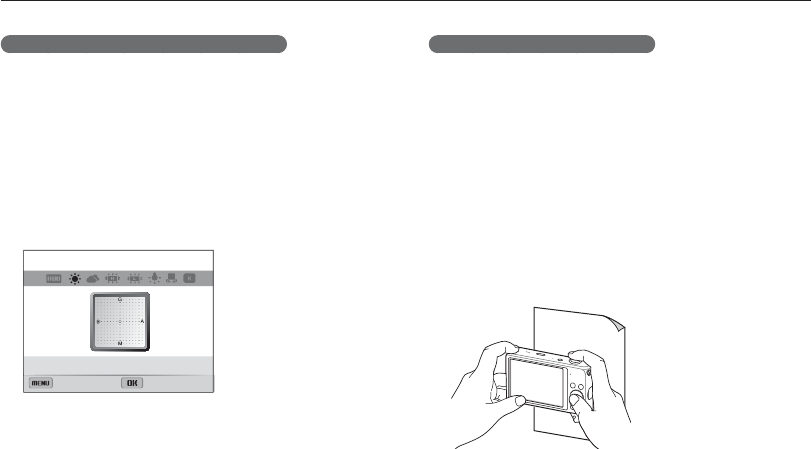
Shooting options
76
Adjusting brightness and color
Customizing preset White Balance options
1
In Shooting mode, press [
m
].
2
Select
a
or
V
White Balance.
3
Scroll to a desired option.
4
Press [
c
].
5
Press [
D
/
c
/
F
/
t
] to adjust the value on the
coordinates.
•
G: Green
•
A: Amber
•
M: Magenta
•
B: Blue
Back Set
White Balance : Daylight
6
Press [
o
] to save your settings.
Defining your own White Balance
You can customize the White Balance by capturing a photo of
a white surface, such as a piece of paper, under the lighting
conditions in which you intend to capture a photo. The White
Balance feature will help you to match the colors in your photo
with the actual scene.
1
In Shooting mode, press [
m
].
2
Select
a
or
V
White Balance.
3
Scroll to Custom Set.
4
Aim the lens at a piece of white paper, and then press
[Shutter].

Shooting options
77
Adjusting brightness and color
Adjusting color temperature
1
In Shooting mode, press [
m
].
2
Select
a
or
V
White Balance.
3
Scroll to Color Temp..
4
Press [
c
].
5
Rotate the navigation button or press [
F
/
t
] to adjust
the color temperature to match your light source.
•
You can capture a warmer photo with a higher color
temperature setting (more yellow/red), and a cooler photo with
a lower color temperature setting (more blue).
Back Set
White Balance : Color Temp.
6
Press [
o
] to save your settings.
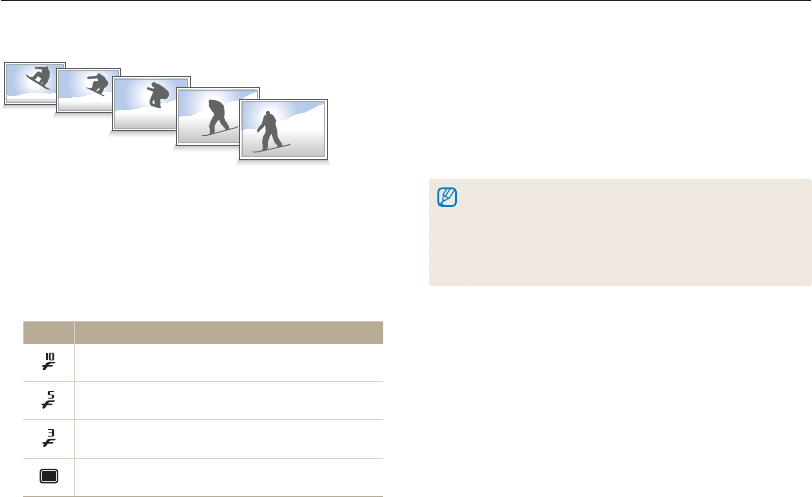
Shooting options
78
Using burst modes
It can be difficult to capture photos of fast-moving subjects or capture natural facial expressions and gestures of your subjects in photos.
Also, it can be difficult to adjust the exposure correctly and select a proper light source. In these cases, select one of the burst modes.
pAhM
3
Align your subject in the frame, and then half-press
[Shutter] to focus.
4
Press and hold [Shutter].
•
While you are pressing [Shutter], the camera captures photos
continuously.
•
You can use the flash, Smart Zoom, Face Detection options, and
Smart Filter options only when you select Single.
•
It may take longer to save the photos depending on the memory card
capacity and performance.
•
The camera always displays captured photos before returning to
Shooting mode.
Capturing photos in the High-speed burst
mode
1
In Shooting mode, press [
Q
].
2
Select an option.
Icon Description
10fps: Capture 10 photos per second continuously.
(You can capture up to 8 photos in one burst.)
5fps: Capture 5 photos per second continuously.
(You can capture up to 8 photos in one burst.)
3fps: Capture 3 photos per second continuously.
(You can capture up to 8 photos in one burst.)
Single: Capture a single photo. Single is not a
high-speed burst option.

Shooting options
79
Using burst modes
Capturing photos in the Precapture mode
In Precapture mode, the camera starts shooting before you even
press the shutter all the way down. If you do not want to miss the
first couple of important shots, simply use this mode and select
the photo with the best results after shooting.
1
In Shooting mode, press [
Q
].
2
Select Precapture.
3
Align your subject in the frame, and then half-press
[Shutter] to focus.
•
The camera captures 7 photos continuously. If you release
[Shutter] too fast, the camera captures less than 7 photos.
4
Press [Shutter].
•
The camera capture the last photo and then saves all of the
captured photos while you are half-pressing [Shutter].
•
If you do not press [Shutter] all the way down, the photos
captured while you are half-pressing [Shutter] will not be
saved.
Capturing bracketed photos
You can use the automatic bracketing feature to capture multiple
photos of the same subject with different setting values slightly
modified, such as exposure or white balance.
1
In Shooting mode, press [
Q
].
2
Select Bracket.
3
Align your subject in the frame, and then half-press
[Shutter] to focus.
4
Press [Shutter].
•
The camera captures 3 photos continuously.
Use a tripod to prevent blurry photos.

Shooting options
80
Using burst modes
Selecting a bracketing option
1
In Shooting mode, press [
m
].
2
Select
a
Bracket.
3
Select a bracketing option.
Icon Description
WB BKT: Capture 3 photos with different white
balance.
AE BKT: Capture 3 photos with selected exposures.
4
Adjust the color for the selected light source
(white balance) or select an exposure value.
5
Press [
o
] to save your settings.
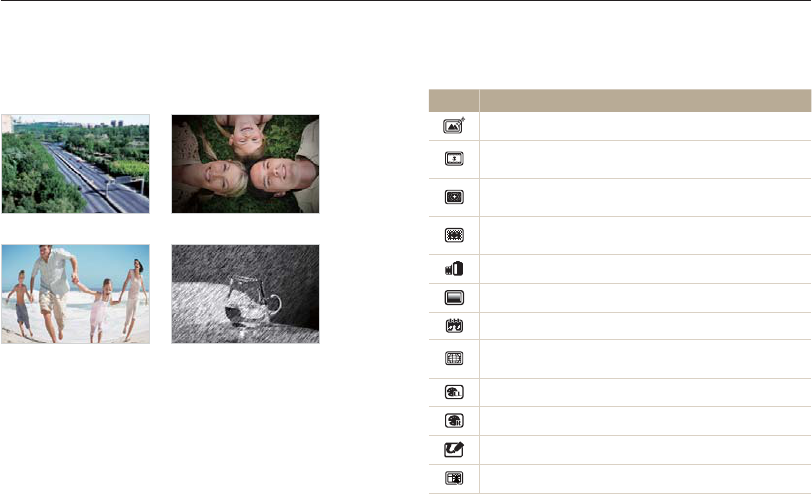
Shooting options
81
Applying effects/Adjusting images
Available filters in Program, Aperture Priority, Shutter Priority,
and Manual modes
Icon Description
Normal: No effect
Miniature: Apply a tilt-shift effect to make the subject
appear in miniature.
Vignetting: Apply the retro-looking colors, high contrast,
and strong vignette effect of Lomo cameras.
Soft Focus: Hide facial imperfections or apply dreamy
effects.
Old Film: Apply a vintage film effect.
Half Tone Dot: Apply a halftone effect.
Sketch: Apply a pen sketch effect.
Fish-eye: Distort close objects to imitate the visual effect of
a fisheye lens.
Classic: Apply a black and white effect.
Retro: Apply a sepia tone effect.
Oil Painting: Apply an oil painting effect.
Cartoon: Apply a cartoon painting effect.
Applying Smart Filter effects
Apply various filter effects to your photos and videos to create
unique images.
Miniature Vignetting
Fish-eye Sketch
1
In Shooting mode, press [
m
].
2
Select
a
or
V
Smart Filter.
3
Select an effect.
pAhMv
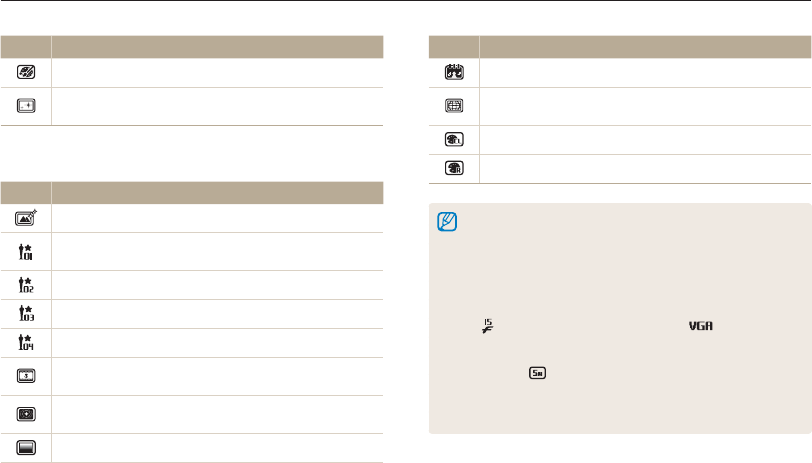
Shooting options
82
Applying effects/Adjusting images
Icon Description
Ink Painting: Apply a watercolor painting effect.
Cross Filter: Add lines that radiate outward from bright
objects to imitate the visual effect of a cross filter.
Available filters in Movie mode
Icon Description
Normal: No effect
Palette Effect 1: Create a vivid look with sharp contrast
and strong color.
Palette Effect 2: Make scenes clean and clear.
Palette Effect 3: Apply a soft brown tone.
Palette Effect 4: Create a cold and monotone effect.
Miniature: Apply a tilt-shift effect to make the subject
appear in miniature.
Vignetting: Apply the retro-looking colors, high contrast,
and strong vignette effect of Lomo cameras.
Half Tone Dot: Apply a halftone effect.
Icon Description
Sketch: Apply a pen sketch effect.
Fish-eye: Distort close objects to imitate the visual effect of
a fisheye lens.
Classic: Apply a black and white effect.
Retro: Apply a sepia tone effect.
•
If you select Miniature when recording a video, the miniature
recording time is displayed with the Miniature icon and is shorter than
the real recording time.
•
If you select Miniature when recording a video, you cannot record the
video sound or capture still images while recording a video.
•
If you select Miniature, Vignetting, Half Tone Dot, Sketch, or
Fish-eye while recording a video, the recording speed will be set to
and the recording resolution will be set to .
•
If you select Sketch, Oil Painting, Cartoon, Ink Painting, or
Cross Filter when capturing a photo, the photo size will automatically
change to and below.
•
If you set Smart Filter effects, you cannot set Smart Zoom, Face
Recognition options, Image Adjustment options, Burst options,
Tracking AF, or Selection AF.
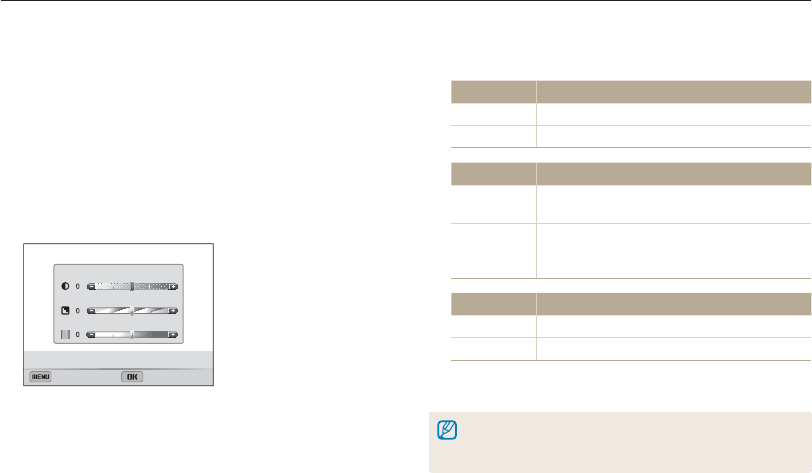
Shooting options
83
Applying effects/Adjusting images
Adjusting your photos
Adjust the sharpness, saturation, or contrast of your photos.
1
In Shooting mode, press [
m
].
2
Select
a
Image Adjust.
3
Select an option.
•
Contrast
•
Sharpness
•
Saturation
Image Adjust : Contrast
Contrast
Sharpness
Saturation
Back Set
pAhM
4
Rotate the navigation button or press [
F
/
t
] to adjust
each value.
Contrast Description
-Decrease the color and brightness.
+Increase the color and brightness.
Sharpness Description
-Soften the edges on your photos (suitable for
editing the photos on your computer).
+
Sharpen the edges to improve the clarity of your
photos. This may also increase the noise in your
photos.
Saturation Description
-Decrease the saturation.
+Increase the saturation.
5
Press [
o
] to save your settings.
•
Select 0 if you do not want to apply any effects (suitable for printing).
•
If you set adjustment functions, you cannot use Smart Filter options
and Face Detection options.

Viewing photos or videos in
Playback mode
…………………………… 85
Starting Playback mode
………………… 85
Viewing photos
…………………………… 91
Playing a video
…………………………… 94
Editing a photo
……………………………… 96
Resizing photos
…………………………… 96
Rotating a photo
………………………… 96
Applying Smart Filter effects
……………… 97
Adjusting your photos
…………………… 98
Creating a print order (DPOF)
…………… 99
Viewing files on a TV, HDTV, or 3D TV
… 101
Transferring files to your Windows
computer
………………………………… 102
Transferring files with Intelli-studio
……… 103
Transferring files by connecting
the camera as a removable disk
……… 105
Disconnecting the camera
(for Windows XP)
……………………… 106
Transferring files to your
Mac computer
…………………………… 107
Printing photos with a PictBridge
photo printer
……………………………… 108
Playback/Editing
Learn how to play back photos or videos, and edit photos or videos. Also, learn how to
connect your camera to your computer, photo printer, TV, HDTV, or 3D TV.
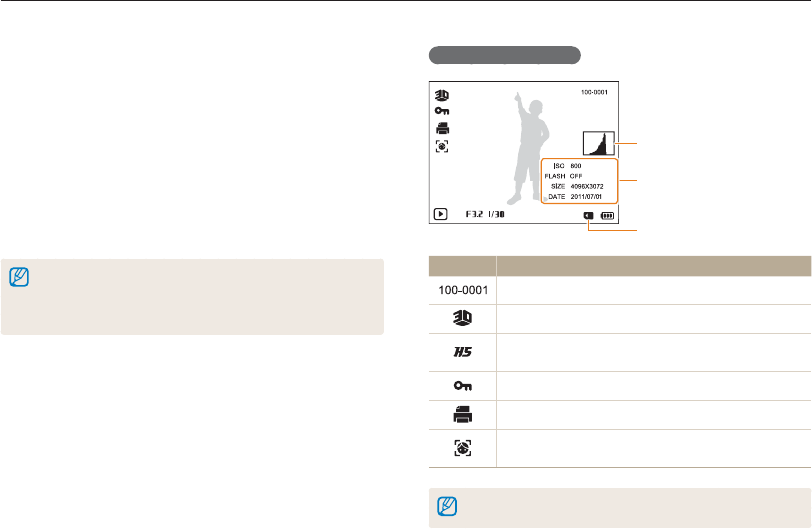
Playback/Editing
85
Viewing photos or videos in Playback mode
Learn how to play back photos or videos and how to manage files.
Photo file information
File Information
Histogram
Memory in use
Icon Description
Folder name–File name
Photo captured in 3D Photo mode
Photo captured in a High-speed burst mode or in
Precapture mode (See Viewing files as a folder, p. 86)
Protected file
Print order has been set (DPOF)
Photo includes a registered face (Available only when
you use a memory card.)
To display file information on the screen, press [
D
].
Starting Playback mode
View photos or play videos stored in your camera.
1
Press [
P
].
•
The most recent file will be displayed.
•
If the camera is off, it will turn on and display the most recent
file.
2
Rotate the navigation button or press [
F
/
t
] to scroll
through files.
•
Press and hold [
F
/
t
] to scroll through files quickly.
•
If you want to view files stored in the internal memory, remove your
memory card.
•
The camera will not properly play back files of unsupported sizes or
files that were captured with other cameras.
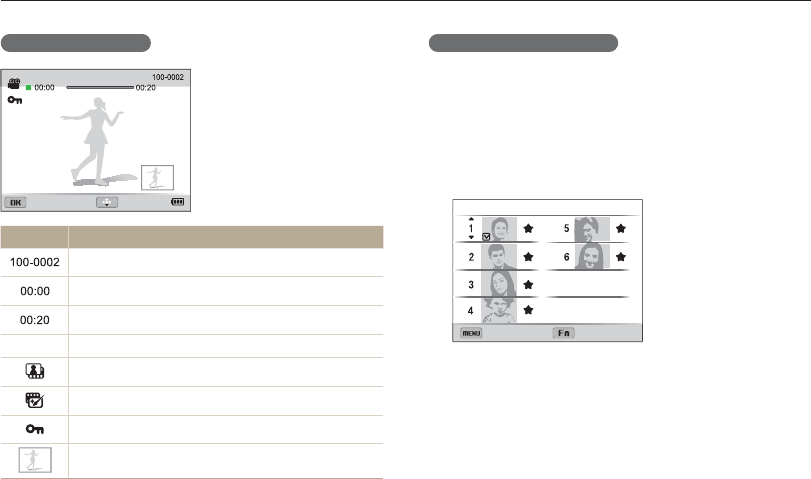
Playback/Editing
86
Viewing photos or videos in Playback mode
Ranking your favorite faces
You can rank your favorite faces. The favorite face feature is
available only when you insert a memory card into the camera.
1
In Playback mode, press [
m
].
2
Select
O
Face List Edit Edit Ranking.
3
Select a face from the list, and then press [
o
].
SetBack
Face List
4
Rotate the navigation button or press [
D
/
c
] to
change the ranking of the face, and then press [
f
].
Video file information
Play Capture
Icon Description
Folder name-File name
Current playback time
Video length
V
Video file
Video includes images captured while recording
Video made in Creative Movie Maker mode
Protected file
Image captured while recording a video
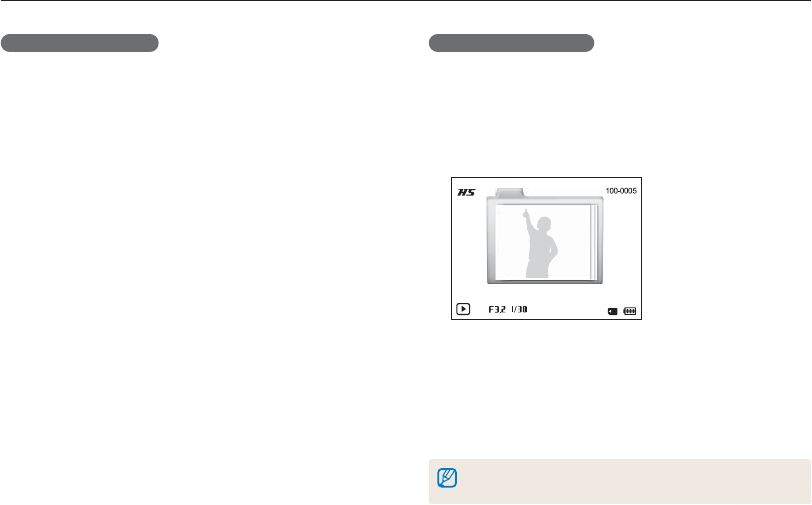
Playback/Editing
87
Viewing photos or videos in Playback mode
Viewing files as a folder
Photos captured in a High-speed burst mode or in Precapture
mode appear as a folder.
1
In Playback mode, rotate the navigation button or press
[
F
/
t
] to scroll to a desired folder.
•
The camera will automatically play back photos in the folder.
OK : Single View
2
Press [
o
] to open the folder.
3
Rotate the navigation button or press [
F
/
t
] to scroll
through the files.
4
Press [
o
] to return to Playback mode.
You cannot edit a photo while viewing a folder. To edit a photo in a folder,
press [
o
] to open the folder, and then scroll to the photo.
Deleting favorite faces
You can delete your favorite faces. The favorite face feature is
available only when you insert a memory card into the camera.
1
In Playback mode, press [
m
].
2
Select
O
Face List Edit Delete.
3
Select a face, and then press [
o
].
4
Press [
f
].
5
When the pop-up message appears, select Yes.

Playback/Editing
88
Viewing photos or videos in Playback mode
4
Rotate the navigation button or press [
F
/
t
] to scroll
through the files.
•
Press and hold [
F
/
t
] to scroll through files quickly.
5
Press [
o
] to return to the normal view.
It may take some time for the camera to open Smart Album, change the
category, or reorganize files.
Viewing files by category in Smart Album
View files by category, such as date, face, or file type.
1
In Playback mode, rotate [Zoom] to the left.
2
Press [
m
].
3
Select a category.
Type
Date
Week
Face
Back Set
Option Description
Type View files by the file type.
Date View files by the date they were saved.
Week View files by the day of the week they were saved.
Face View files by recognized faces and favorite faces.
(Up to 20 people)
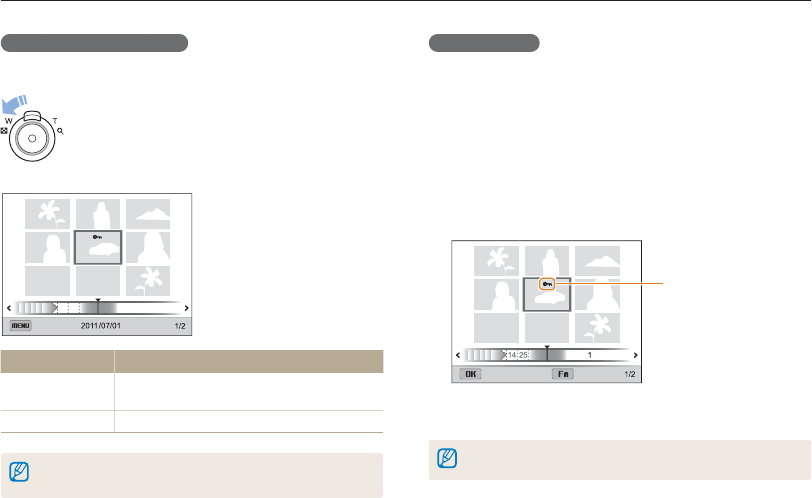
Playback/Editing
89
Viewing photos or videos in Playback mode
Viewing files as thumbnails
Scan thumbnails of files.
In Playback mode, rotate [Zoom] to the left to view
thumbnails (3 at a time). Rotate [Zoom] to the left
once or twice more to display more thumbnails (9 or
20 at a time). Rotate [Zoom] to the right to return to
the previous view.
14 25 11
Filter
To Description
Scroll through files Rotate the navigation button or press
[
D
/
c
/
F
/
t
].
Delete files Press [
f
], and then select Yes.
When you scroll to a video file or folder in the thumbnails view, the camera will
automatically play back the video or the photos in the folder.
Protecting files
Protect your files from accidental deletion.
1
In Playback mode, press [
m
].
2
Select
O
Protect Select.
•
To protect all files, select All Lock.
3
Scroll to the file you want to protect, and then press
[
o
].
•
Press [
o
] again to cancel your selection.
Select Set
Protected file icon
4
Press [
f
].
You cannot delete or rotate a protected file.

Playback/Editing
90
Viewing photos or videos in Playback mode
Deleting multiple files
You can select multiple files, and then delete them at once.
1
In Playback mode, press [
f
].
2
When the pop-up message appears, select Multiple
Delete.
•
You can also delete multiple files in Playback mode by
pressing [
m
], and then selecting
O
Delete
Select.
3
Scroll to each file you want to delete, and then press
[
o
].
•
Press [
o
] again to cancel your selection.
4
Press [
f
].
5
When the pop-up message appears, select Yes.
Deleting files
Select files to delete in Playback mode.
Deleting a single file
You can select one file, and then delete it.
1
In Playback mode, select a file, and then press [
f
].
2
When the pop-up message appears, select Yes.
•
When viewing files in Smart Album or thumbnails view, press [
f
] to
delete a file.
•
While viewing files as a folder, press [
f
] to delete all photos in the
folder.
•
To delete a specific photo in a folder, open the folder, select a file,
and then press [
f
].

Playback/Editing
91
Viewing photos or videos in Playback mode
Viewing photos
Enlarge part of a photo or view photos as a slide show.
Enlarging a photo
In Playback mode, rotate [Zoom] to the right to
enlarge a portion of the photo. Rotate [Zoom] to the
left to zoom out.
Enlarged area
Zoom ratio (The maximum
zoom ratio differs depending
on the photo resolution.)
Trim
Deleting all files
You can select all files, and then delete them at once.
1
In Playback mode, press [
m
].
2
Select
O
Delete All.
3
When the pop-up message appears, select Yes.
•
All unprotected files are deleted.
Copying files to a memory card
Copy files from the internal memory to a memory card.
1
In Playback mode, press [
m
].
2
Select
O
Copy to Card.
3
Select Yes.

Playback/Editing
92
Viewing photos or videos in Playback mode
Viewing panoramic photos
View photos captured in Panorama mode.
1
In Playback mode, rotate the navigation button or press
[
F
/
t
] to scroll to a desired panoramic photo.
•
The entire panoramic photo appears on the screen.
2
Press [
o
].
•
The camera automatically scrolls through the photo
horizontally or vertically, depending on the direction you
moved when capturing the photo. The camera then switches
to Playback mode.
•
While playing back a panoramic photo, press [
o
] to pause
or resume.
•
After you have paused the playback of a panoramic photo,
press [
D
/
c
/
F
/
t
] to move the photo horizontally or
vertically, depending on the direction you moved when
capturing the photo.
3
Press [
m
] to return to Playback mode.
•
The camera automatically scrolls through the panoramic photo only
if the longest side of the photo is two or more times longer than the
shortest side.
•
On your camera’s display, a photo captured in 3D Panorama mode
appears as a 2D panoramic photo. To see the 3D effect, connect your
camera to a 3D TV or 3D monitor. (p. 102)
To Description
Move the enlarged area Rotate the navigation button or press
[
D
/
c
/
F
/
t
].
Trim the enlarged photo
Press [
o
], and then select Yes.
(The trimmed photo will be saved as a
new file. The original photo is retained in its
original form.)
When you view photos that were captured by another camera, the zoom
ratio may differ.

Playback/Editing
93
Viewing photos or videos in Playback mode
Playing a slide show
Apply effects and audio to a slide show of your photos. The slide
show function does not work for videos.
1
In Playback mode, press [
m
].
2
Select .
3
Select a slide show effect option.
•
Skip to step 4 to start a slide show with no effects.
* Default
Option Description
Start Set whether or not to repeat the slide show.
(Play, Repeat)
Images
Set the photos you want to view as a slide show.
•
All*: View all photos in a slide show.
•
Date: View photos captured on a specific date in
a slide show.
•
Select: View selected photos in a slide show.
Interval
•
Set the interval between photos.
(1 sec*, 3 sec, 5 sec, 10 sec)
•
You must set the Effect option to Off to set the
interval.
* Default
Option Description
Effect
•
Set a scene change effect between photos.
(Off*, Calm, Shine, Relax, Lively, Sweet)
•
Select Off to cancel effects.
•
When you use the Effect option, the interval
between photos will be set to 3 seconds.
Music Set background audio.
4
Select Start Play.
•
Select Repeat to loop the slide show.
5
View the slide show.
•
Press [
o
] to pause the slide show.
•
Press [
o
] again to resume the slide show.
Press [
o
], and then press [
F
/
t
] to stop the slide show and return to
Playback mode.
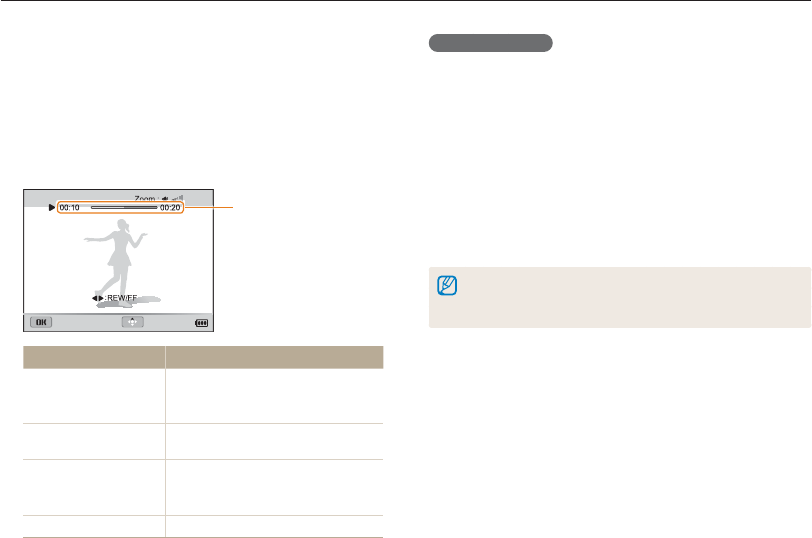
Playback/Editing
94
Viewing photos or videos in Playback mode
Trimming a video
1
While viewing a video, press [
o
] at the point where you
want the trimming to begin.
2
Rotate [Zoom] to the right, and then press [
o
].
3
Press [
o
] at the point where you want the trimming to
end.
4
Rotate [Zoom] to the right.
5
When the pop-up message appears, select Yes.
•
The original video should be at least 10 seconds long.
•
The camera will save the edited video as a new file and leave the
original video intact.
Playing a video
In Playback mode, you can view a video, and then capture or trim
parts of the playing video. You can save the captured or trimmed
segments as new files.
1
In Playback mode, select a video, and then press [
o
].
2
View the video.
Current playback time/
Video length
Pause Stop
To Description
Scan backward
Press [
F
]. Each time you press [
F
],
you change the scan speed in this
order: 2X, 4X, 8X.
Pause or resume
playback Press [
o
].
Scan forward
Press [
t
]. Each time you press [
t
],
you change the scan speed in this
order: 2X, 4X, 8X.
Adjust the volume level Rotate [Zoom] to the left or right.

Playback/Editing
95
Viewing photos or videos in Playback mode
Capturing an image from video
1
While viewing a video, press [
o
] at the point where you
want to capture an image.
2
Press [
c
].
•
The resolution of the captured image will be the same as the original
video.
•
The captured image is saved as a new file.
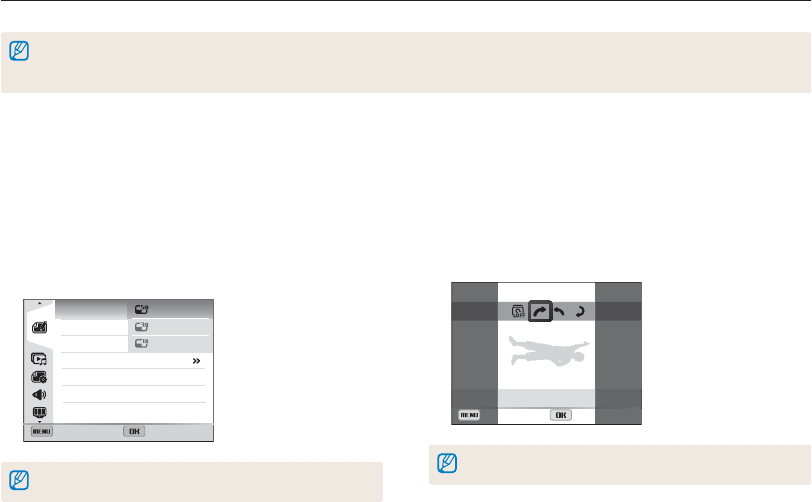
Playback/Editing
96
Editing a photo
Learn how to edit photos.
•
The camera will save edited photos as new files.
•
When you edit photos, the camera will automatically convert them to a lower resolution. Photos that you rotate or resize manually are not automatically converted to
a lower resolution.
Rotating a photo
1
In Playback mode, select a photo, and then press
[
m
].
2
Select
e
Rotate.
3
Select an option.
Back Set
Rotate : Right 90˚
The camera will overwrite the original file.
Resizing photos
Change the size of a photo and save it as a new file.
1
In Playback mode, select a photo, and then press
[
m
].
2
Select
e
Resize.
3
Select an option.
Back Set
Resize
Rotate
Smart Filter
Image Adjust
2592X1944
1984X1488
1024X768
Available resize options differ depending on the original size of the photo.
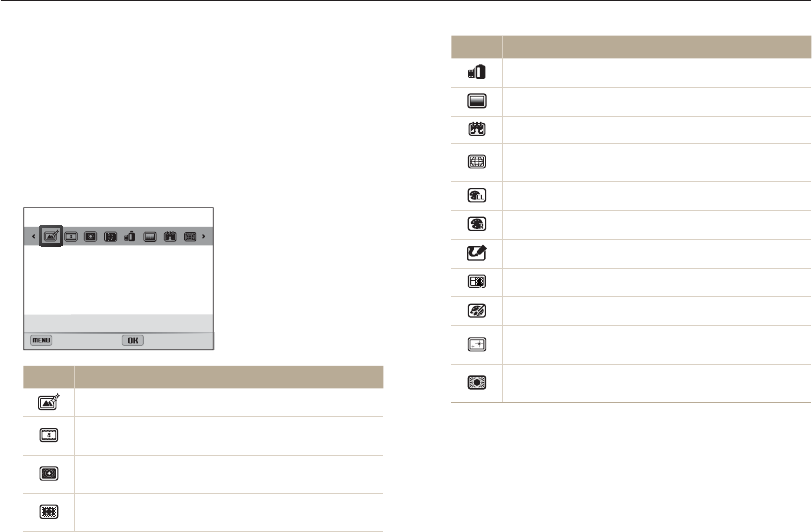
Playback/Editing
97
Editing a photo
Applying Smart Filter effects
Apply special effects to your photos.
1
In Playback mode, select a photo, and then press
[
m
].
2
Select
e
Smart Filter.
3
Select an effect.
Back Set
Smart Filter : Normal
Icon Description
Normal: No effect
Miniature: Apply a tilt-shift effect to make the subject
appear in miniature.
Vignetting: Apply the retro-looking colors, high
contrast, and strong vignette effect of Lomo cameras.
Soft Focus: Hide facial imperfections or apply dreamy
effects.
Icon Description
Old Film: Apply a vintage film effect.
Half Tone Dot: Apply a halftone effect.
Sketch: Apply a pen sketch effect.
Fish-eye: Distort close objects to imitate the visual
effect of a fisheye lens.
Classic: Apply a black and white effect.
Retro: Apply a sepia tone effect.
Oil Painting: Apply an oil painting effect.
Cartoon: Apply a cartoon painting effect.
Ink Painting: Apply a watercolor painting effect.
Cross Filter: Add lines that radiate outward from bright
objects to imitate the visual effect of a cross filter.
Zooming Shot: Blur the edges of a photo to
emphasize the subjects in the center.

Playback/Editing
98
Editing a photo
Retouching faces
1
In Playback mode, select a photo, and then press
[
m
].
2
Select
e
Image Adjust Face Retouch.
3
Press [
c
].
4
Rotate the navigation button or press [
F
/
t
] to adjust
the skin tone.
•
As the number increases, the skin tone becomes brighter.
5
Press [
o
] to save your settings.
Adjusting your photos
Learn how to correct red-eye, adjust the skin tone, and adjust the
brightness, contrast, or saturation. The camera will save an edited
photo as a new file, but may convert it to a lower resolution.
Removing red-eye
1
In Playback mode, select a photo, and then press
[
m
].
2
Select
e
Image Adjust Red-eye Fix.
3
Press [
o
] to save your settings.

Playback/Editing
99
Editing a photo
Adjusting brightness, contrast, or saturation
1
In Playback mode, select a photo, and then press
[
m
].
2
Select
e
Image Adjust.
3
Select an adjusting option.
Icon Description
Brightness
Contrast
Saturation
4
Press [
c
].
5
Rotate the navigation button or press [
F
/
t
] to adjust
the option.
6
Press [
o
] to save your settings.
Adding noise to the photo
1
In Playback mode, select a photo, and then press
[
m
].
2
Select
e
Image Adjust Add Noise.
3
Press [
o
] to save.
Creating a print order (DPOF)
Select photos to print and save print options in the Digital Print
Order Format (DPOF). This information is saved in the MISC
folder on your memory card for convenient printing on DPOF-
compatible printers.
1
In Playback mode, press [
m
].
2
Select
O
DPOF Standard Select.
•
Select All to print all photos.

Playback/Editing
100
Editing a photo
3
Scroll to a photo you want to print, rotate [Zoom] to the
left or right to select the number of copies, and then
press [
f
].
•
If you select All, press [
D
/
c
] to select the number of
copies, and then press [
o
].
4
Press [
m
].
5
Select
O
DPOF Size Select.
•
Select All to choose the print size for all photos.
6
Scroll to a photo you want to print, rotate [Zoom] to the
left or right to select the print size, and then press [
f
].
•
If you select All, press [
D
/
c
] to select the print size, and
then press [
o
].
Printing photos as thumbnails
Print photos as thumbnails to check all the photos at once.
1
In Playback mode, press [
m
].
2
Select
O
DPOF Index.
3
When the pop-up message appears, select Yes.
•
You can take the memory card to a print shop that supports DPOF
(Digital Print Order Format) or you can print photos directly through a
DPOF-compatible printer at home.
•
Photos with dimensions that are wider than the paper may be cut off
on the left and right edges. Ensure that your photo dimensions are
compatible with the paper you select.
•
You cannot set DPOF options for photos stored in the internal
memory.
•
If you specify the print size, you can print photos only with
DPOF 1.1-compatible printers.
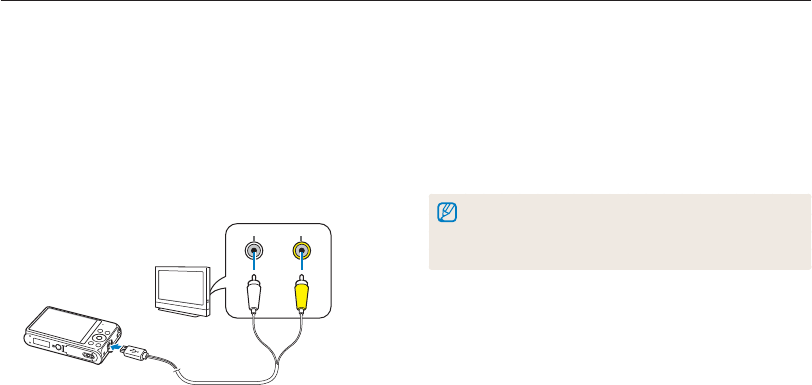
Playback/Editing
101
Viewing files on a TV, HDTV, or 3D TV
Play back photos or videos by connecting your camera to a TV with the A/V cable.
6
Turn on your TV, and then select the A/V video source
with the TV remote control.
7
Turn on your camera.
•
The camera automatically enters into Playback mode when
you connect it to a TV.
8
View photos or play videos using the camera buttons.
•
Depending on the TV model, you may see some digital noise or part
of an image may not appear.
•
Images may not be centered on the TV screen depending on your
TV settings.
1
In Shooting or Playback mode, press [
m
].
2
Select
n
Video Out.
3
Select the video signal output for your country or region.
(p. 115)
4
Turn off your camera and TV.
5
Connect your camera to your TV with the A/V cable.
VideoAudio

Playback/Editing
102
Transferring files to your Windows computer
Transfer files to your Windows computer, edit them with Intelli-studio, and upload them to the web.
•
The requirements are recommendation only. Intelli-studio may not work
properly even when the computer meets the requirements, depending
on the condition of your computer.
•
If your computer does not meet the requirements, videos may not play
correctly or it may take longer to edit videos.
•
Install DirectX 9.0c or above before you use Intelli-studio.
•
Your computer must be running Windows XP, Windows Vista, or
Windows 7 for you to connect the camera as a removable disk.
The manufacturer is not responsible for any damage that results from using
unqualified computers such as a computer you assembled yourself.
Requirements
Item Requirements
CPU Intel
®
Core 2 Duo
®
1.66 GHz or higher/
AMD Athlon™ X2 Dual-Core 2.2 GHz or higher
RAM Minimum 512 MB RAM (1 GB or more recommended)
OS* Windows XP SP2, Windows Vista, or Windows 7
(32-bit editions)
Hard disk
capacity 250 MB or more (1 GB and above recommended)
Others
•
CD-ROM drive
•
1024 X 768 pixels, 16-bit color display compatible
monitor (1280 X 1024 pixels, 32-bit color display
recommended)
•
USB 2.0 port
•
nVIDIA Geforce 7600GT or higher/
ATI X1600 series or higher
•
Microsoft DirectX 9.0c or higher
* The programs may not work properly on 64-bit editions of Windows XP,
Windows Vista, and Windows 7.
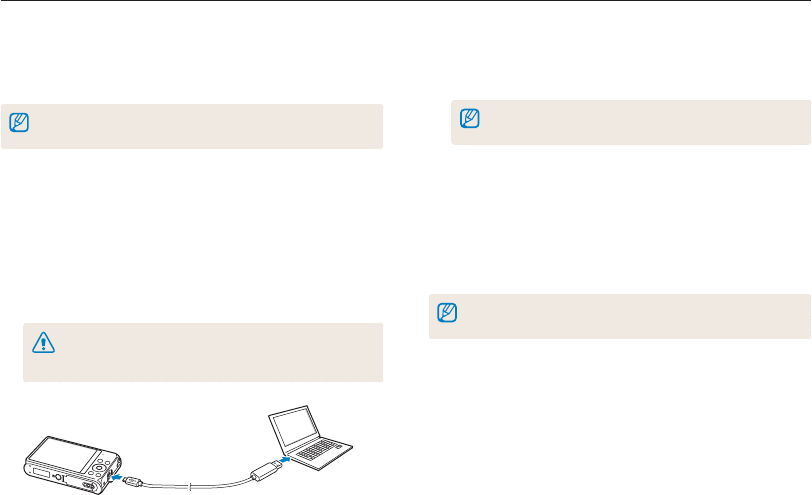
Playback/Editing
103
Transferring files to your Windows computer
5
Turn on the camera.
•
The computer recognizes the camera automatically and
Intelli-studio launches automatically.
If you set the USB option to Select, select Computer in the pop-up
window.
6
Select a destination folder on your computer, and then
select Yes.
•
New files stored on the camera will automatically transfer to
the selected folder.
•
If your camera has no new files, the pop-up window for saving
new files will not appear.
For Windows Vista and Windows 7, select Run iStudio.exe from the Auto
Play window to start Intelli-studio.
Transferring files with Intelli-studio
Intelli-studio will start automatically when you connect the camera
to your computer with the USB cable.
The battery will charge while the camera is connected to a computer with the
USB cable.
1
In Shooting or Playback mode, press [
m
].
2
Select
n
PC Software On.
3
Turn off the camera.
4
Connect the camera to your computer with the USB
cable.
You must plug the small end of the USB cable into your camera. If the
cable is reversed, it may damage your files. The manufacturer is not
responsible for any loss of data.
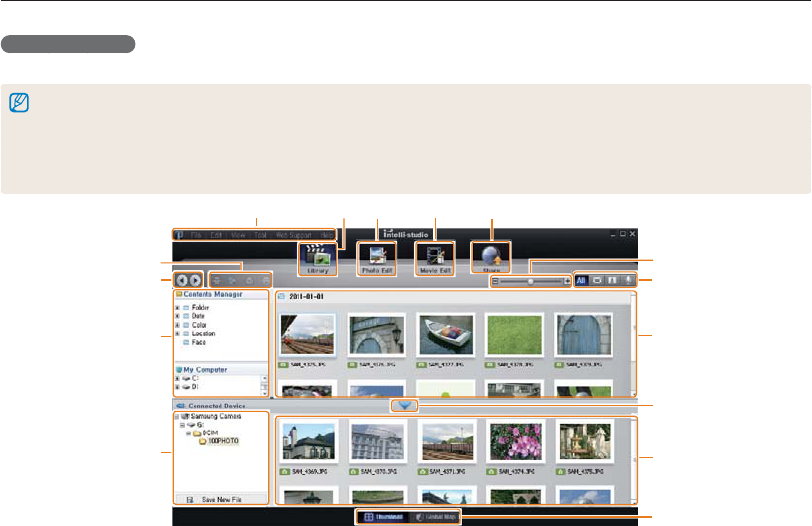
Playback/Editing
104
Transferring files to your Windows computer
Using Intelli-studio
Intelli-studio is a built-in program that allows you to play back and edit files. For details, select Help Help from the program toolbar.
•
You can update the firmware of your camera by selecting Web Support Upgrade firmware for the connected device from the program toolbar.
•
If you install Intelli-studio on your computer, the program will launch more quickly. To install the program, select Tool Install Intelli-studio on PC.
•
You cannot edit files directly on the camera. Transfer files to a folder on your computer before editing.
•
Intelli-studio supports the following formats:
- Videos: MP4 (Video: H.264, Audio: AAC), WMV (WMV 7/8/9), AVI (MJPEG)
- Photos: JPG, GIF, BMP, PNG, TIFF
543
6
9
0
!
8
:
@
#
$
12
7
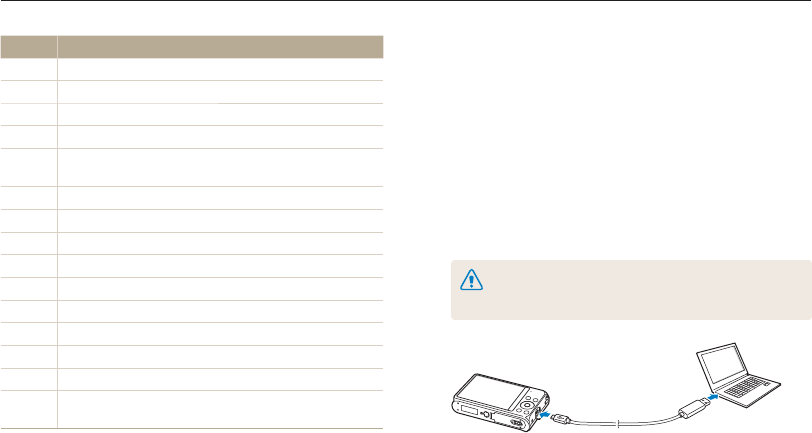
Playback/Editing
105
Transferring files to your Windows computer
No. Description
1
Open menus.
2
Display files in the selected folder.
3
Switch to the Photo edit mode.
4
Switch to the Video edit mode.
5
Switch to the Sharing mode (to send files by email or
upload files to websites, such as Flickr or YouTube).
6
Enlarge or reduce the thumbnails in the list.
7
Select a file type.
8
View files in the selected folder on your computer.
9
Show or hide files on the connected camera.
0
View files in the selected folder on the camera.
!
View files as thumbnails or on a map.
@
Browse folders stored on the camera.
#
Browse folders stored on your computer.
$
Move to the previous or next folder.
:
Print files, view files on a map, store files in My Folder, or
register faces.
Transferring files by connecting the camera
as a removable disk
Connect the camera to your computer as a removable disk.
1
In Shooting or Playback mode, press [
m
].
2
Select
n
PC Software Off.
3
Turn off the camera.
4
Connect the camera to your computer with the USB
cable.
You must plug the small end of the USB cable into your camera. If the
cable is reversed, it may damage your files. The manufacturer is not
responsible for any loss of data.

Playback/Editing
106
Transferring files to your Windows computer
Disconnecting the camera (for Windows XP)
With Windows Vista and Windows 7, the methods for
disconnecting the camera are similar.
1
If the status lamp on your camera is blinking, wait until
it stops.
2
Click on the tool bar at the bottom right of your
computer screen.
3
Click the pop-up message.
4
Click the message box that indicates the camera can be
removed safely.
5
Remove the USB cable.
The camera may not disconnect safely while Intelli-studio is running. End the
program before disconnecting the camera.
5
Turn on the camera.
•
The computer recognizes the camera automatically.
If you set the USB option to Select, select Computer in the pop-up
window.
6
On your computer, select My Computer
Removable Disk DCIM 100PHOTO.
7
Drag or save files to your computer.
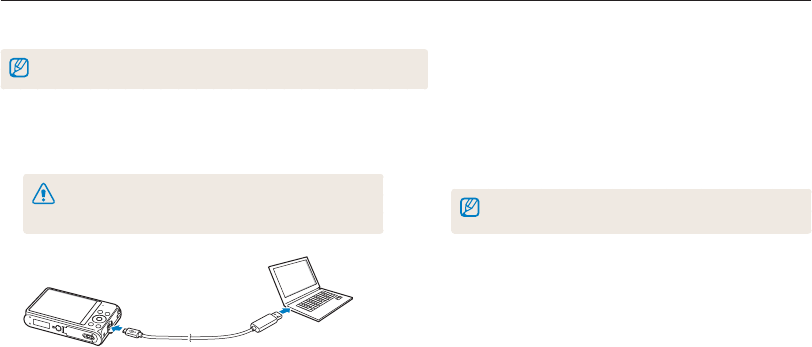
Playback/Editing
107
Transferring files to your Mac computer
When you connect the camera to a Macintosh computer, the computer will automatically recognize the device. You can transfer files directly
from the camera to the computer without installing any programs.
Mac OS 10.4 or later is supported.
2
Turn on the camera.
•
The computer recognizes the camera automatically and
displays a removable disk icon.
If you set the USB option to Select, select Computer in the pop-up
window.
3
Double-click the removable disk icon.
4
Drag or save files to your computer.
1
Connect your camera to a Macintosh computer with the
USB cable.
You must plug the small end of the USB cable into your camera. If the
cable is reversed, it may damage your files. The manufacturer is not
responsible for any loss of data.
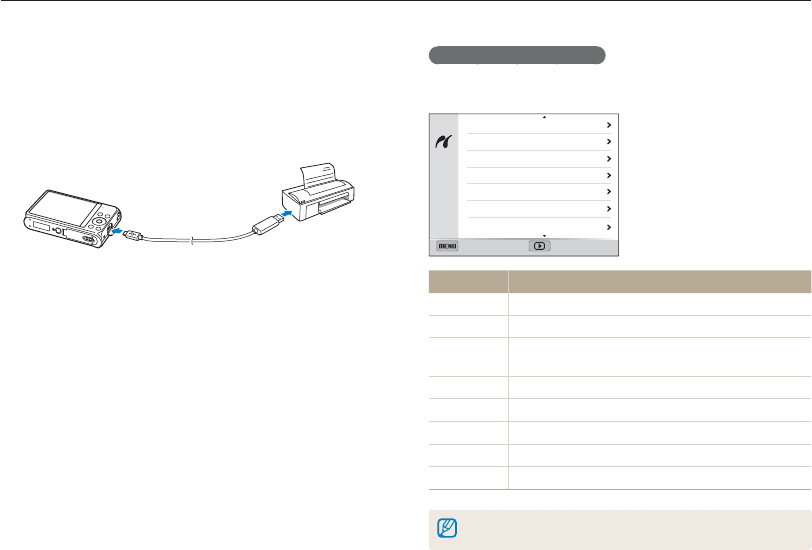
Playback/Editing
108
Printing photos with a PictBridge photo printer
Print photos with a PictBridge-compatible printer by connecting your camera directly to the printer.
Configuring print settings
Press [
m
] to configure print settings.
Images
Size
Layout
Type
Quality
Date
File Name
One Photo
Auto
Auto
Auto
Auto
Auto
Auto
Exit Print
Option Description
Images Select whether to print the current photo or all photos.
Size Set the print size.
Layout Set the number of photos to be printed on a single
sheet of paper.
Type Set the type of paper.
Quality Set the print quality.
Date Set to print the date.
File Name Set to print the file name.
Reset Reset settings to their default values.
Some options may not be supported by some printers.
1
In Shooting or Playback mode, press [
m
].
2
Select
n
USB Printer.
3
Turn on the printer, and then connect your camera to the
printer with the USB cable.
4
If the camera is off, press [POWER] or [
P
] to turn it on.
•
The printer recognizes the camera automatically.
5
Press [
F
/
t
] to select a file to print.
•
Press [
m
] to set printing options.
See “Configuring print settings.”
6
Press [
o
] to print.
•
Printing starts. Press [
F
] to cancel printing.

Connecting to a WLAN and configuring
network settings
………………………… 110
Connecting to a WLAN
………………… 110
Setting network options
……………… 111
Manually setting the IP address
……… 111
Network connection tips
……………… 112
Sending photos via email
……………… 113
Changing email settings
……………… 113
Sending photos via email
……………… 115
Entering text
…………………………… 116
Using photo or video
sharing websites
………………………… 117
Accessing a website
…………………… 117
Uploading photos or videos
…………… 117
Using a smart phone as a
remote shutter release
………………… 118
Viewing photos or videos on a
AllShare-enabled TV
…………………… 120
Viewing photos or videos on a TV I
…… 120
Viewing photos or videos on a TV II
…… 122
Sending or receiving photos or
videos with another camera
…………… 123
Sending photos or videos to
another camera
………………………… 123
Receiving photos or videos
from another camera
…………………… 123
Using Auto Backup to send
photos or videos
………………………… 125
Installing the program for
Auto Backup on your PC
……………… 125
Sending photos or videos to a PC
…… 125
Sending photos or videos to a
Blu-ray disc Player
……………………… 126
About the Wakeup on
LAN (WOL) feature
……………………… 127
Wireless network
Learn to connect to wireless local area networks (WLANs) and use functions.
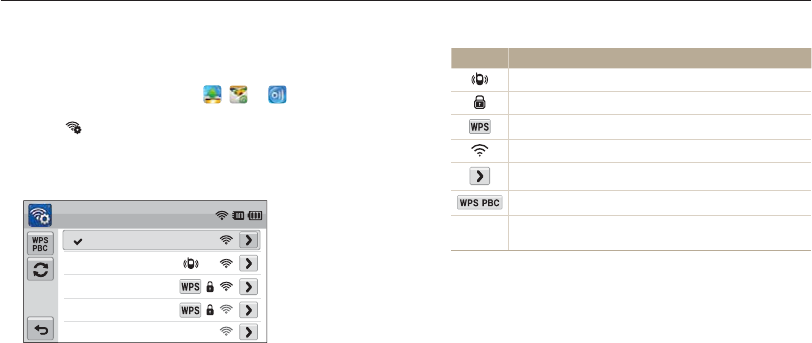
Wireless network
110
Connecting to a WLAN and configuring network settings
Learn to connect via an access point (AP) when you are in a range of a WLAN. You can also configure network settings.
Icon Description
Ad hoc AP
Secured AP
WPS AP
Signal strength
AP setting options
Connecting WPS AP
Refreshing connectable APs
•
When you select a secured AP, a pop-up window appears.
Input the required passwords to connect to the WLAN
(for information about entering text, refer to page 114).
•
When you select an unsecured AP, the camera will connect
to the WLAN.
•
If you select a WPS profile supported AP, touch WPS PIN,
and then enter a PIN on the AP device. You can also connect
to a WPS profile supported AP by touching WPS PBC on the
camera, and then pressing WPS button on the AP device.
Connecting to a WLAN
1
On the Home screen, touch , or .
2
Touch .
•
The camera automatically searches for available AP devices.
3
Touch an AP.
AP Setting
Samsung 2
Samsung 1
Samsung 3
Samsung 4
Samsung 5
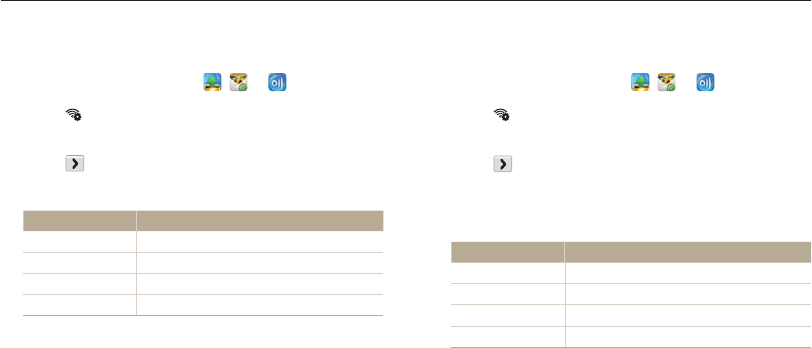
Wireless network
111
Connecting to a WLAN and configuring network settings
Manually setting the IP address
1
On the Home screen, touch , or .
2
Touch .
•
The camera automatically searches for available AP devices.
3
Touch next to an AP to change settings.
4
Touch IP Setting Manual.
5
Touch each option and enter the required information.
Option Description
IP Enter the static IP address.
Subnet Mask Enter the subnet mask.
Gateway Enter the gateway.
DNS Server Enter the DNS address.
6
Touch
o
to save your changes.
Setting network options
1
On the Home screen, touch , or .
2
Touch .
•
The camera automatically searches for available AP devices.
3
Touch next to an AP.
4
Touch each option and enter the required information.
Option Description
Authentication Select a network authentication type.
Data Encryption Select an encryption type.
Network Key Enter the network key.
IP Setting Set the IP address manually.
5
When you are finished, touch
o
.

Wireless network
112
Connecting to a WLAN and configuring network settings
• You can use only free WLANs with your camera. If you use free
WLANs that require a user agreement and additional information
when you connect to a web browser, some features may be
limited when connecting to websites or sending email.
• Available network connections may differ by country.
• The WLAN feature of your camera must comply with radio
transmission laws in your region. To ensure compliance, use
the WLAN feature only in the country where you purchased the
camera.
• For network profiles and a password, contact your network
administrator or network service provider.
• The process for adjusting network settings may differ,
depending on network conditions.
• Do not access a network that you are not authorized to use.
• Before you connect to a network, ensure your battery is fully
charged.
• When a DHCP server is not available you must make an autoip.
txt file and copy it to the inserted memory card to connect to
the network using Auto IP.
Network connection tips
• The quality of the network connection will be determined by
the AP.
• The further the distance between your camera and the AP, the
longer it will take to connect to the network.
• If a nearby device is using the same radio frequency signal as
your camera, it may interrupt your connection.
• If your AP name is not in English, the camera may not be able
to locate the device or the name may appear incorrectly.
• For network settings or a password, contact your network
administrator or network service provider.
• If a WLAN requires authentication from the service provider,
you may not be able to connect to it. To connect the WLAN,
contact your network service provider.
• Depending on the encryption type, the number of digits in the
password may differ.
• A WLAN connection may not be possible in all surroundings.
• The camera may display a WLAN-enabled printer may be
shown on the AP lists. However, you cannot connect to the
network via a printer.
• You cannot connect your camera to a network and a TV
simultaneously. Also, you cannot view photos or videos on a TV
while connected to a network.
• Connecting to a network may incur additional charges. Costs
will vary based on the conditions of your contract.
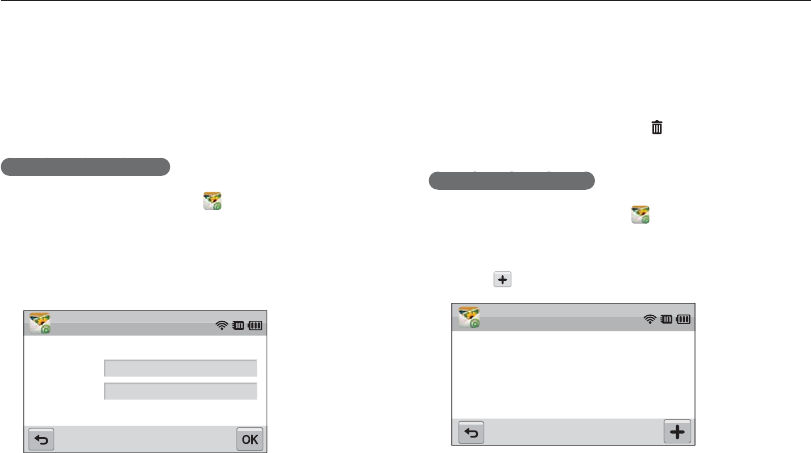
Wireless network
113
Sending photos via email
You can change settings in the email menu, and send photos stored on the camera via email.
4
Touch the Email box, input your email address, and then
touch
o
.
5
Touch
o
to save your changes.
•
To delete your information, touch .
Saving email addresses
1
On the Home screen, touch .
2
Touch
m
Email Address.
3
Touch to open the email address.
Email Address Book
Changing email settings
In the email menu, you can change settings for storing your
information or saving email addresses. You can also set or
change the email password. See p. 114 for information about
entering text.
Storing your information
1
On the Home screen, touch .
2
Touch
m
User Setting.
3
Touch the Name box, input your name, and then touch
o
.
Name
Email
User Setting
Touch
Touch

Wireless network
114
Sending photos via email
4
Touch the Name box, input a name, and then touch
o
.
5
Touch the Email box, input an email address, and then
touch
o
.
6
Touch
o
to save the new email address.
•
Touch to add an address.
•
Touch to delete the address from the list.
Setting an email password
1
On the Home screen, touch .
2
Touch
m
, and then touch the setting button
next to Setting Password.
3
When the pop-up appears, touch Confirm.
4
Enter a 4-digits password.
5
Enter the password again.
6
When the pop-up appears, touch Confirm.
Changing the email password
1
On the Home screen, touch .
2
Touch
m
Change Password.
3
Enter your current 4-digit password.
4
Enter a new 4-digit password.
5
Enter the new password again.
6
When the pop-up appears, touch Confirm.
If you do not want to use a password to access email options, touch the
setting button next to Setting Password to deactivate it.

Wireless network
115
Sending photos via email
4
Touch
o
.
5
Select photos to send, and then touch
o
.
•
You can select up to 20 photos. The total size must be
10 MB or less.
6
Touch the Text box, input your comments, and then
touch
o
.
•
For information about entering text, refer to page 114.
7
Touch Send to connect to the network and send the
photos.
•
The camera will automatically attempt to connect to a WLAN
via the most recently connected AP device and send the
photo.
•
If the camera has not previously been connected to a WLAN,
it will search for available AP devices. (p. 108)
Sending photos via email
You can send photos stored on the camera via email.
See p. 114 for information about entering text.
1
On the Home screen, touch .
2
Touch the Sender box, input your email address, and
then touch
o
.
•
If you have previously saved your information, it will be inserted
automatically. (p. 111)
3
Touch the Receiver box, input an email address, and
then touch
o
.
•
Touch to use an address from your address book. (p. 111)
•
Touch the Touch box to add additional recipients. You can
input up to 10 recipients.
•
Touch to delete an address from the list.
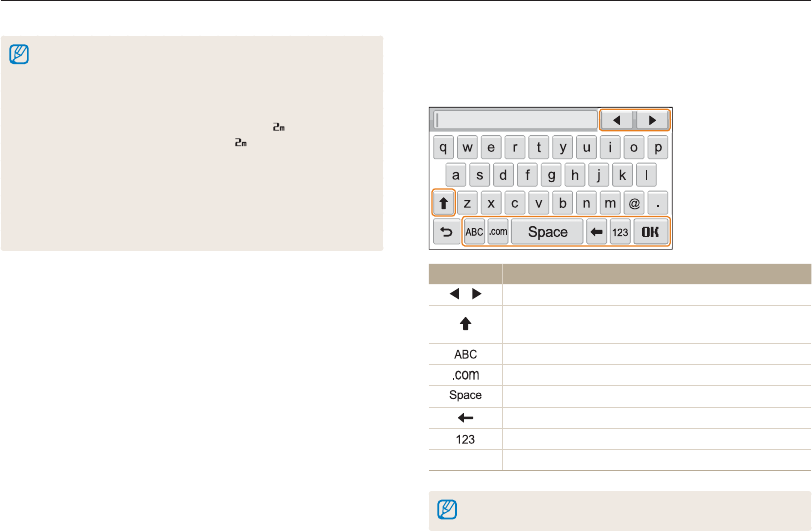
Wireless network
116
Sending photos via email
Entering text
Learn how to enter text. The icons in the table below let you move
the cursor, change the case, etc.
Text Input
Icon Description
Move the cursor.
In ABC mode, change the case.
In 123 mode, view more symbols.
Switch to ABC mode.
Enter ".com".
Enter a space.
Delete the last letter.
Switch to 123 mode.
o
Save the displayed text.
You can enter only English alphabets, regardless of the display language.
•
You may not be able to send an email if no network connection is
available or if your email account settings are incorrect.
•
The camera will display the Transfer completed. message, even
when the photos cannot be sent or will be recognized as spam due to
an error with the recipient’s email account.
•
The maximum photo resolution you can send is . If you select a
photo with resolution that is higher than , it will be automatically
resized.
•
If you cannot send an email because of firewall or user authentication
settings, contact your network administrator or network service
provider.
•
When there are no photos in the camera memory, you cannot use
this feature.
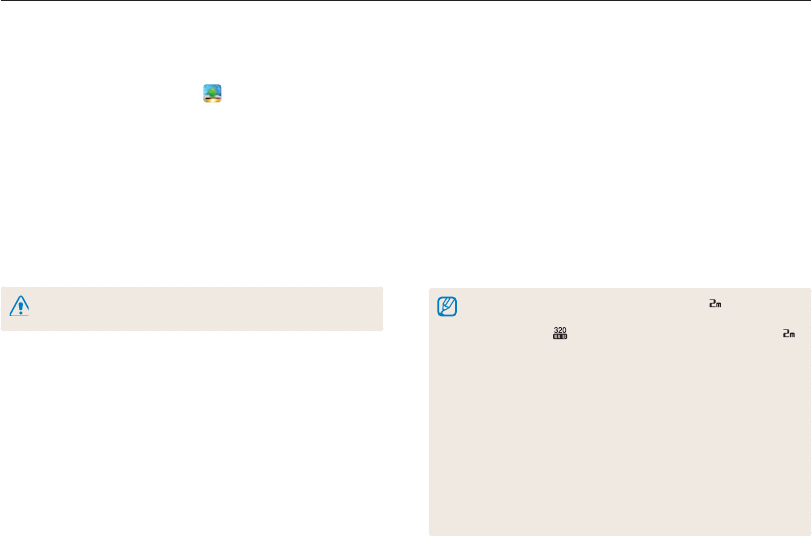
Wireless network
117
Using photo or video sharing websites
Upload your photos or videos to file sharing websites. Available websites will be displayed on your camera.
Uploading photos or videos
1
Access the website with your camera, and then touch
Upload.
2
Select files to upload from the list, and then touch
o
.
•
You can select up to 20 photos and the total size must be
10 MB or less.
3
Touch the Comment box, input your comments, and
then touch
o
.
4
Touch Upload.
•
The maximum photo resolution you can upload is , and the longest
video you can upload is 30 seconds at 320 resolution or a video
recorded using . If the selected photo resolution is higher than ,
it will be automatically resized to a lower resolution.
•
The method of uploading photos or videos may differ depending on
the selected website.
•
If you cannot access a website because of firewall or user
authentication settings, contact your network administrator or network
service provider.
•
If you are unable to upload photos or videos due to server errors,
touch Retry.
•
Uploaded photos or videos may be automatically titled with the date
they were captured.
•
The speed of your internet connection may affect how quickly photos
upload or web pages open.
Accessing a website
1
On the Home screen, touch .
2
Select a website.
•
The camera will automatically attempt to connect to a WLAN
via the most recently connected AP device.
•
If the camera has not previously been connected to a WLAN,
it will search for available AP devices. (p. 108)
3
Input your ID and password, and then touch Login.
•
You may be logged in automatically, if you have previously
logged in to the website.
You must have an existing account on the file sharing website to use this
feature.
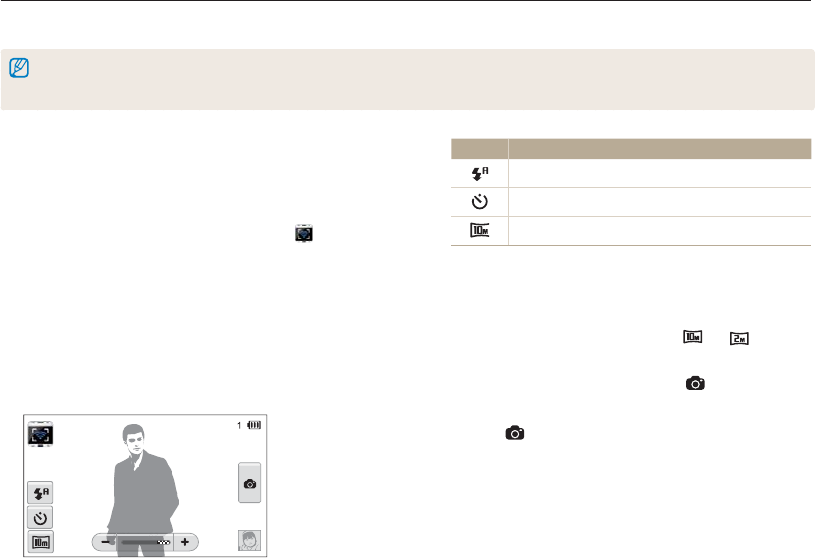
Wireless network
118
Using a smart phone as a remote shutter release
The camera connects to a smart phone via a WLAN. Use the smart phone as a remote shutter release with the Remote Viewfinder feature.
The captured photo will display on the smart phone.
•
This feature is supported only by Galaxy S smart phones with the Android 2.2 OS or higher. If your smart phone uses the Android 2.1 OS, upgrade your smart phone
to Android 2.2. This feature is also supported by 7 inch. Galaxy Tab and iPhone 4 with the iOS 4.3.
•
You can download the application from Samsung Apps, Android market, or Apple App Store.
Icon Description
Flash option
Timer option
Photo size
•
While using this feature, only the touch screen and [POWER]
are available on your camera.
•
The zoom button and the shutter button on your smart phone
will not function when using this feature.
•
Remote Viewfinder mode supports the and photo
sizes only.
5
On the smart phone, touch and hold to focus.
•
The focus is automatically set to multi-AF.
6
Release to capture the photo.
•
The photo will be saved in your camera.
•
Touch the photo in the bottom right corner of the screen to
save it to the smart phone. The photo will be resized to
VGA (640x480) size.
1
On your smart phone, turn on the Remote Viewfinder
application.
•
If you are using an iPhone, activate Personal Hotspot before
using the application.
2
On the Home screen of the camera, touch .
3
Select your smart phone from the list of available devices
found by the camera.
•
If the smart phone connected to the camera recently, it will
reconnect to the camera automatically.
•
You can choose only one camera at a time.
•
If you are using an iPhone, enter your password.
4
On the smart phone, set the following shooting options.

Wireless network
119
Using a smart phone as a remote shutter release
•
When you use this feature, the ideal distance between the camera
and the smart phone may vary, depending on your surroundings.
•
The smart phone must be within 30 ft/10 m of the camera to use
this feature.
•
It will take some time to capture the photo after you release on the
smart phone.
•
The Remote Viewfinder function will deactivate when:
- there is an incoming call on the smart phone
- either of the camera or the smart phone turn off
- memory is full
- either device loses connection to the WLAN
- the Wi-Fi connection is poor or unstable
•
To rotate the scene by rotating the smart phone, turn on the rotation
feature on your smart phone.
•
When you take a self image shot, the display will show a reflected
image, just like a mirror.
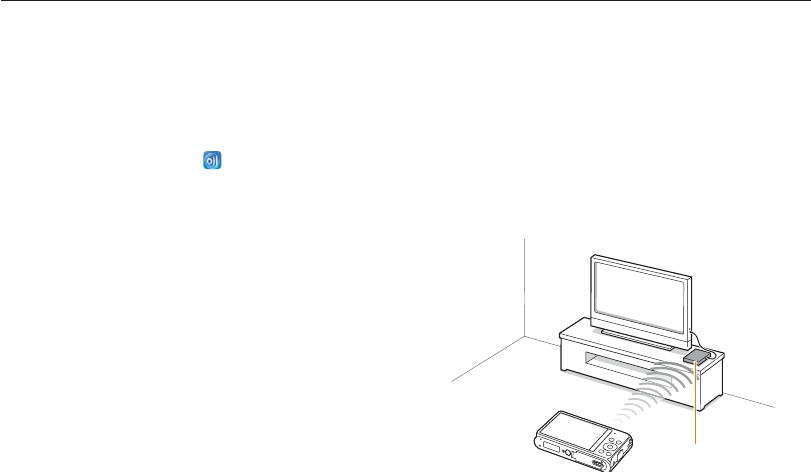
Wireless network
120
Viewing photos or videos on a AllShare-enabled TV
AllShare is an international technology standard for sharing media files between networked devices in your home. With this technology, you
can view your photos or videos on a widescreen TV. You cannot send or receive voice memos.
4
On the TV, search for the camera and browse the shared
photos or videos.
•
For information about searching for the camera and browsing
the photos or videos on the TV, refer to the TV user manual.
•
Videos may not play smoothly depending on the type of TV
or network condition. (p. 55) If this happens, re-record the
video in 640 or 320 quality and play it again. If videos do not
play smoothly on your TV over the wireless connection, try
connecting the camera to the TV with an A/V cable.
AP
Viewing photos or videos on a TV I
View your photos or videos on a TV that supports the AllShare
function. Your camera acts as a server and you can search for
shared photos or videos with the TV remote control.
1
On the Home screen, touch .
2
Touch Broadcast files.
•
The camera will automatically attempt to connect to a WLAN
via the most recently connected AP device.
•
If the camera has not previously been connected to a WLAN,
it wil search for available AP devices. (p. 108)
•
To store your camera's name, in AllShare mode, touch
m
Device Name, and then input a name by touching the
Device Name box.
3
Connect your TV to a wireless network via an AP device.
•
Refer to your TV’s user manual for more information.

Wireless network
121
Viewing photos or videos on a AllShare-enabled TV
•
You can share up to 1,000 photos.
•
On a TV screen, you can view only photos or videos captured with
your camera.
•
The range of the wireless connection between your camera and a TV
may vary depending on the specifications of the AP.
•
If the camera is connected to 2 TVs, playback may be slower.
•
Photos will be shared according to the size you set.
•
Videos will be shared in their original sizes.
•
You can use this feature only with AllShare-enabled TVs.
•
Shared photos or videos will not be stored on the TV, but they can be
stored according to the TV specifications.
•
Transferring photos or videos to the TV may take some time
depending on the network connection, the number of files to be
shared, or sizes of the files.
•
If you power off the camera abnormally while viewing photos or videos
on a TV (for example, by removing the battery), the TV considers the
camera to still be connected.
•
The order of photos or videos on the camera may be different than
on the TV.
•
Depending on the number of photos or videos you want to share, it
may take some time to load your photos or videos and complete the
initial set-up process.
•
While viewing photos or videos on the TV, continuously using the TV
remote or performing additional operations on the TV may prevent this
feature from working properly.
•
If you reorder or sort files on the camera while viewing them on a TV,
you must repeat the initial set-up process to update the list of files
on the TV.
•
When there are no photos or videos in the camera memory, you
cannot use this feature.

Wireless network
122
Viewing photos or videos on a AllShare-enabled TV
•
When searching for AllShare-enabled devices in the area, the camera
may not list all available devices.
•
If you power off the TV abnormally while viewing photos or videos on a
TV, the camera considers the TV to still be connected.
•
Photos will be shared according to the size you set.
•
Videos will be shared in their original sizes.
•
You can use this feature only with AllShare-enabled TVs.
•
Shared photos or videos will not be stored on the TV, but they can be
stored according to the TV specifications.
•
Transferring photos or videos to the TV may take some time
depending on the network connection, the number of files to be
shared, or sizes of the files.
•
You can transfer files one by one.
•
When there are no photos or videos in the camera memory, you
cannot use this feature.
•
On a TV screen, you can view only photos or videos captured with
your camera.
•
Network conditions will affect how long the camera searches for
devices. If the search takes an unusually long time, try reconnecting
the camera to the network.
Viewing photos or videos on a TV II
View your photos or videos on a TV that supports the AllShare
function. The TV acts as a display device and you can search
photos or videos via the camera.
1
On the Home screen, touch .
2
Touch Send files.
•
The camera will automatically attempt to connect to a WLAN
via the most recently connected AP device.
•
If the camera has not previously been connected to a WLAN,
it will search for available AP devices. (p. 108)
3
Connect your TV to the wireless network via an AP
device and activate AllShare.
•
Refer to your TV's user manual for more information.
4
On your camera, select photos or videos to view.
5
From the list on your camera, select the TV to use for
displaying files.
•
The camera will transfer the files. Touch Cancel to stop the
transfer.

Wireless network
123
Sending or receiving photos or videos with another camera
Learn to send or receive photos or videos to or from Samsung cameras that support network connections. You cannot send or receive
voice memos.
Receiving photos or videos from another
camera
1
On the Home screen, touch .
2
On the sending camera, activate the camera to camera
function.
3
On the sending camera, select Send, and then on your
camera, touch Receive.
4
Select the sending camera from the list of available
devices.
5
Enter the 4-digit password displayed on the sending
camera.
6
On the sending camera, send photos or videos.
•
Your camera will receive the files from the sending camera.
Sending photos or videos to another camera
1
On the Home screen, touch .
2
Touch Send.
•
The camera generates a password and displays it on the
screen while waiting to make a connection with the receiving
camera.
•
To store your camera's name, in Camera to Camera mode,
touch
m
Device Name, and then input a name by
touching the Device Name box.
3
On the receiving camera, activate the camera to camera
function, and then select Receive.
4
On the receiving camera, select your camera from the
list of available devices.
5
On the receiving camera, enter the 4-digit password
displayed on your camera in step 2.
•
When the connection is made, the selection area
automatically appears on the sending camera.
6
Select photos or videos to send, and then touch .
•
The camera will send the files.

Wireless network
124
Sending or receiving photos or videos with another camera
•
This feature uses an ad hoc wireless network.
•
If you most recently used your camera to receive files, you must end
the connection and reassign your camera as the sender to send files.
•
The range of the wireless connection between two cameras may vary,
depending on the conditions of the wireless ad hoc network.
•
If you power off the camera abnormally while sending or receiving
photos or videos, the other camera considers the camera to still be
connected.
•
Cameras will be disconnected after some time.
•
Transferring photos or videos to the device may take some time
depending on the network connection and the file size.
•
If you fail to receive or send a photo or video, it will not be saved on
the receiving camera.
•
If no photos have been stored on the camera, you cannot use this
feature.
•
You can send and receive photos or videos taken with your camera.
•
Photos larger than will automatically be resized.
•
The maximum video file size you can send or receive is 35 MB.

Wireless network
125
Using Auto Backup to send photos or videos
You can send photos or videos that you captured with the camera to a PC or Blu-ray disc player wirelessly. Before sending files to your PC,
connect the camera to the PC with the USB cable, so that the camera can store information about the PC. The Auto Backup feature works
only with the Windows OS.
3
Select options, and then touch Confirm.
•
The camera will prepare to connect to the network and send
files.
4
The camera will send files.
•
You cannot select individual files to send. This function is
available only for newly stored files on the camera.
•
The progress will be shown on the PC monitor.
•
If the PC supports the Wake on LAN(WOL) feature, you can turn
on the PC automatically by searching for the PC from your camera.
(p.125)
•
When you connect the camera to the WLAN, select the AP that is
connected to the PC.
•
The camera will search for available access points even if you are
connecting to the same access point again.
•
If you turn off the camera or remove the battery while sending files, the
file transfer will be interrupted.
•
While you are using this feature, the buttons on the camera will be
disabled.
•
You can connect only one camera to the PC at a time for sending
files.
•
The backup may be canceled due to network conditions.
•
Photos or videos can be sent to a PC or Blu-ray player one time only.
Files cannot be sent again even if you reconnect your camera.
Installing the program for Auto Backup on
your PC
1
Connect the camera to the PC with the USB cable.
2
Turn on the camera.
•
The computer recognizes the camera and Intelli-studio
launches automatically.
3
When the pop-up appears, click
o
.
•
The program will be installed automatically.
•
Before install program, ensure that the PC is connected to a network.
If no internet connection is available, you must install the program from
the provided CD.
•
This program is for backing up files to the PC. You do not need a
program to send files to the Blu-ray disc player.
Sending photos or videos to a PC
1
On the Home screen of your camera, touch .
2
Touch Confirm.

Wireless network
126
Using Auto Backup to send photos or videos
•
Before you backup the files, connect the Blu-ray disc player to a
wired AP. Select Menu Settings Network Network Setting
to view the player’s IP allocation.
•
Even when you have set the Blu-ray player to be accessed by other
devices, you may be prompted to change the access setting again.
To set the access setting, refer to steps 4 – 5.
•
This feature works with Samsung Blu-ray players that support Auto
Backup.
•
The Auto Backup function cannot be used when the Blu-ray player is:
- playing back files or access to browser, in My Contents or My
Device menu
- upgrading the software
- recording files or time-shifting files (reservation recordings will
function normally during automatic backups.)
- formatting the player's hard disk or when you are testing the device
or its capabilities
Sending photos or videos to a Blu-ray disc
Player
You can send photos from your camera to the Samsung Blu-ray
disc player that has an HDD.
1
On the Home screen, touch .
2
Touch to connect to the AP.
•
Select the AP that is connected to the Blu-ray player.
3
Search for available devices, and then select your Blu-
ray player.
4
When the camera is connected to the Blu-ray player and
a pop-up appears on the player's display, select Allow.
5
On the Blu-ray player, select Menu Settings
Network AllShare Server Management Device
Access Control your camera. Then, set the Blu-ray
player to be accessible by other devices.
•
The Blu-ray player will remember the most recent access
settings. If the connection conditions are the same as the last
connection, the camera will automatically access the Blu-ray
player.
6
Touch Confirm to send files.
•
Transferred files will be stored on the hard disk of the Blu-ray
player.

Wireless network
127
About the Wakeup on LAN (WOL) feature
With the WOL feature, you can automatically turn on or wake up a PC with your camera. This feature has been available for Samsung
desktop PCs for the last 5 years (not available for all-in-one PCs).
Setting the PC to wake up from sleep mode
1
Click Start, and then open the Control Panel.
2
Configure the network connection.
•
Windows 7:
Click Network and Internet Network and Sharing
Center Change adapter settings.
•
Windows Vista:
Click Network and Internet Network and Sharing
Center Manage network connections.
•
Windows XP:
Click Network and Internet Connection Network
Connection.
3
Right click Local Area, and then click Properties.
4
Click Configure the Power manage tab Allow this
device to wake the computer.
5
Click
o
.
6
Restart the PC.
Setting the PC to turn on
1
Turn on the PC and press F2 while the PC is booting.
•
The BIOS setting menu will appear.
2
Select Advanced tab Power management Setup.
3
Select Resume on PME Enabled.
4
Press F10 to save your changes and continue booting.
5
Click Start, and then open the Control Panel.
6
Configure the network connection.
•
Windows 7:
Click Network and Internet Network and Sharing
Center Change adapter settings.
•
Windows Vista:
Click Network and Internet Network and Sharing
Center Manage network connections.
•
Windows XP:
Click Network and Internet Connection Network
Connection.
7
Select drivers related to network adapter.
8
Click Advanced tab and then set WOL menus.

Wireless network
128
About the Wakeup on LAN (WOL) feature
•
You cannot use this feature across a firewall or if a security program has
been installed.
•
To turn on the PC with the WOL feature, the PC must have an active
connection to the LAN. Ensure that the indicator light on the PC’s
LAN port is on, which shows that the LAN connection is active.
•
Depending on your PC model, the camera may only be able to wake
the PC.
•
Depending on your PC’s OS or drivers, the names of the WOL setting
menu may vary.
- examples of setting menu names : Enable PME, Wake on LAN etc.
- examples of setting menu values : Enable, Magic packet etc.
Any changes to your PC’s BIOS settings other than the ones described below
may damage your PC. The manufacturer is not responsible for damage caused
by your changing your PC’s BIOS settings.

Settings menu
………………………………………… 130
Accessing the settings menu
……………………… 130
Sound
……………………………………………… 131
Display
……………………………………………… 131
Settings
……………………………………………… 132
Settings
Refer to options to configure your camera’s settings.
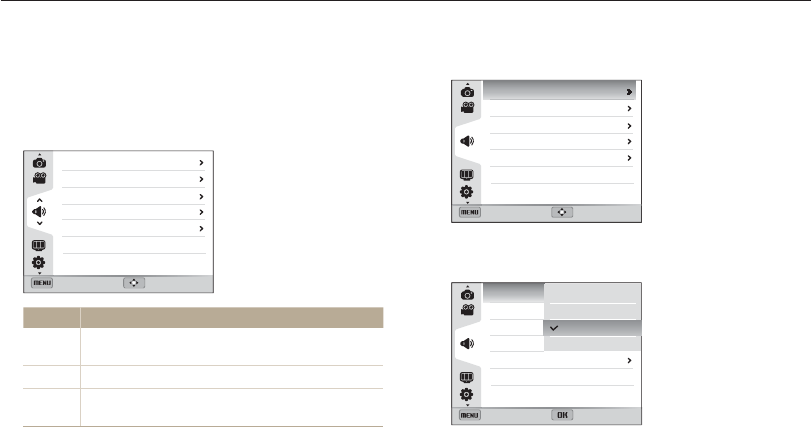
Settings
130
Settings menu
Learn to configure your camera's settings.
3
Select an item.
Exit Move
Medium
Off
On
On
On
Volume
Start Sound
Shutter Sound
Beep Sound
AF Sound
4
Select an option.
Back Set
Volume
Start Sound
Shutter Sound
Beep Sound
AF Sound
Off
Low
Medium
High
On
5
Press [
m
] to return to the previous screen.
Accessing the settings menu
1
In Shooting or Playback mode, press [
m
].
2
Select a menu.
Exit Move
Medium
Off
On
On
On
Volume
Start Sound
Shutter Sound
Beep Sound
AF Sound
Option Description
U
Sound: Set various camera sounds and the volume.
(p. 112)
Y
Display: Customize the display settings. (p. 112)
n
Settings: Customize the settings for the camera
system. (p. 113)

Settings
131
Settings menu
Sound
* Default
Item Description
Volume Set the volume of all sounds.
(Off, Low, Medium*, High)
Start Sound Set to emit a sound when you turn on your
camera. (Off*, On)
Shutter Sound Set to emit a sound when you press the shutter
button. (Off, On*)
Beep Sound Set to emit a sound when you press the buttons
or switch modes. (Off, On*)
AF Sound Set to emit a sound when you half-press the
shutter button. (Off, On*)
Display
* Default
Item Description
Function
Description
Display a brief description of an option a menu.
(Off, On*)
Grid Line Select a guide to help you compose a scene.
(Off*, 3 X 3, 2 X 2, Cross, Diagonal)
Date/Time
Display
Set whether or not to display the date and time on
the camera's display. (Off*, On)
Display
Brightness
Adjust the brightness of the screen.
(Auto*, Dark, Normal, Bright)
Normal is fixed in Playback mode even if you have
selected Auto.
Quick View
Set the duration for reviewing a captured image
before returning to the Shooting mode.
(Off, 0.5 sec*, 1 sec, 3 sec)
Power Save
If you perform no operations for 30 seconds, the
camera automatically switches to Power save
mode. (Off*, On)
•
In Power save mode, press any button other
than [POWER] to resume using the camera.
•
Even if you do not set the Power save mode,
the screen will dim 30 seconds after the last
operation to save power.

Settings
132
Settings menu
Settings
* Default
Item Description
Language Set a language for the display text.
Time Zone
Set the time zone for your location. When you
travel to another country, select Visit, and then
select the appropriate time zone. (Home*, Visit)
Date/Time Set Set the date and time.
Date Type
Set a date format. (YYYY/MM/DD*,
MM/DD/YYYY, DD/MM/YYYY)
The default date type may differ depending on the
language selected.
* Default
Item Description
File No.
Specify how to name files.
•
Reset: Set the file number to start from 0001
when you insert a new memory card, format a
memory card, or delete all files.
•
Series*: Set the file number to resume from
the previous file number when you insert a new
memory card, format a memory card, or delete
all files.
•
The default name of the first folder is 100PHOTO
and the default name of the first file is
SAM_0001.
•
The file number increases one at a time from
SAM_0001 to SAM_9999.
•
The folder number increases one at a time from
100PHOTO to 999PHOTO.
•
The maximum number of files that can be stored
in one folder is 1,000.
•
The camera defines file names according to
the Design rule for Camera File system (DCF)
standard. If you intentionally change file names,
the camera may not play back the files.

Settings
133
Settings menu
* Default
Item Description
Imprint
Set whether or not to display the date and time on
captured photos. (Off*, Date, Date & Time)
•
The date and time will be displayed on the
bottom right corner of the photo.
•
Some printer models may not print the date and
time properly.
•
The camera will not display the date and time if:
- you select Text in
s
mode
- you select Panorama mode
Auto Power Off
Set the camera to automatically turn off when you
perform no operations for a specified period.
(Off, 1 min, 3 min*, 5 min, 10 min)
•
Your settings will not change when you replace
the battery.
•
The camera will not automatically turn off when
the camera is connected to a computer or printer,
and when you are playing a slide show or videos.
AF Lamp Set a light to automatically turn on in dark places
to help you focus. (Off, On*)
* Default
Item Description
Format
Format the internal memory and the memory card.
Formatting will delete all files, including protected
files. (No, Yes)
Errors can occur if you use a memory card formatted by
another brand of camera, a memory card reader, or a
computer. Please format memory cards in the camera
before using them to capture photos.
Reset
Reset menus and shooting options. Date and
time, language, and video output settings will not
be reset. (No, Yes)
Anynet+ (HDMI-
CEC)
Turn on to control the camera with a TV remote
control when you connect it to an HDTV that
supports the Anynet+(CEC) profile.
•
Off: View files without using an HDTV remote
control.
•
On*: Control the camera with an HDTV remote
control.

Settings
134
Settings menu
* Default
Item Description
HDMI Size
Set the resolution of photos when the camera
plays back files on an HDTV via the HDMI cable.
(NTSC: 1080i*, 720p, 480p/
PAL: 1080i*, 720p, 576p)
•
If the HDTV does not support the selected
resolution, the HDTV automatically selects the
next lower resolution.
•
If you select 480p or 576p, the playback menus
and Smart Album will not be available when you
connect the camera to a TV.
Video Out
Set the video signal output for your region.
•
NTSC: USA, Canada, Japan, Korea, Taiwan,
Mexico
•
PAL (supports only BDGHI): Australia, Austria,
Belgium, China, Denmark, England, Finland,
Germany, Italy, Kuwait, Malaysia, Netherlands,
New Zealand, Norway, Singapore, Spain,
Sweden, Switzerland, Thailand
* Default
Item Description
USB
Select the mode to use when you connect the
camera to a computer or printer with a USB cable.
•
Select: Manually select the USB mode when
you connect your camera to a device.
•
Computer*: Connect your camera to a
computer for transferring files.
•
Printer: Connect your camera to a printer for
printing files.
PC Software Set Intelli-studio to launch automatically when you
connect your camera to your computer. (Off, On*)

Error messages
……………………………………… 136
Camera maintenance
………………………………… 137
Cleaning your camera
……………………………… 137
Using or storing the camera
………………………… 138
About memory cards
……………………………… 139
About the battery
…………………………………… 142
Before contacting a service center
………………… 146
Camera specifications
……………………………… 149
Glossary
……………………………………………… 153
FCC notice
…………………………………………… 158
Index
…………………………………………………… 159
Appendixes
Get information about error messages, specifications, and
maintenance.
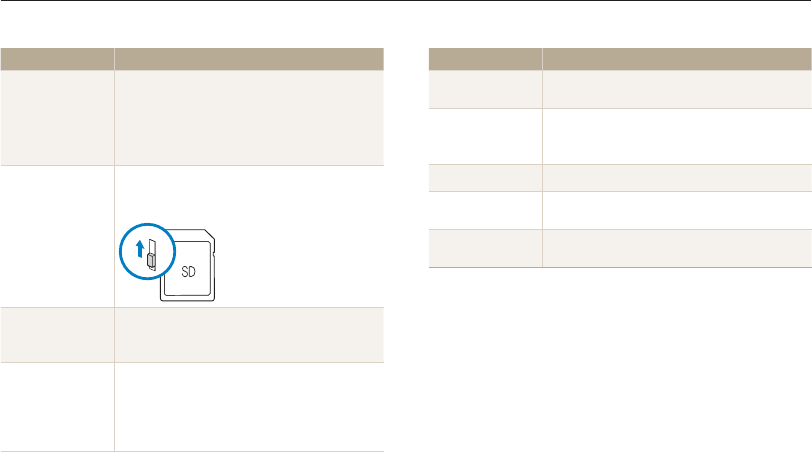
Appendixes
136
Error messages
When the following error messages appear, try these remedies.
Error message Suggested remedies
File Error Delete the damaged file or contact a service
center.
File system not
supported.
Your camera does not support the FAT file
structure of the inserted memory card. Format
the memory card on the camera.
Low Battery Insert a charged battery or recharge the battery.
Memory Full Delete unnecessary files or insert a new memory
card.
No Image File Capture photos or insert a memory card that
contains some photos.
Error message Suggested remedies
Card Error
•
Turn off your camera, and then turn it on
again.
•
Remove your memory card, and then insert
it again.
•
Format your memory card.
Card Locked
You can lock an SD, SDHC, or SDXC card to
prevent files from being deleted. Unlock the card
when shooting.
Card not
supported.
The inserted memory card is not supported
by your camera. Insert a SD, SDHC, or SDXC
memory card.
DCF Full Error
File names do not match the DCF standard.
Transfer the files from the memory card to your
computer and format the card. Then, open the
Settings menu and select File No. Reset.
(p. 113)
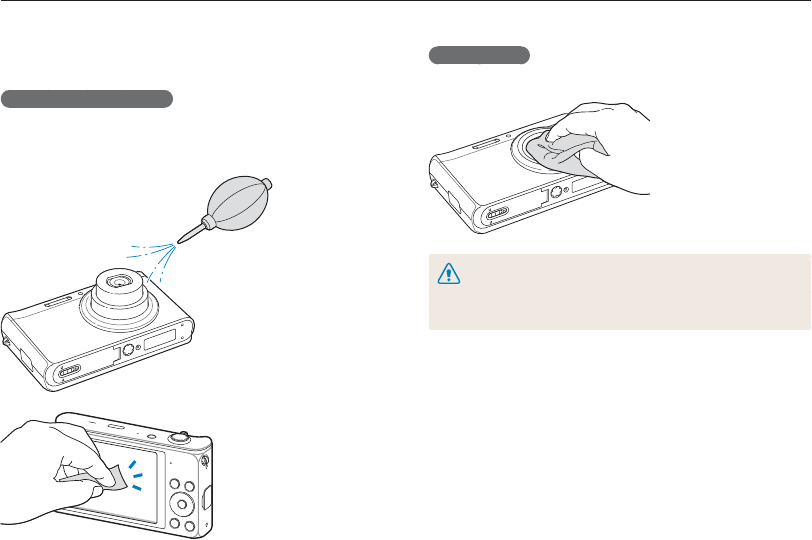
Appendixes
137
Camera maintenance
Camera body
Wipe gently with a soft, dry cloth.
•
Never use benzene, thinners, or alcohol to clean the device. These
solutions can damage the camera or cause it to malfunction.
•
Do not press on the lens cover or use a blower brush on the lens
cover.
Cleaning your camera
Camera lens and display
Use a blower brush to remove dust and wipe the lens gently with
a soft cloth. If any dust remains, apply lens cleaning liquid to a
piece of lens cleaning paper and wipe gently.

Appendixes
138
Camera maintenance
Using on beaches or shores
• Protect your camera from sand and dirt when you use it on
beaches or in similar areas.
• Your camera is not waterproof. Do not handle the battery,
adapter, or memory card with wet hands. Operating the camera
with wet hands may cause damage to your camera.
Storing for extended period of time
• When you store the camera for an extended period, place it in a
sealed container with an absorbent material, such as silica gel.
• Remove the batteries from your camera when storing it for an
extended period. Installed batteries may leak or corrode over
time and cause serious damage to your camera.
• Over time, unused batteries will discharge and must be
recharged before use.
Using the camera with caution in humid environments
When you transfer the camera from a cold environment to a warm
one, condensation can form on the lens or internal components
of the camera. In this situation, turn off the camera and wait for at
least 1 hour. If condensation forms on the memory card, remove
the memory card from the camera and wait until all moisture has
evaporated before reinserting it.
Using or storing the camera
Inappropriate places to use or store the camera
• Avoid exposing the camera to very cold or very hot
temperatures.
• Avoid using your camera in areas with extremely high humidity,
or where the humidity changes drastically.
• Avoid exposing the camera to direct sunlight and storing it in
hot, poorly-ventilated areas, such as in a car during summer
time.
• Protect your camera and the display from impact, rough
handling, and excessive vibration to avoid serious damage.
• Avoid using or storing your camera in dusty, dirty, humid, or
poorly-ventilated areas to prevent damage to moving parts and
internal components.
• Do not use your camera near fuels, combustibles, or flammable
chemicals. Do not store or carry flammable liquids, gases, or
explosive materials in the same compartment as the camera or
its accessories.
• Do not store the camera where there are mothballs.

Appendixes
139
Camera maintenance
• Paint or metal on the outside of the camera may cause
allergies, itchy skin, eczema, or swelling for people with
sensitive skin. If you experience any of these symptoms, stop
using the camera immediately and consult a doctor.
• Do not insert foreign objects into any of your camera’s
compartments, slots, or access points. Damage due to
improper use may not be covered by your warranty.
• Do not allow unqualified personnel to service the camera or
attempt to service the camera yourself. Any damage that results
from unqualified service is not covered by your warranty.
About memory cards
Supported memory cards
Your camera supports SD, SDHC, or SDXC memory cards.
Terminal
Write-protect switch
Label (front)
You can prevent files from being deleted by using the
write-protect switch on an SD, SDHC, or SDXC card. Slide the
switch down to lock or slide it up to unlock. Unlock the card
when capturing photos and videos.
Other cautions
• Do not swing your camera by the strap. This may cause injury
to yourself or others or damage to your camera.
• Do not paint your camera, as paint can clog moving parts and
prevent proper operation.
• Turn off the camera when not using it.
• Your camera contains delicate parts. Avoid impacts to the
camera.
• Protect the display from external force by keeping it in the case
when not in use. Protect the camera from scratches by keeping
it away from sand, sharp implements, or loose change.
• Do not expose the lens to direct sunlight, as this may discolor
the image sensor or cause it to malfunction.
• Protect the lens from fingerprints and scratches. Clean the lens
with a soft, clean, debris-free lens cloth.
• The camera may turn off if struck or dropped. This is to protect
the memory card. Turn on the camera to use it again.
• While you use the camera, it may heat up. This is normal and
should not affect your camera’s lifespan or performance.
• When you use the camera in low temperatures, it may take
some time to turn on, the color of the display may be changed
temporarily, or after-images may appear. These conditions are
not malfunctions and they will correct themselves when the
camera is returned to milder temperatures.
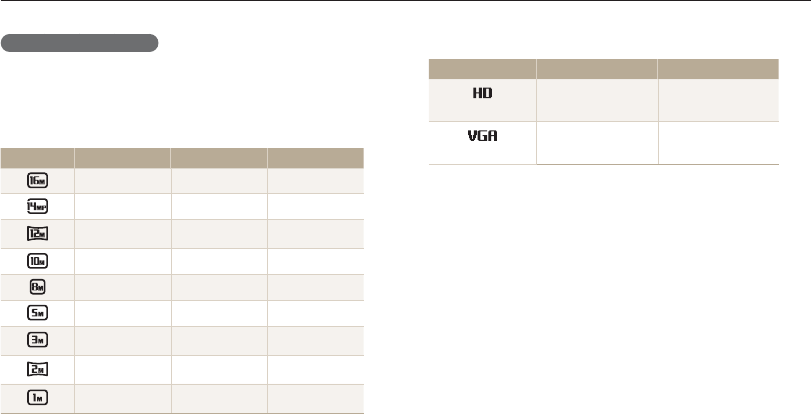
Appendixes
140
Camera maintenance
Memory card capacity
The memory capacity may differ depending on shooting scenes
or shooting conditions. These capacities are based on a 1 GB
SD card:
Photo
Size Super Fine Fine Normal
XXX XXX XXX
XXX XXX XXX
XXX XXX XXX
XXX XXX XXX
XXX XXX XXX
XXX XXX XXX
XXX XXX XXX
XXX XXX XXX
XXX XXX XXX
Video
Size 30fps 15fps
1280X720
Approx.
XX' XX'' -
640X480
Approx.
XX' XX'' -
* The figures above are measured without using the zoom function. Available
recording time may vary if you use the zoom. Several videos were recorded
in succession to determine the total recording time.

Appendixes
141
Camera maintenance
• Prevent memory cards from making contact with liquids, dirt, or
foreign substances. If dirty, wipe the memory card clean with a
soft cloth before you insert the memory card in your camera.
• Do not allow liquids, dirt, or foreign substances to come in
contact with memory cards or the memory card slot. Doing so
may cause memory cards or the camera to malfunction.
• When you carry a memory card, use a case to protect the card
from electrostatic discharges.
• Transfer important data to other media, such as a hard disk,
CD, or DVD.
• When you use the camera for an extended period, the memory
card may become warm. This is normal and does not indicate
a malfunction.
The manufacturer is not responsible for any loss of data.
Cautions when using memory cards
• Avoid exposing memory cards to very cold or very hot
temperatures (below 0 ºC/32 ºF or above 40 ºC/104 ºF).
Extreme temperatures can cause memory cards to malfunction.
• Insert a memory card in the correct direction. Inserting a
memory card in the wrong direction may damage your camera
and memory card.
• Do not use memory cards that have been formatted by other
cameras or by a computer. Reformat the memory card with
your camera.
• Turn off the camera when you insert or remove the memory
card.
• Do not remove the memory card or turn off your camera while
the lamp is blinking, as this may damage your data.
• When the lifespan of a memory card has expired, you cannot
store any more photos on the card. Use a new memory card.
• Do not bend, drop, or subject memory cards to heavy impact
or pressure.
• Avoid using or storing memory cards near strong magnetic
fields.
• Avoid using or keeping memory cards in areas with high
temperature, high humidity, or corrosive substances.

Appendixes
142
Camera maintenance
Battery life
Average shooting time/
Number of photos
Test conditions (when the battery is fully
charged)
Photos
Approximately
XXX min/
Approximately
XXX photos
The battery life was measured under
the following conditions: in
p
mode, in
darkness, resolution, Fine quality,
OIS on.
1. Set the flash option to Fill in, take a
single shot, and zoom in or out.
2. Set the flash option to Off, take a
single shot, and zoom in or out.
3. Perform steps 1 and 2, waiting
30 seconds between each step.
Repeat the process for 5 minutes,
and then turn off the camera for
1 minute.
4. Repeat steps 1 to 3.
Videos Approximately
XXX min
Record videos at resolution and
30 FPS.
•
The figures above are measured by Samsung’s standards. Your results may
differ, depending on your actual usage.
•
Several videos were recorded in succession to determine the total recording
time.
•
When using network functions, the battery will be depleted more quickly.
About the battery
Use only Samsung-approved batteries.
Battery specifications
Specification Description
Model BP88
Type Lithium-ion battery
Cell capacity 880 mAh
Voltage 3.7 V
Charging time* (when the camera is
switched off) Approximately 150 min
* Charging the battery by connecting it to a computer may take longer.

Appendixes
143
Camera maintenance
Cautions about using the battery
Protect batteries, chargers, and memory cards from
damage
Prevent batteries from making contact with metal objects, as this
can create a connection between the + and – terminals of your
battery and lead to temporary or permanent battery damage and
may cause a fire or electric shock.
Notes about charging the battery
• If the indicator light is off, make sure that the battery is inserted
correctly.
• If the camera is on while charging, the battery may not fully
charge. Turn off the camera before charging the battery.
• Do not use your camera when you charge the battery. This may
cause a fire or electric shock.
• Do not pull the power supply cord to disconnect the plug from
the power outlet, as this may cause a fire or electric shock.
• Let the battery charge for at least 10 minutes before turning on
the camera.
• If you connect the camera to an external power source while
the battery is depleted, using some high energy-consuming
functions will cause the camera to turn off. To use the camera
normally, recharge the battery.
Low battery message
When the battery has fully discharged, the battery icon will turn
red and the "Low Battery" message will appear.
Notes about using the battery
• Avoid exposing batteries to very cold or very hot temperatures
(below 0 ºC/32 ºF or above 40 ºC/104 ºF). Extreme
temperatures can reduce the charging capacity of your
batteries.
• When you use the camera for an extended period, the area
around the battery chamber may become warm. This does not
affect the normal use of the camera.
• Do not pull the power supply cord to disconnect the plug from
the power outlet, as this may cause a fire or electric shock.
• In temperatures below 0 ºC/32 ºF, battery capacity and battery
life may decrease.
• Battery capacity may decrease in low temperatures but will
return to normal in milder temperatures.

Appendixes
144
Camera maintenance
• Using the flash or recording videos depletes the battery quickly.
Charge the battery until the red indicator light turns off.
• If the indicator light does not illuminate, reconnect the cable, or
remove the battery and insert it again.
• Overcharging batteries may shorten battery life. After charging is
finished, disconnect the cable from your camera.
• Do not bend or place heavy objects on the AC cable. Doing so
may damage the cable.
Notes about charging with a computer connected
• Use only the provided USB cable.
• The battery may not charge when:
-
you use a USB hub
-
other USB devices are connected to your computer
-
you connect the cable to the port on the front side of your
computer
-
the USB port of your computer does not support the power output
standard (5 V, 500 mA)
Handling and disposing of batteries and chargers
with care
• Never dispose of batteries in a fire. Follow all local regulations
when you dispose of used batteries.
• Never place batteries or cameras on or in heating devices,
such as microwave ovens, stoves, or radiators. Batteries may
explode when they are overheated.

Appendixes
145
Camera maintenance
Personal injury or death can occur if the battery is
handled carelessly or improperly. For your safety,
follow these instructions for proper battery handling:
•
The battery can ignite or explode if not handled properly. If
you notice any deformities, cracks, or other abnormalities
in the battery, immediately discontinue use of the battery
and contact a service center.
•
Use only authentic, manufacturer-recommend battery
chargers and adapters and charge the battery only by the
methods described in this user manual.
•
Do not place the battery near heating devices or expose
it to excessively warm environments, such as the inside
of an enclosed car in the summertime.
•
Do not place the battery in a microwave oven.
•
Avoid storing or using the battery in hot, humid places,
such as spas or shower enclosures.
•
Do not rest the device on flammable surfaces, such as
bedding, carpets, or electric blankets for a prolonged
period.
•
When the device is switched on, do not leave it in any
confined space for a prolonged period.
•
Do not allow battery terminals to come in contact with
metallic objects, such as necklaces, coins, keys, or
watches.
•
Use only authentic, manufacturer-recommended, Lithium-
ion replacement batteries.
•
Do not disassemble or puncture the battery with any
sharp object.
•
Avoid exposing the battery to high pressure or crushing
forces.
•
Avoid exposing the battery to major impacts, such as
dropping it from high places.
•
Do not expose the battery to temperatures of 60 °C
(140 °F) or above.
•
Do not allow the battery to come in contact with moisture
or liquids.
•
Do not expose the battery to sources of excessive heat
such as sunshine, fire or the like.
Disposal guidelines
•
Dispose of the battery with care.
•
Do not dispose of the battery in a fire.
•
Disposal regulations may differ by country or region.
Dispose of the battery in accordance with all local and
federal regulations.
Guidelines for charging the battery
Charge the battery only by the method described in
this user manual. The battery can ignite or explode if
not charged properly.

Appendixes
146
Before contacting a service center
If you are having trouble with your camera, try these troubleshooting procedures before you contact a service center. If you have attempted
the suggested remedy and are still having problems with your device, contact your local dealer or service center.
When you leave your camera at a service center, be sure to also leave the other components that may have contributed to the malfunction, such as the memory card and battery.
Situation Suggested remedies
Cannot capture photos
•
There is no space on the memory card.
Delete unnecessary files or insert a new
card.
•
Format the memory card.
•
The memory card is defective. Get a new
memory card.
•
Make sure that the camera is switched
on.
•
Charge the battery.
•
Make sure that the battery is inserted
correctly.
The camera freezes Remove the battery and insert it again.
The camera heats up
While you use the camera, it may heat up.
This is normal and should not affect your
camera’s lifespan or performance.
The flash does not
work
•
The flash option may be set to Off.
(p. 60)
•
You cannot use the flash in some modes.
Situation Suggested remedies
Cannot turn on the
camera
•
Ensure that the battery is inserted.
•
Ensure that the battery is inserted
correctly. (p. 17)
•
Charge the battery.
The power turns off
suddenly
•
Charge the battery.
•
Your camera may be in Power save
mode. (p. 112)
•
The camera may turn off to prevent the
memory card from being damaged due
to an impact. Turn on your camera again.
The camera is losing
battery power quickly
•
The battery may lose power more quickly
in low temperatures (below 0 °C/32 ºF).
Keep the battery warm by putting it into
your pocket.
•
Using the flash or recording videos
depletes the battery quickly. Recharge
if needed.
•
Batteries are consumable parts that must
be replaced over time. Get a new battery
if the battery life is diminishing quickly.

Appendixes
147
Before contacting a service center
Situation Suggested remedies
The flash fires
unexpectedly
The flash may fire due to static electricity.
The camera is not malfunctioning.
The date and time are
incorrect
Set the date and time in the display settings.
(p. 113)
The display or buttons
do not work Remove the battery, and then insert it again.
The camera display
responds poorly
If you use your camera at very low
temperatures, it may cause the camera
screen to malfunction or discolor. For better
performance of your camera screen, use
your camera in moderate temperatures.
The memory card has
an error
•
Turn off your camera, and then turn it
on again.
•
Remove your memory card, and then
insert it again.
•
Format your memory card.
See “Cautions when using memory cards”
for more detail. (p. 122)
Cannot play back files
If you change the name of a file, your
camera may not play the file (the name of
the file should meet the DCF standard). If
you encounter this situation, play back the
files on your computer.
Situation Suggested remedies
The photo is blurry
•
Make sure that the focus option you set
is suitable for close-up shots. (p. 63)
•
Make sure that the lens is clean. If not,
clean the lens. (p. 118)
•
Make sure that the subject is within range
of the flash. (p. 131)
The colors in the photo
do not match the actual
scene
An incorrect White Balance can create
unrealistic color. Select the proper White
Balance option to suit the light source.
(p. 74)
The photo is too bright
Your photo is overexposed.
•
Turn off the flash. (p. 60)
•
Adjust the ISO sensitivity. (p. 62)
•
Adjust the exposure value. (p. 72)
The photo is too dark
Your photo is underexposed.
•
Turn on the flash. (p. 60)
•
Adjust the ISO sensitivity. (p. 62)
•
Adjust the exposure value. (p. 72)

Appendixes
148
Before contacting a service center
Situation Suggested remedies
The TV does not
display your photos
•
Make sure that the camera is correctly
connected to the TV with the A/V cable.
•
Make sure that your memory card
contains photos.
Your computer does
not recognize your
camera
•
Make sure that the USB cable is
connected correctly.
•
Make sure that your camera is switched
on.
•
Make sure that you are using a supported
operating system.
Your computer
disconnects the
camera while
transferring files
The file transmission may be interrupted by
static electricity. Disconnect the USB cable
and connect it again.
Your computer cannot
play videos
Videos may not play on some video player
programs. To play video files captured with
your camera, install and use the Intelli-studio
program on your computer. (p. 104)
Situation Suggested remedies
Intelli-studio is not
functioning properly
•
End Intelli-studio and restart the program.
•
You cannot use Intelli-studio on
Macintosh computers.
•
Make sure that PC Software is set to
On in the settings menu. (p. 115)
•
Depending on your computer's
specifications and environment, the
program may not launch automatically. In
this case, click Start My Computer
Intelli-studio iStudio.exe on your
computer.
Your TV or computer
cannot display photos
and videos that are
stored on an SDXC
memory card.
SDXC memory cards use the exFAT file
system. Ensure that the external device is
compatible with the exFAT file system before
connecting the camera to the device.
Your computer does
not recognize an SDXC
memory card.
SDXC memory cards use the exFAT file
system. To use SDXC memory cards on
a Windows XP computer, download and
update the exFAT file system driver from the
Microsoft website.

Appendixes
149
Camera specifications
Range
Wide (W) Tele (T)
Normal (AF) 80 cm-infinity 100 cm-infinity
Macro 5-80 cm 100-infinity
Auto Macro 5 cm-infinity 100 cm-infinity
Shutter speed
•
Auto: 1/8-1/2,000 sec.
•
Program: 1-1/2,000 sec.
•
Night: 8-1/2,000 sec.
•
Firework: 2 sec.
Exposure
Control Program AE
Metering Multi, Spot, Center-weighted, Face Detection
Compensation ±2EV (1/3 EV Step)
ISO equivalent Auto, ISO 80, ISO 200, ISO 400, ISO 800,
ISO 1600, ISO 3200
Flash
Mode Auto, Red-eye, Fill in, Slow Sync, Off, Red-eye Fix
Range
•
Wide: 0.4-3.5 m (ISO Auto)
•
Tele: 0.2-2.0 m (ISO Auto)
Recharging time Approximately 4 sec.
Image sensor
Type 1/2.3" (Approximately 7.76 mm) CCD
Effective pixels Approximately 16.0 mega-pixels
Total pixels Approximately 16.4 mega-pixels
Lens
Focal length Samsung Lens f = 4.5-22.5 mm
(35 mm film equivalent: 25-125 mm)
F-stop range F2.5 (W)-F6.3 (T)
Zoom
•
Still image mode: 1.0-5.0X
(Optical zoom X Digital zoom: 25.0X,
Optical zoom X Intelli zoom: 10.0X)
•
Playback mode: 1.0-XX.XX (depending on image
size)
Display
Type TFT LCD
Feature 3.0" (7.62 cm) 460K
Focusing
Type TTL auto focus (Center AF, Multi AF, Face Detection
AF, Tracking AF)

Appendixes
150
Camera specifications
Shake reduction
DUAL IS [Optical Image Stabilization (OIS) + Digital Image Stabilization (DIS)]
Effect
Photo Shooting
mode
•
Smart Filter: Normal, Miniature, Vignetting,
Soft Focus, Old Film, Half Tone Dot, Sketch,
Fish-eye, Classic, Retro, Oil Painting, Cartoon,
Ink Painting, Cross Filter, Zooming Shot
•
Image Adjust: Contrast, Sharpness, Saturation
Video Shooting
mode
Smart Filter: Normal, Palette Effect 1, Palette Effect 2,
Palette Effect 3, Palette Effect 4, Miniature, Vignetting,
Half Tone Dot, Sketch, Fish-eye, Classic, Retro
White Balance
Auto WB, Daylight, Cloudy, Fluorescent_H, Fluorescent_L, Tungsten,
Custom Set, Color Temp.
Date Imprinting
Date & Time, Date, Off
Shooting
Photos
•
Modes: Smart Auto (Portrait, Night Portrait,
Backlight Portrait, Night, Backlight, Landscape,
White, Natural Green, Blue Sky, Sunset, Macro,
Macro text, Macro Color, Tripod, Action, Fireworks),
Program, Aperture Priority, Shutter Priority, Manual,
Scene (Panorama, PIP Shot, Split Shot, Magic
Frame, Beauty Shot, Night, Landscape, Text,
Sunset, Dawn, Backlight, Beach & Snow, Zooming
Shot), Apps
•
Burst: Single, Continuous, Motion Capture, AEB
•
Timer: 2 Sec, 10 Sec, Double (2 Sec, 10 Sec)
Videos
•
Modes: Smart Scene Detection (Landscape,
Blue Sky, Natural Green, Sunset), Movie
•
Format: MP4 (H.264) (Max recording time: 20 min)
•
Size: 1280X720, 640X480
•
Frame Rate: 30fps, 15fps (only in some Smart
Filter options)
•
Sound Alive: Sound Alive On, Sound Alive Off,
Mute
•
OIS: On, Off
•
Video editing (embedded): Pause during recording,
Still image capture

Appendixes
151
Camera specifications
Playback
Photos
•
Type: Single image, Thumbnails, Multi Slide Show
with Music and Effect, Movie clip, Smart Album*
* Smart Album category: Type, Date, Week, Face
•
Edit: Resize, Rotate, Image Adjust, Smart Filter, Trim
•
Effect: Image Adjust (Red-eye Fix, Face Retouch,
Brightness, Contrast, Saturation, Add Noise),
Smart Filter (Normal, Miniature, Vignetting,
Soft Focus, Old Film, Half Tone Dot, Sketch,
Fish-eye, Classic, Retro, Oil Painting, Cartoon,
Ink Painting, Cross Filter, Zooming Shot)
Videos Edit: Still image capture, Time trimming
Storage
Media
•
Internal memory: Approximately XX.X MB
•
External memory (Optional):
microSD card (1-2 GB guaranteed),
microSDHC card (up to 8 GB guaranteed))
Internal memory capacity may not match these
specifications.
File format
•
Still Image: JPEG (DCF), EXIF 2.21, DPOF 1.1,
PictBridge 1.0
•
Movie Clip: MP4 (Video: MPEG-4.AVC/H.264,
Audio: AAC)
Image size
For 1 GB microSD: Number of photos
Super Fine Fine Normal
4608 X 3456 XXX XXX XXX
4608 X 3072 XXX XXX XXX
4608 X 2592 XXX XXX XXX
3648 X 2736 XXX XXX XXX
2592 X 1944 XXX XXX XXX
1984 X 1488 XXX XXX XXX
1920 X 1080 XXX XXX XXX
1024 X 768 XXX XXX XXX
These figures are measured under Samsung’s
standard conditions. Your results may vary depending
on the shooting conditions and camera settings.
Interface
Digital output
connector USB 2.0
Audio input/output Internal speaker (Mono), Microphone (Mono)
Video output
•
A/V: NTSC, PAL (selectable)
•
HDMI 1.4: NTSC, PAL (selectable)
DC power input
connector 5.0 V

Appendixes
152
Camera specifications
Power source
Rechargeable
battery Lithium-ion battery (BP88, 880 mAh)
Connector type Micro USB (7 pin)
The power source may differ depending on your region.
Wireless network
Wi-Fi (IEEE 802.11 b/g/n), AllShare, Web Upload, Emailing, Camera to
Camera, AP Connection, Auto Backup, Remote Viewfinder
Dimensions (W X H X D)
XXX X XXX X XXX mm (without protrusions)
Weight
XXX.X g (without battery and memory card)
Operating Temperature
0-40 °C
Operating Humidity
5-85 %
Software
Intelli-studio
Specifications may change without notice to improve performance.

Appendixes
153
Glossary
DCF (Design rule for Camera File system)
A specification to define a file format and file system for digital
cameras created by the Japan Electronics and Information
Technology Industries Association (JEITA).
Depth of field
The distance between the nearest and farthest points that can
be acceptably focused in a photograph. Depth of field varies with
lens aperture, focal length, and distance from the camera to the
subject. Selecting a smaller aperture, for example, will increase
the depth of field and blur the background of a composition.
Digital zoom
A feature that artificially increases the amount of zoom available
with a zoom lens (Optical zoom). When using the Digital zoom,
the image quality will deteriorate as the magnification increases.
DPOF (Digital Print Order Format)
A format for writing printing information, such as selected images
and number of prints, on a memory card. DPOF-compatible
printers, sometimes available at photo shops, can read the
information from the card for convenient printing.
AEB (Auto Exposure Bracket)
This feature automatically captures several images at different
exposures to help you capture a properly-exposed image.
AF (Auto Focus)
A system that automatically focuses the camera lens on the
subject. Your camera uses the contrast to focus automatically.
Aperture
The aperture controls the amount of light that reaches the
camera’s sensor.
Camera shake (Blur)
If the camera is moved while the shutter is open, the entire image
may appear blurred. This occurs more often when the shutter
speed is slow. Prevent camera shake by raising the sensitivity,
using the flash, or using a faster shutter speed. Alternately, use a
tripod, the DIS or OIS function to stabilize the camera.
Composition
Composition in photography means arranging objects in a photo.
Usually, abiding by the rule of thirds leads to a good composition.

Appendixes
154
Glossary
Focal length
The distance from the middle of the lens to its focal point (in
millimeters). Longer focal lengths result in narrower angles of view
and the subject is magnified. Shorter focal lengths result in wider
angles of view.
Histogram
A graphical representation of the brightness of an image. The
horizontal axis represents the brightness and the vertical axis
represents the number of pixels. High points at the left (too dark)
and right (too bright) on the histogram indicate a photo that is
improperly exposed.
H.264/MPEG-4
A high-compression video format established by international
standard organizations ISO-IEC and ITU-T and developed by the
Joint Video Team (JVT). This codec is capable of providing good
video quality at low bit rates.
Image sensor
The physical part of a digital camera that contains a photosite for
each pixel in the image. Each photosite records the brightness of
the light that strikes it during an exposure. Common sensor types
are CCD (Charge-coupled Device) and CMOS (Complementary
Metal Oxide Semiconductor).
EV (Exposure Value)
All the combinations of the camera’s shutter speed and lens
aperture that result in the same exposure.
EV Compensation
This feature allows you to quickly adjust the exposure value
measured by the camera, in limited increments, to improve the
exposure of your photos. Set the EV compensation to -1.0 EV to
adjust the value one step darker and 1.0 EV to one step brighter.
Exif (Exchangeable Image File Format)
A specification to define an image file format for digital cameras
created by the Japan Electronic Industries Development
Association (JEIDA).
Exposure
The amount of light allowed to reach the camera’s sensor.
Exposure is controlled by a combination of the shutter speed, the
aperture value, and ISO sensitivity.
Flash
A speed light that helps to create adequate exposure in low-light
conditions.

Appendixes
155
Glossary
Metering
The metering refers to the way in which the camera measures the
quantity of light to set the exposure.
MJPEG (Motion JPEG)
A video format which is compressed as a JPEG image.
Noise
Misinterpreted pixels in a digital image that may appear as
misplaced or random, bright pixels. Noise usually occurs when
photos are shot with a high sensitivity or when a sensitivity is
automatically set in a dark place.
Optical zoom
This is a general zoom which can enlarge images with a lens and
does not deteriorate quality of images.
ISO sensitivity
The sensitivity of the camera to light, based on the equivalent film
speed used in a film camera. At higher ISO sensitivity settings,
the camera uses a higher shutter speed, which can reduce blur
caused by camera shake and low light. However, images with
high sensitivity are more susceptible to noise.
JPEG (Joint Photographic Experts Group)
A lossy method of compression for digital images. JPEG images
are compressed to reduce their overall file size with minimal
deterioration of the image resolution.
LCD (Liquid Crystal Display)
A visual display commonly used in consumer electronics. This
display needs a separate backlight, such as CCFL or LED, to
reproduce colors.
Macro
This feature allows you to capture close-up photos of very small
objects. When using the macro feature, the camera can maintain
a sharp focus on small objects at a near life-size ratio (1:1).

Appendixes
156
Glossary
Vignetting
A reduction of an image’s brightness or saturation at the periphery
(outer edges) compared to the center of the image. Vignetting
can draw interest to subjects positioned in the center of an
image.
White balance (color balance)
An adjustment of the intensities of colors (typically the primary
colors red, green, and blue), in an image. The goal of adjusting
the white balance, or color balance, is to correctly render the
colors in an image.
Quality
An expression of the rate of compression used in a digital image.
Higher quality images have a lower rate of compression, which
usually results in a larger file size.
Resolution
The number of pixels present in a digital image. High resolution
images contain more pixels and typically show more detail than
low resolution images.
Shutter speed
Shutter speed refers to the amount of time it takes to open and
close the shutter, and it is an important factor in the brightness of
a photo, as it controls the amount of light which passes through
the aperture before it reaches the image sensor. A fast shutter
speed allows less time to let light in and the photo becomes
darker and more easily freezes subjects in motion.
Smart zoom
Smart zoom lets you zoom in with less degradation of picture
quality than the optical zoom and digital zoom.

Appendixes
157
Correct Disposal of This Product
(Waste Electrical & Electronic Equipment)
(Applicable in the European Union and other European
countries with separate collection systems)
This marking on the product, accessories or literature indicates that
the product and its electronic accessories (e.g. charger, headset, USB
cable) should not be disposed of with other household waste at the
end of their working life. To prevent possible harm to the environment
or human health from uncontrolled waste disposal, please separate
these items from other types of waste and recycle them responsibly to
promote the sustainable reuse of material resources. Household users
should contact either the retailer where they purchased this product,
or their local government office, for details of where and how they can
take these items for environmentally safe recycling. Business users
should contact their supplier and check the terms and conditions of the
purchase contract. This product and its electronic accessories should
not be mixed with other commercial wastes for disposal.
PlanetFirst represents Samsung Electronics'
commitment to sustainable development and social
responsibility through eco-driven business and
management activities.
Correct disposal of batteries in this product
(Applicable in the European Union and other European
countries with separate battery return systems)
This marking on the battery, manual or packaging indicates that
the batteries in this product should not be disposed of with other
household waste at the end of their working life. Where marked, the
chemical symbols Hg, Cd or Pb indicate that the battery contains
mercury, cadmium or lead above the reference levels in EC Directive
2006/66. If batteries are not properly disposed of, these substances
can cause harm to human health or the environment.
To protect natural resources and to promote material reuse, please
separate batteries from other types of waste and recycle them through
your local, free battery return system.
This Class [B] digital apparatus complies with Canadian
ICES-003.
Dispose unwanted electronics through an approved recycler.
To find the nearest recycling location, go to our website:
www.samsung.com/recyclingdirect Or call, (877) 278 - 0799

Appendixes
158
FCC notice
•
NOTE:
This equipment has been tested and found to comply with the
limits for a Class B digital device, pursuant to part 15 of the
FCC Rules. These limits are designed to provide reasonable
protection against harmful interference in a residential installation.
This equipment generates, uses and can radiate radio
frequency energy and, if not installed and used in accordance
with the instructions, may cause harmful interference to radio
communications. However, there is no guarantee that interference
will not occur in a particular installation. If this equipment does
cause harmful interference to radio or television reception, which
can be determined by turning the equipment off and on, the user
is encouraged to try to correct the interference by one or more of
the following measures:
- Reorientate, or relocate, the receiving antenna.
- Increase the distance between the equipment and receiver.
- Connect the equipment into an outlet on a circuit different from
that to which the receiver is connected.
- Consult the dealer or an experienced radio / TV technician for
help.
•
CAUTION:
Changes or modifications not expressly approved by the
manufacturer responsible for compliance could void the user’s
authority to operate the equipment.
•
Declaration of Conformity
Trade Name : Samsung Electronics America, Inc.
Model No. : DV300F
Responsible Party : Samsung Electronics America, Inc.
Address : 85 Challenger Road, Ridgefield Park,
NJ 07660
Telephone No. : 1-800-SAMSUNG (726-7864)
This device complies with Part 15 of the FCC Rules.
Operation is subject to the following two conditions:
(1) This device may not cause harmful interference, and (2)
this device must accept any interference received, including
interference that may cause undesired operation.

Appendixes
159
IC notice
Operation is subject to the following two conditions:
(1) This device may not cause harmful interference, and
(2) This device must accept any interference received,
including interference that may cause undesired operation.
Le présent appareil est conforme aux CNR d'Industrie
Canada applicables aux appareils radio exempts de licence.
L'exploitation est autorisée aux deux conditions suivantes :
(1) l'appareil ne doit pas produire de brouillage, et
(2) l'utilisateur de l'appareil doit accepter tout brouillage
radioélectrique subi, même si le brouillage est susceptible
d'en compromettre le fonctionnement.
Caution:
Any changes or modifications to the equipment not expressly
approved by the party responsible for compliance could void
user’s authority to operate the equipment.
IC: 649E-DV300F

Appendixes
160
Index
A
AF-assist light
Location 15
Settings 135
AF Lamp 135
AF Sound 133
AllShare 122
Anynet+ 135
Aperture Priority mode 44
Aperture value 43
Auto Backup 127
A/V port 15
B
Battery
Caution 145
Charging 19
Inserting 18
Beauty Shot mode 40
Blink Detection 70
Brightness
Playback mode 99
Shooting mode 73
Burst modes
Bracket 79
High-speed 78
Precapture 79
C
Camera maintenance 139
Camera specifications 151
Capturing an image from
video 95
Charging 19
Cleaning
Camera body 139
Display 139
Lens 139
Connecting to a computer
Mac 109
Windows 104
Contrast
Playback mode 99
Shooting mode 83
D
Date/Time Set 134
Deleting files 90
Digital Print Order Format
(DOF) 99
Digital zoom 29
Disconnecting the
camera 108
Display brightness 133
Display type 26
DUAL IS mode 47
E
Editing photos 96
Editing videos
Capturing 95
Trimming 94
Enlarging 91
Error messages 138
Exposure 73
F
Face Detection 68
Flash
Auto 62
Fill in 62
Intensity 62
Off 61
Red-eye 62
Red-eye Fix 62
Slow Sync 62

Appendixes
160
Index
Focus area
Center AF 67
Multi AF 67
Selection AF 67
Tracking AF 67
Formatting 135
Function button 17
G
Grid Line 133
H
Half-press shutter 32
HDMI Size 136
HDR mode 38
HDTV 102
I
Icons
Playback mode 85
Shooting mode 22
Image Adjustment
Add Noise 99
Brightness
Playback mode 99
Shooting mode 73
Contrast
Playback mode 99
Shooting mode 83
Red-eye 98
Saturation
Playback mode 99
Shooting mode 83
Sharpness 83
Image quality 59
Imprint 135
Intelli-studio 106
ISO sensitivity 63
L
Language settings 134
M
Macro
Auto Macro 65
Macro 65
Manual Focus 65
Magic Frame mode 39
Manual mode 46
Memory card
Caution 143
Insert 18
Menu button 17
Metering
Center-weighted 74
Multi 74
Spot 74
Mode dial 16
Movie mode 51
My star
Cancelling 87
Ranking 86
Registering 71
O
Optical Image Stabilization
(OIS) 31
Optional accessories 14
P
Panorama
3D Panorama 48
Action Panorama 50
Live Panorama 48
PictBridge 110
Playback button 17
Playback mode 85
Power button 15
Power save mode 133
Printing photos 110
Program mode 42
Protecting files 89

Appendixes
162
T
Thumbnails 89
Timer
Shooting mode 60
Timer lamp 15
Time settings 20
Time zone settings 20, 134
Transferring files
Auto Backup 127
Camera to Camera 125
Email 115
Mac 109
Windows 104
Tripod mount 15
U
Unpacking 14
USB port 15
Shutter button 15
Shutter Priority mode 45
Slide show 93
Smart Album 88
Smart Auto mode 35
Smart Face Recognition 70
Smart Filter
Playback mode 97
Shooting mode 81
Smart Scene Detection
mode 54
Smart zoom 30
Smile Shot 69
Sound settings 27
Status lamp 16
S
Saturation
Playback mode 99
Shooting mode 83
Scene mode 37
Self portrait 69
Service center 148
Settings 134
Sharpness 83
Shooting portraits
Beauty Shot mode 40
Blink Detection 70
Face Detection 68
Red-eye 62
Red-eye fix 62
Self portrait 69
Smart Face Recognition 70
Smile Shot 69
Q
Quick view 133
R
Red-eye
Playback mode 98
Shooting mode 61
Remote Viewfinder 120
Reset 135
Resolution
Playback mode 96
Shooting mode 58
Retouching faces
Playback mode 98
Shooting mode 40
Rotating 96
Index

Appendixes
162
V
Video
Playback mode 94
Shooting mode 51
Video out 136
Viewing files
Folder 87
Slide show 93
Smart Album 88
Thumbnails 89
TV 101
W
Website
Accessing 119
Uploading photos or
videos 119
White Balance 75
Wireless network 112
Z
Zoom
Using the zoom 29
Zoom button 16
Zoom sound settings 51
Zooming Shot mode 41
3
3D Photo mode 38
3D TV 103
Index

Please refer to the warranty that came with your product or
visit our website www.samsung.com for after-sales service or
inquiries.